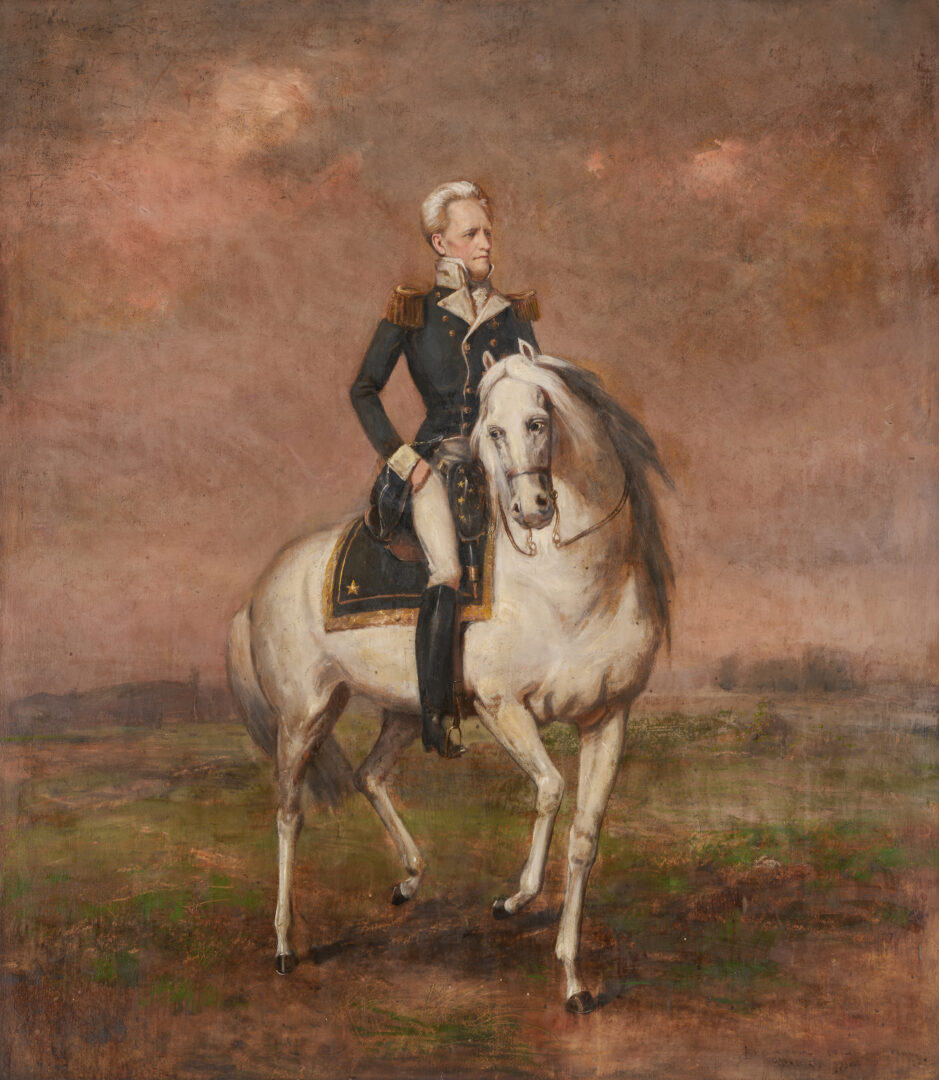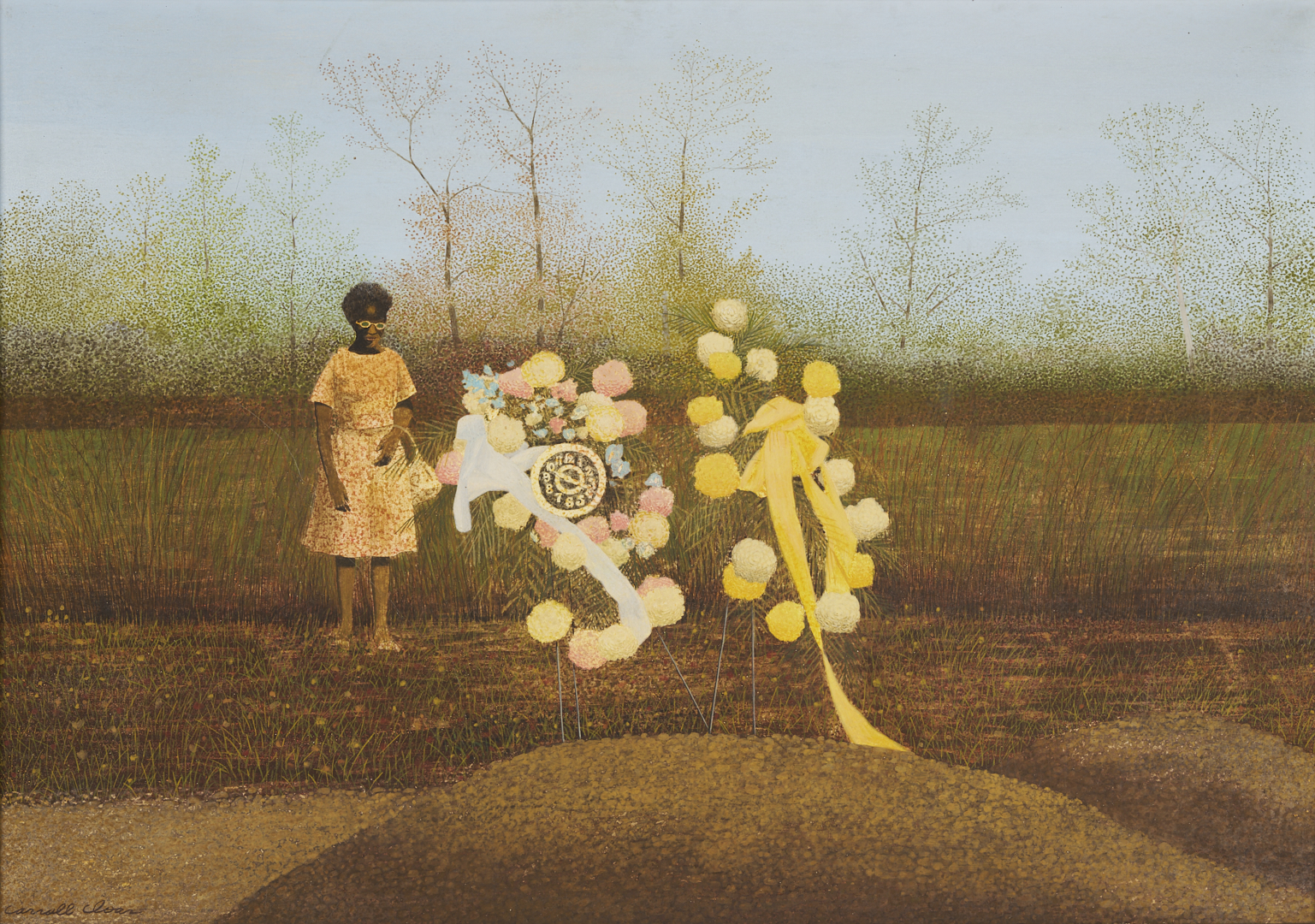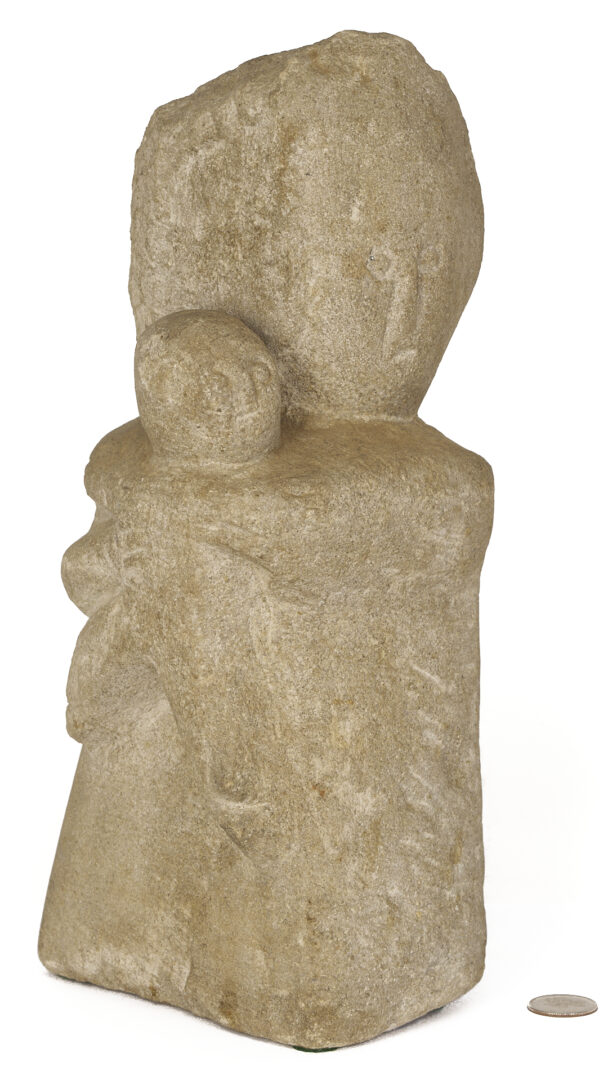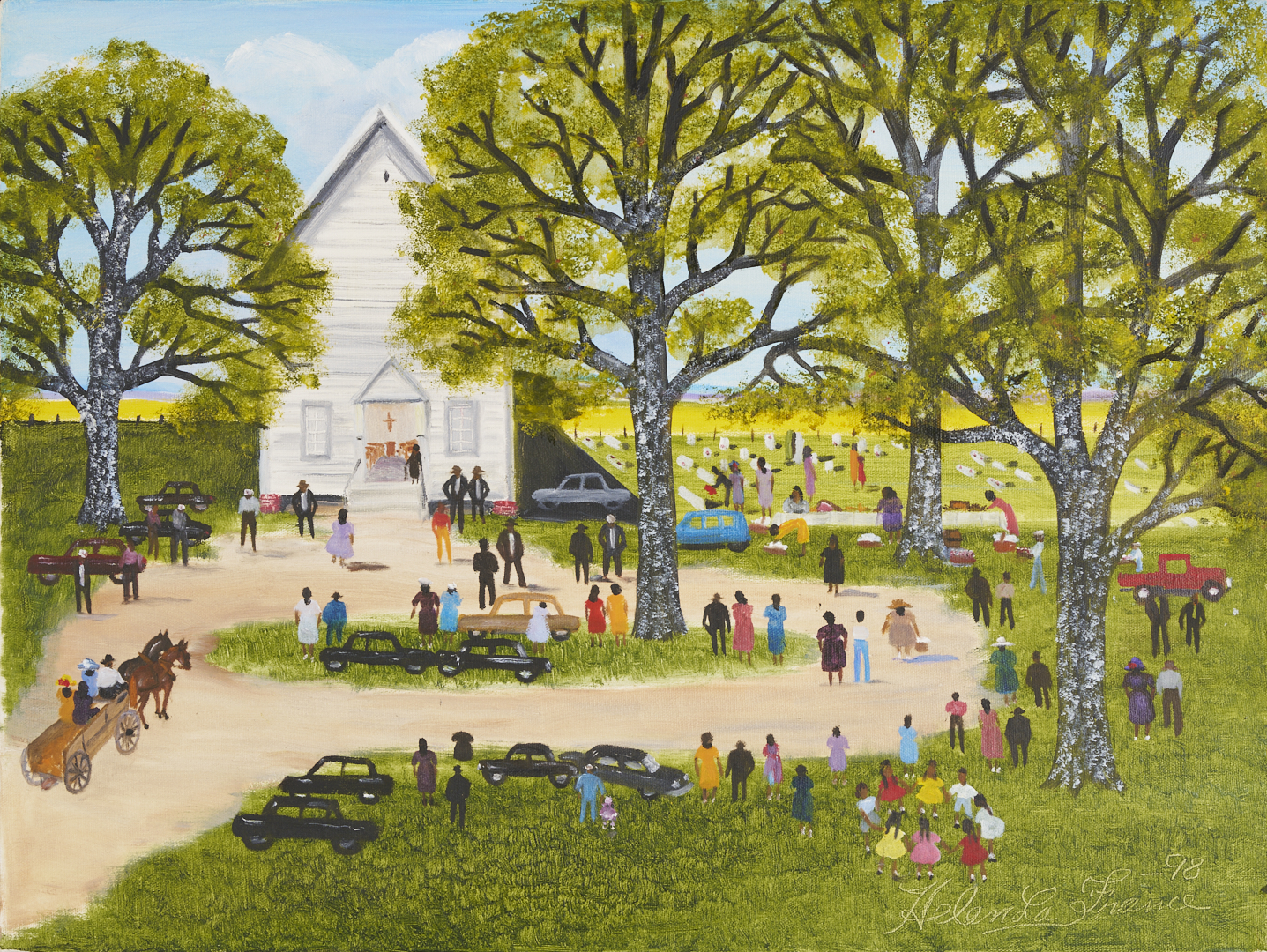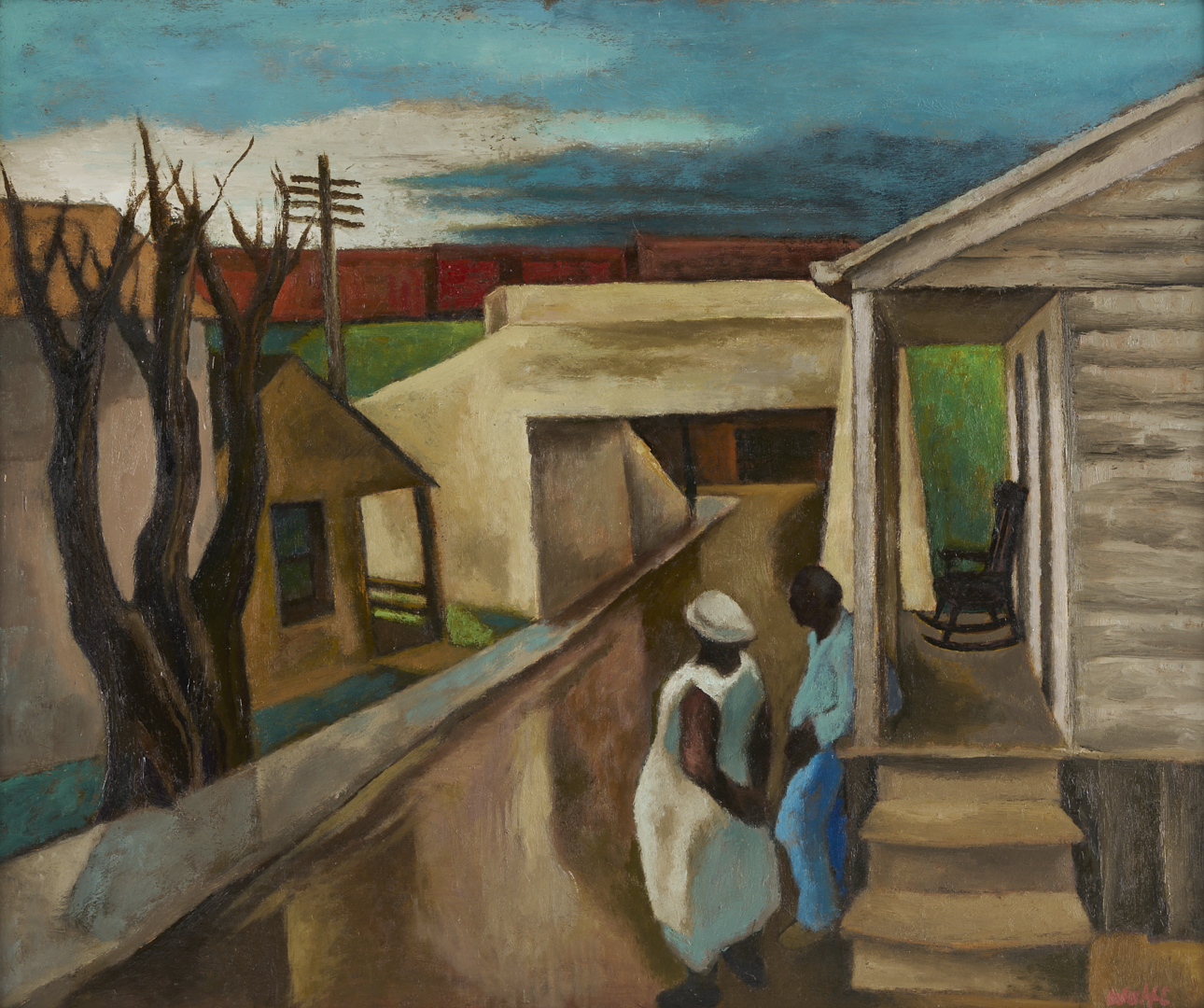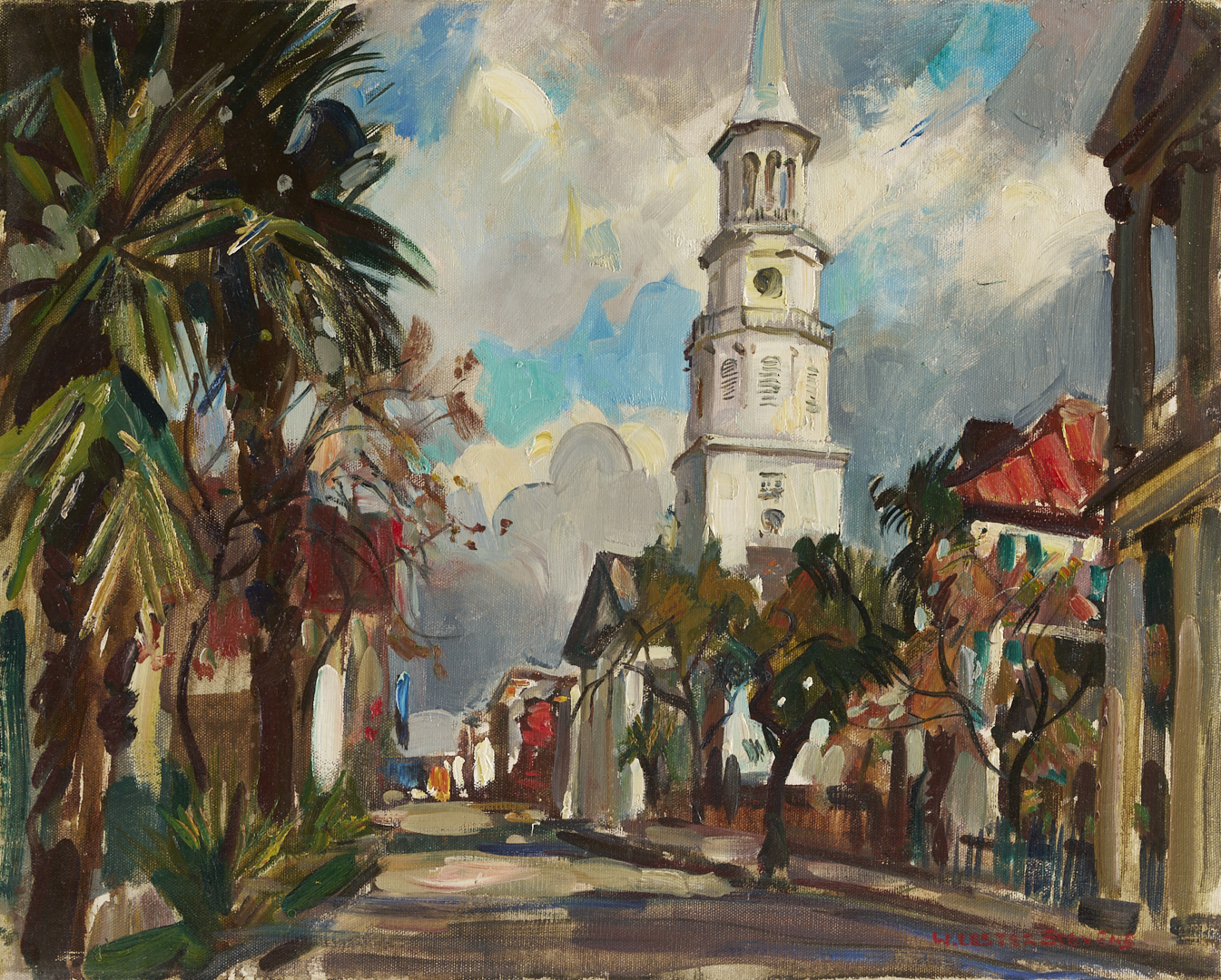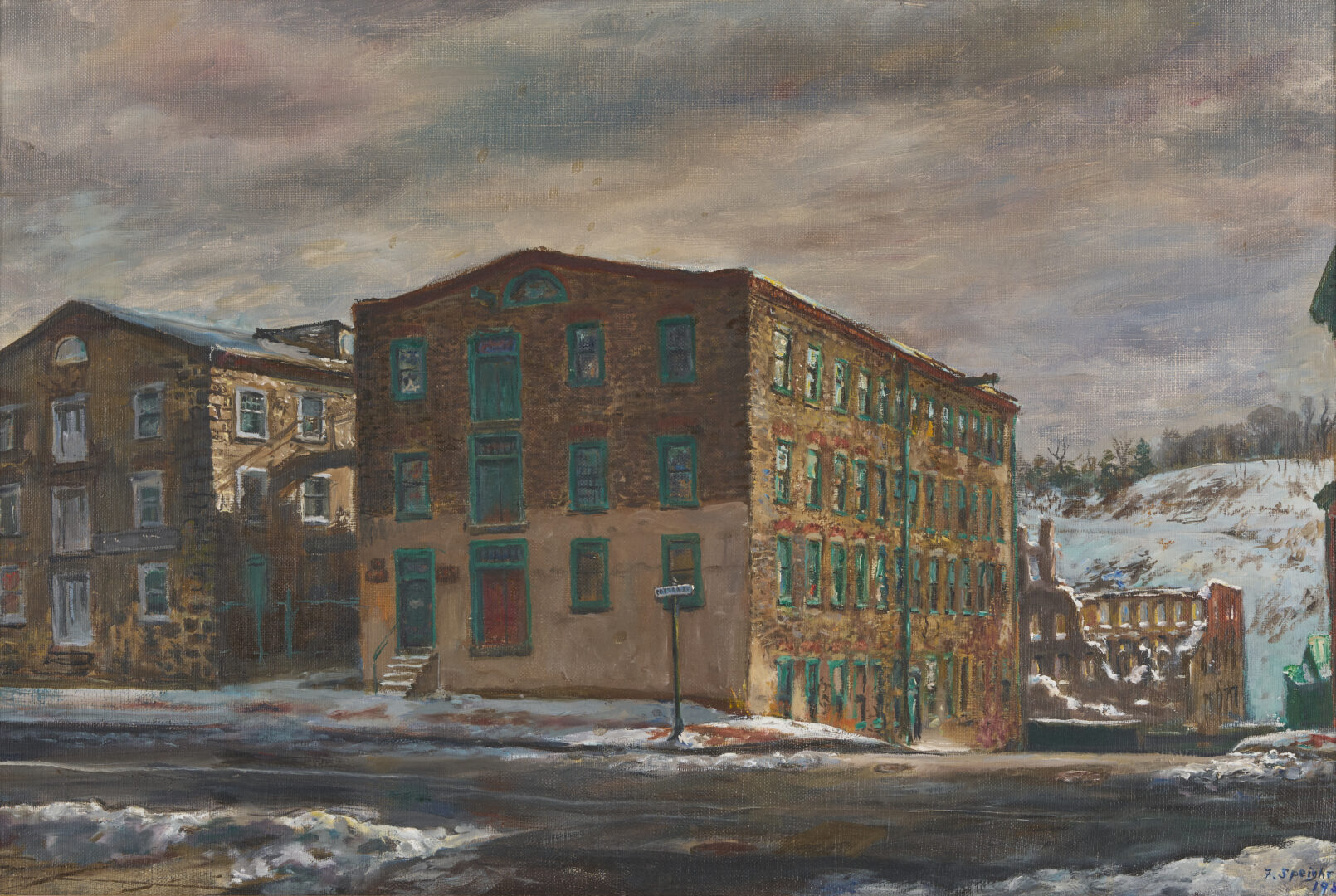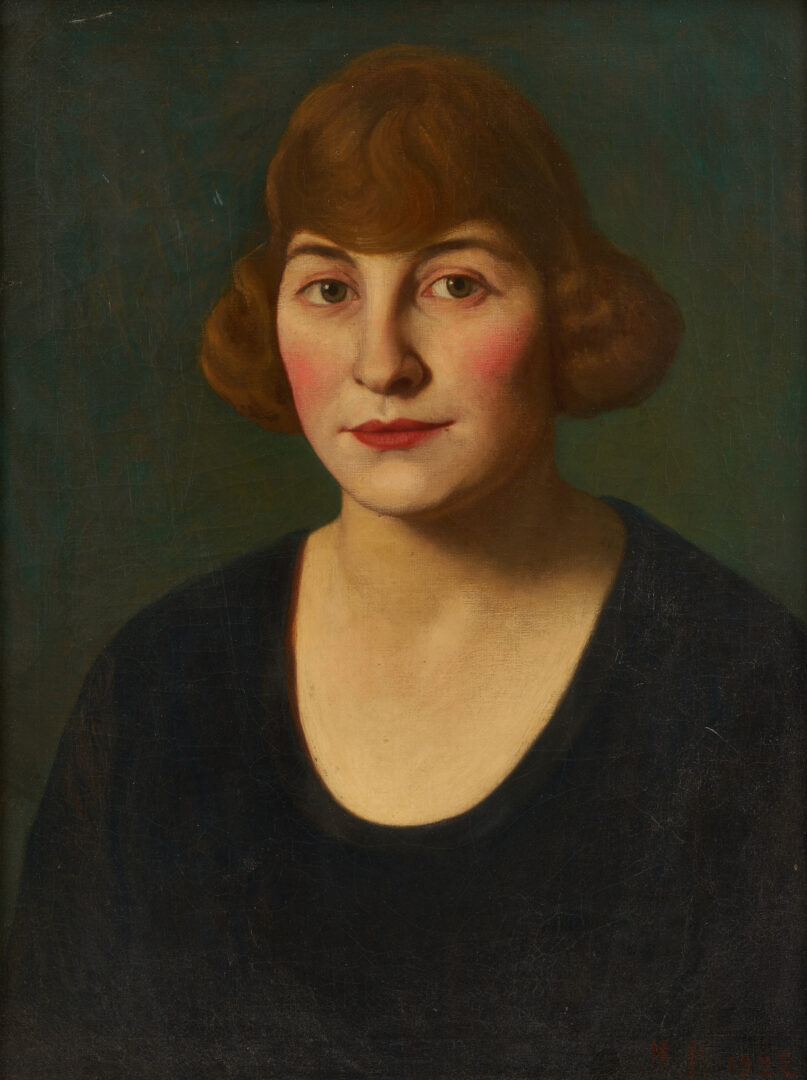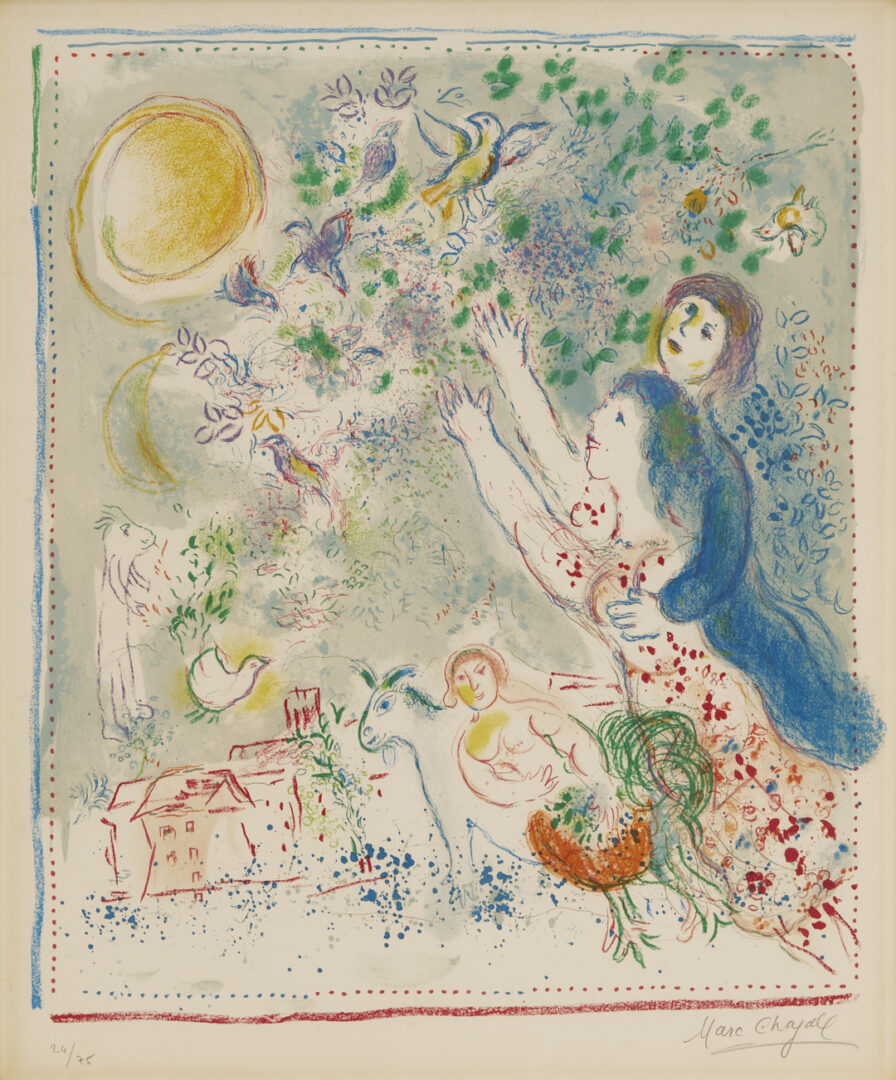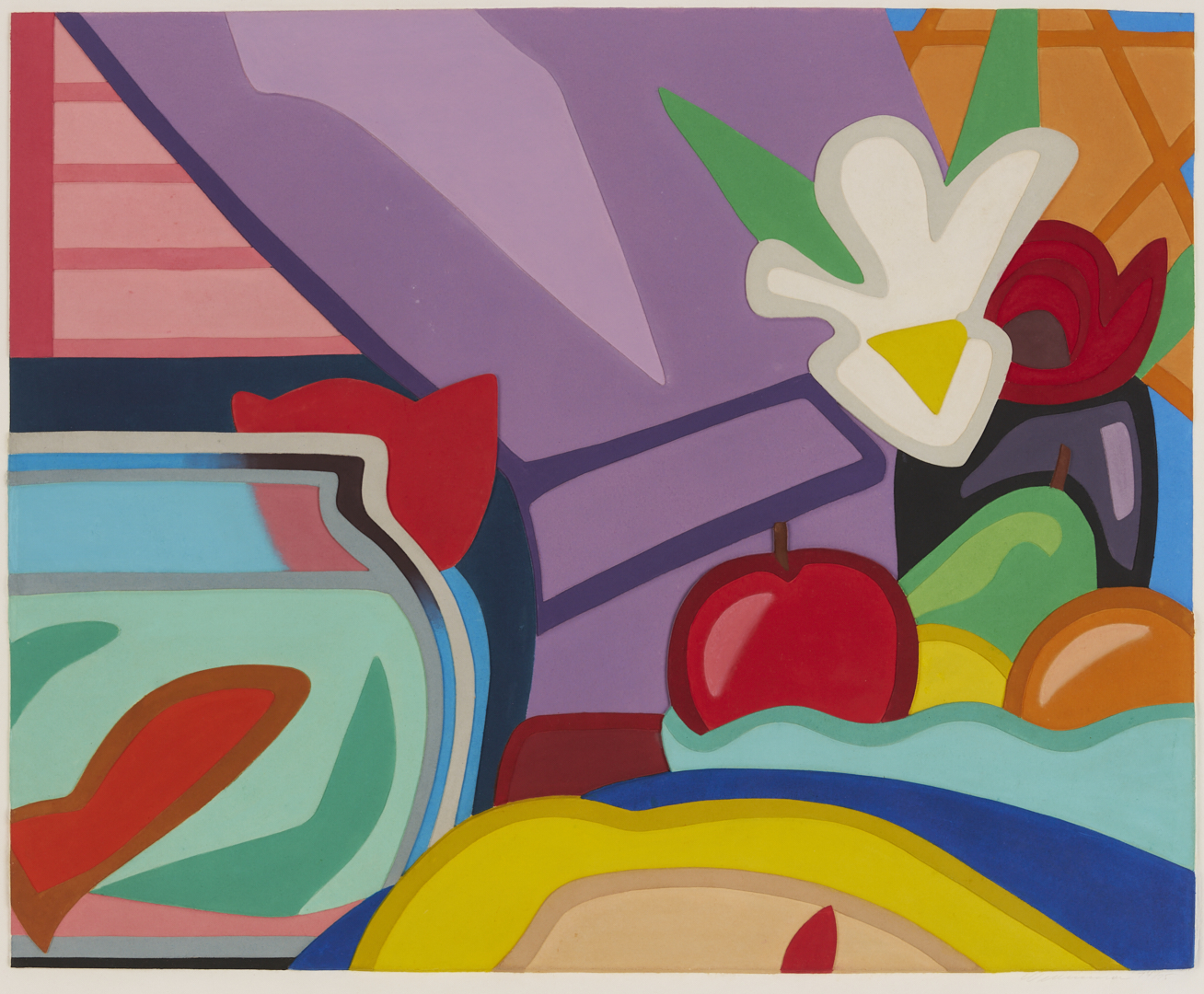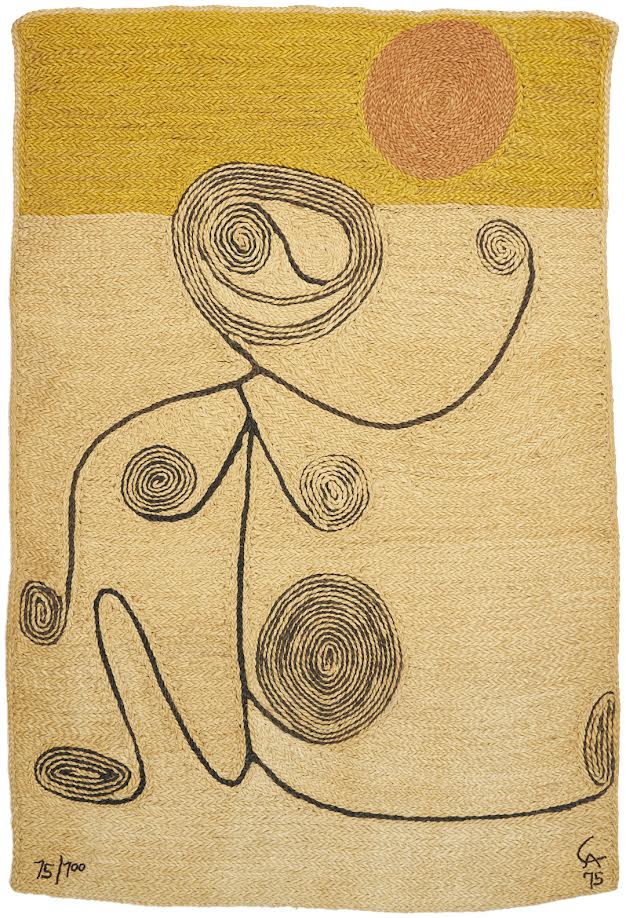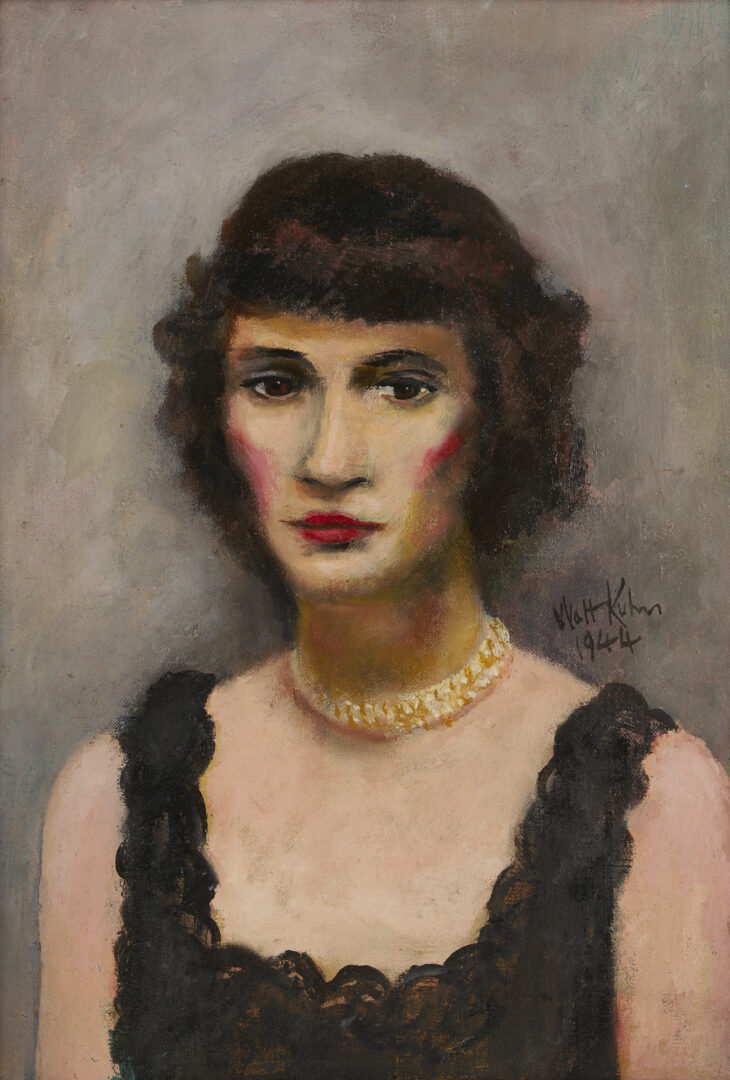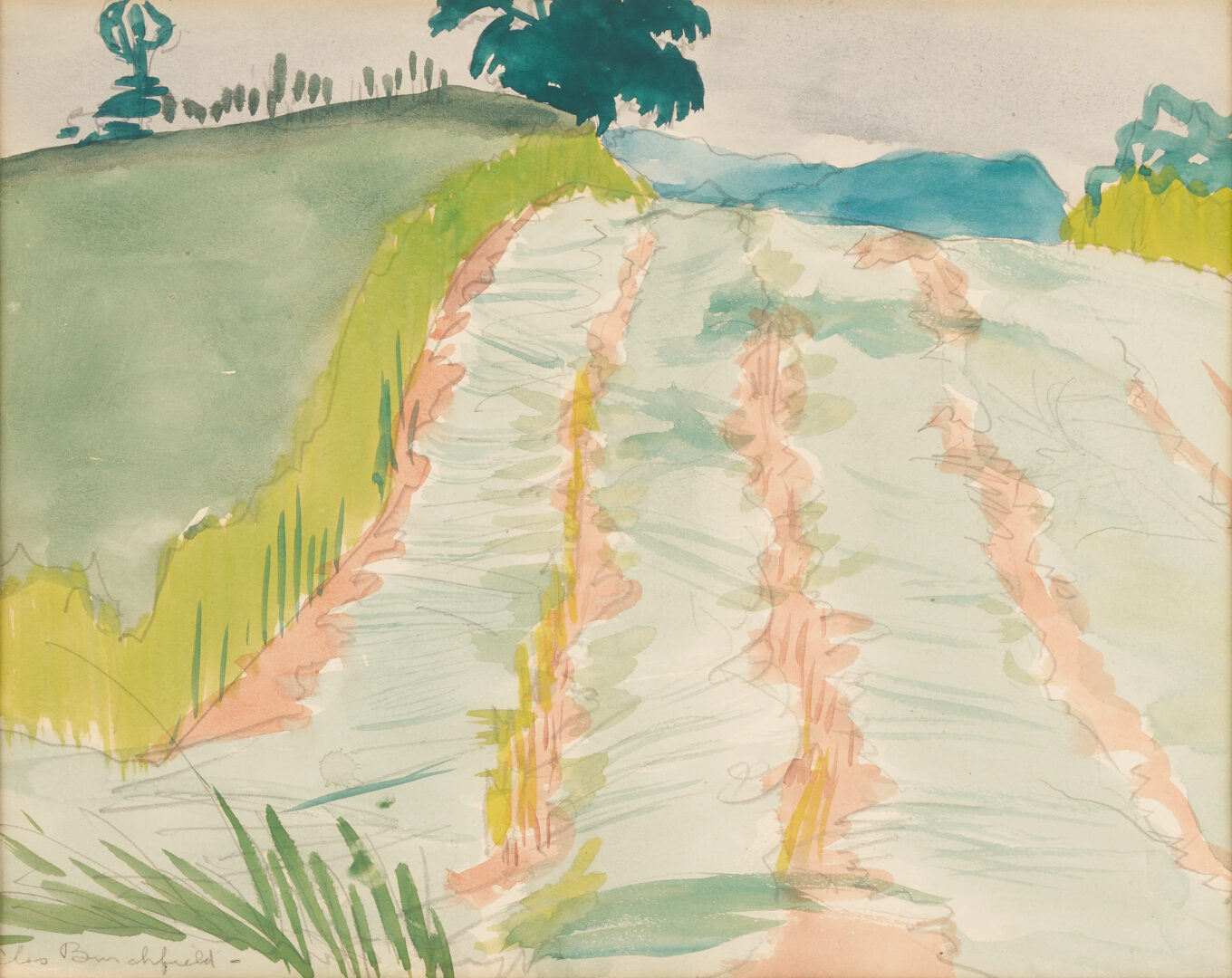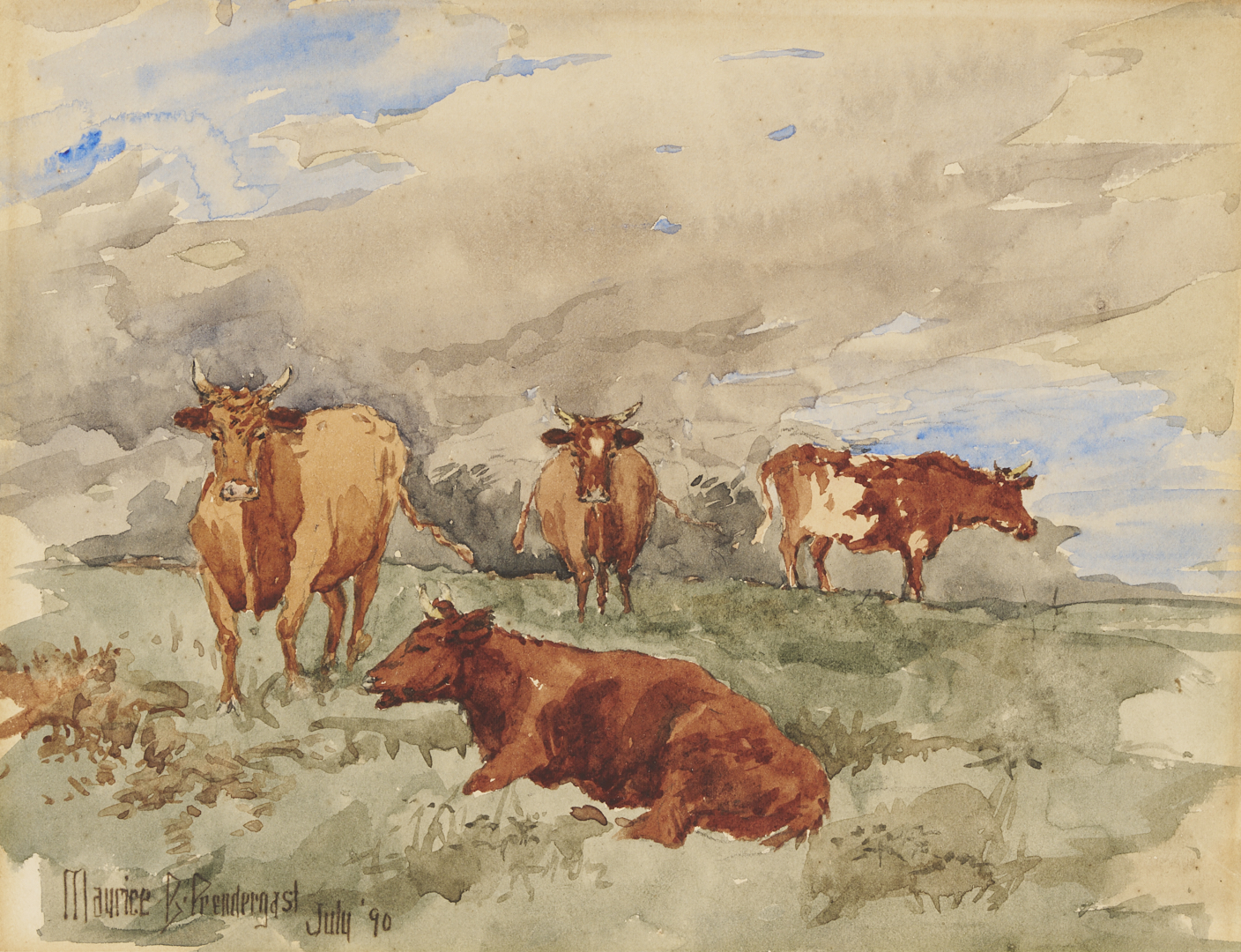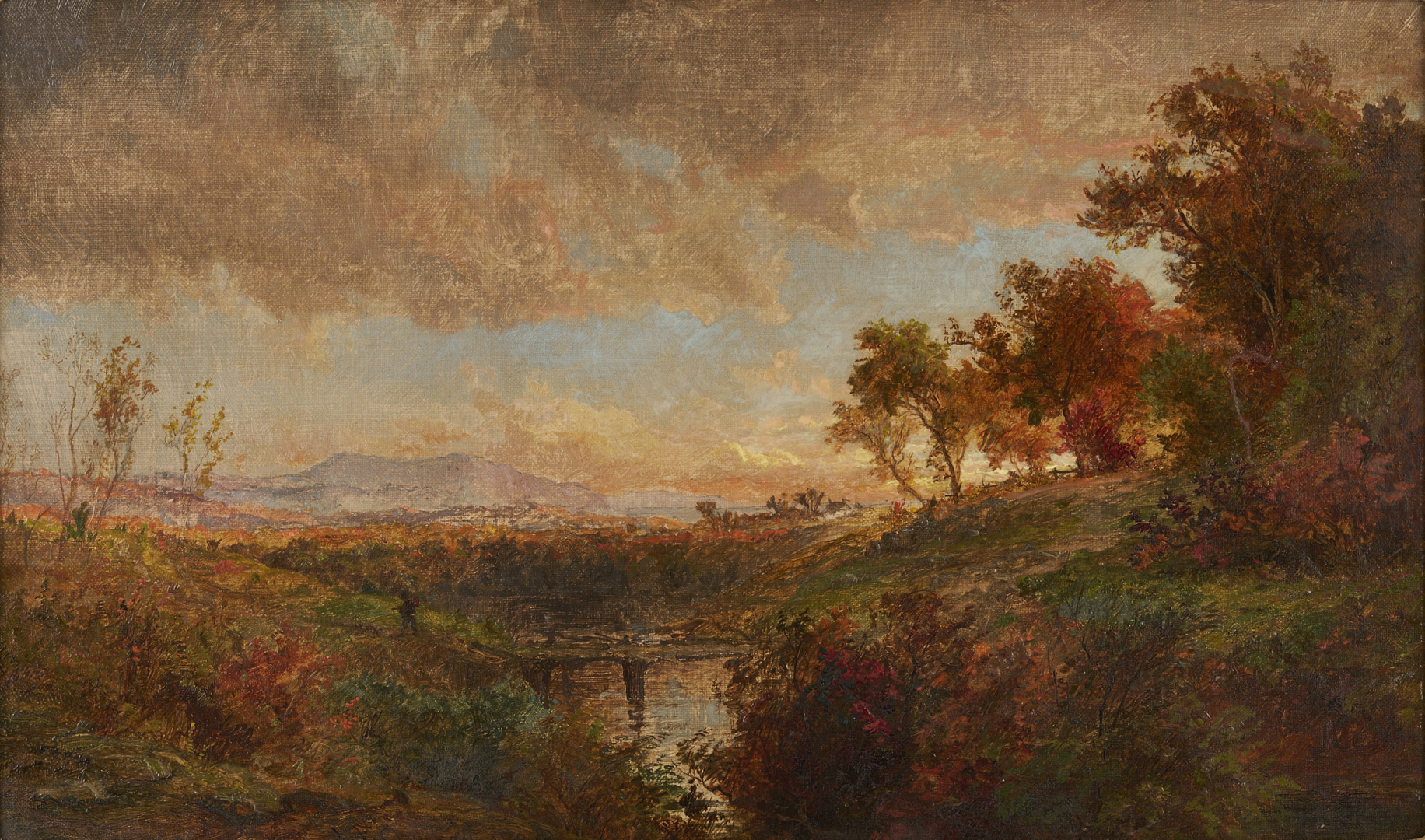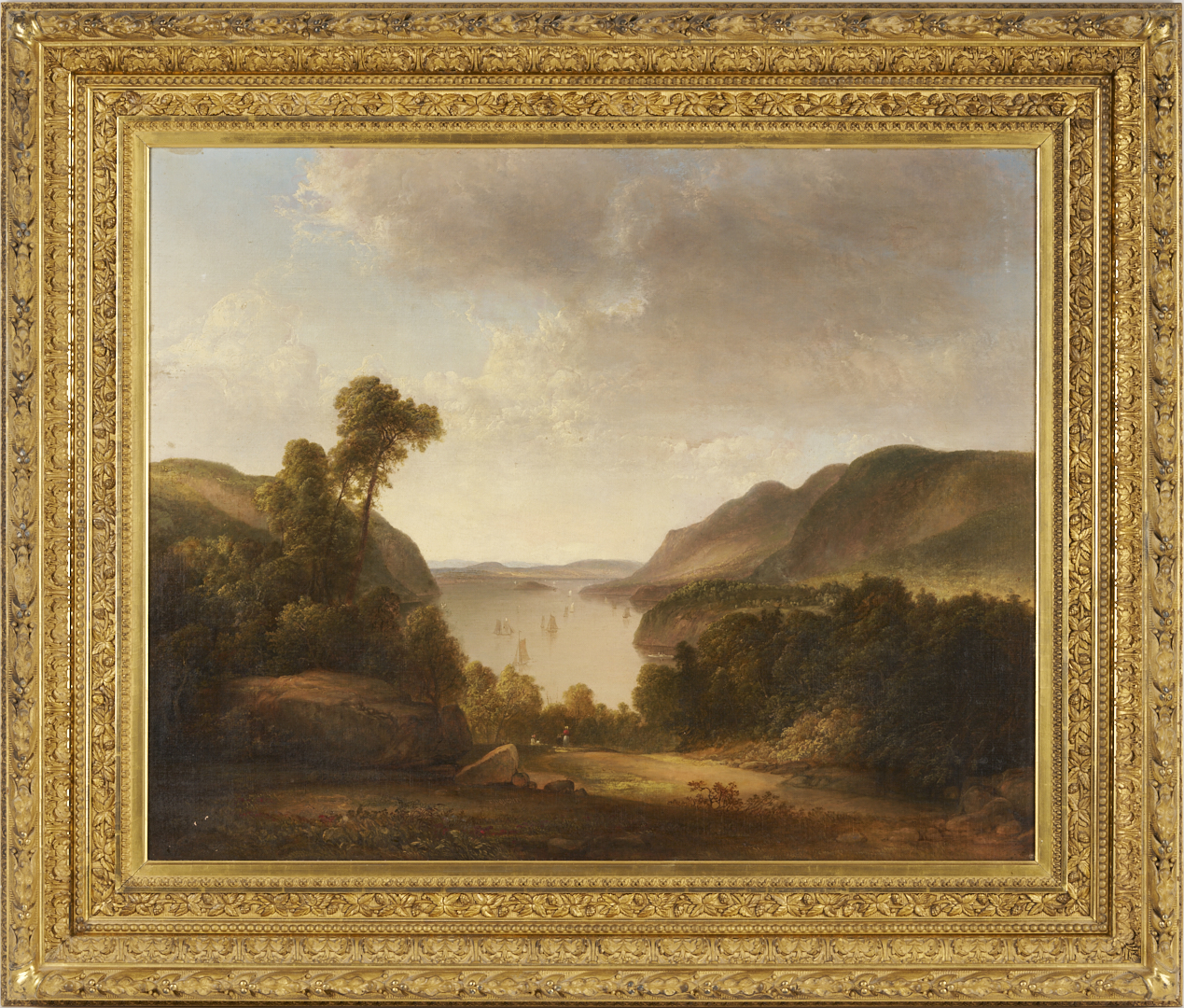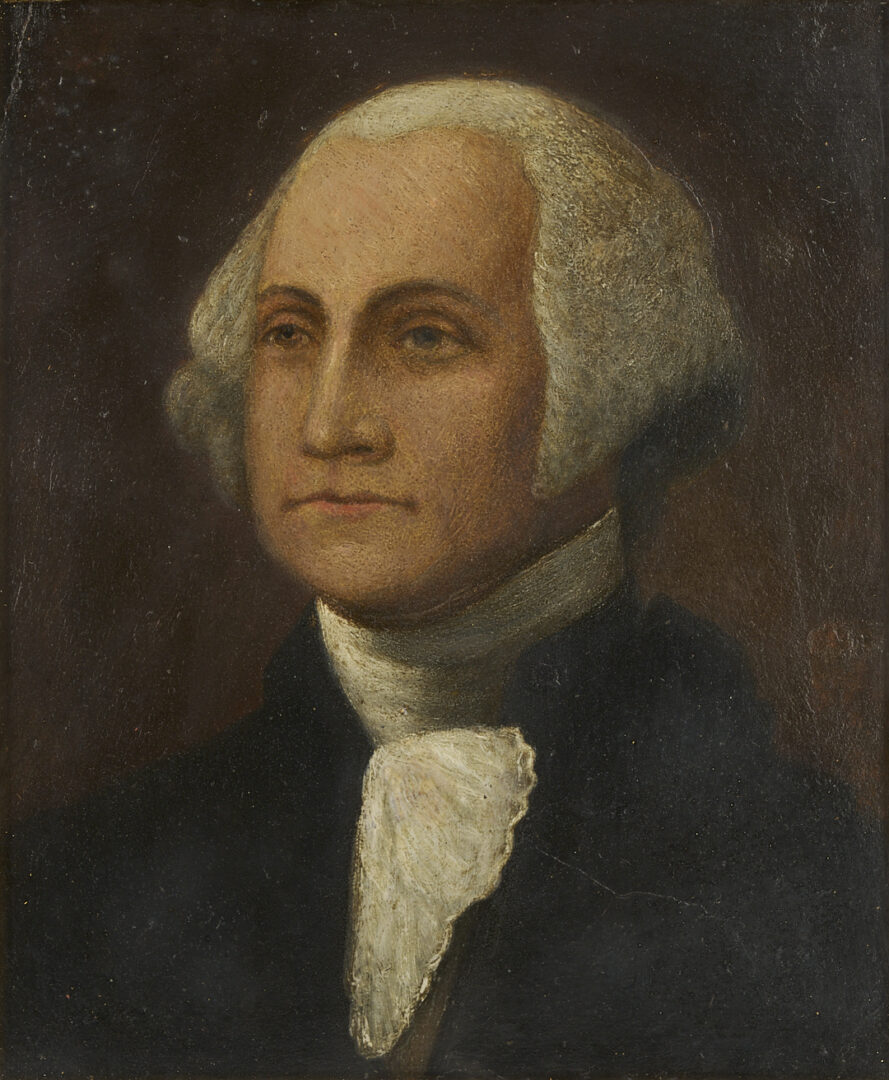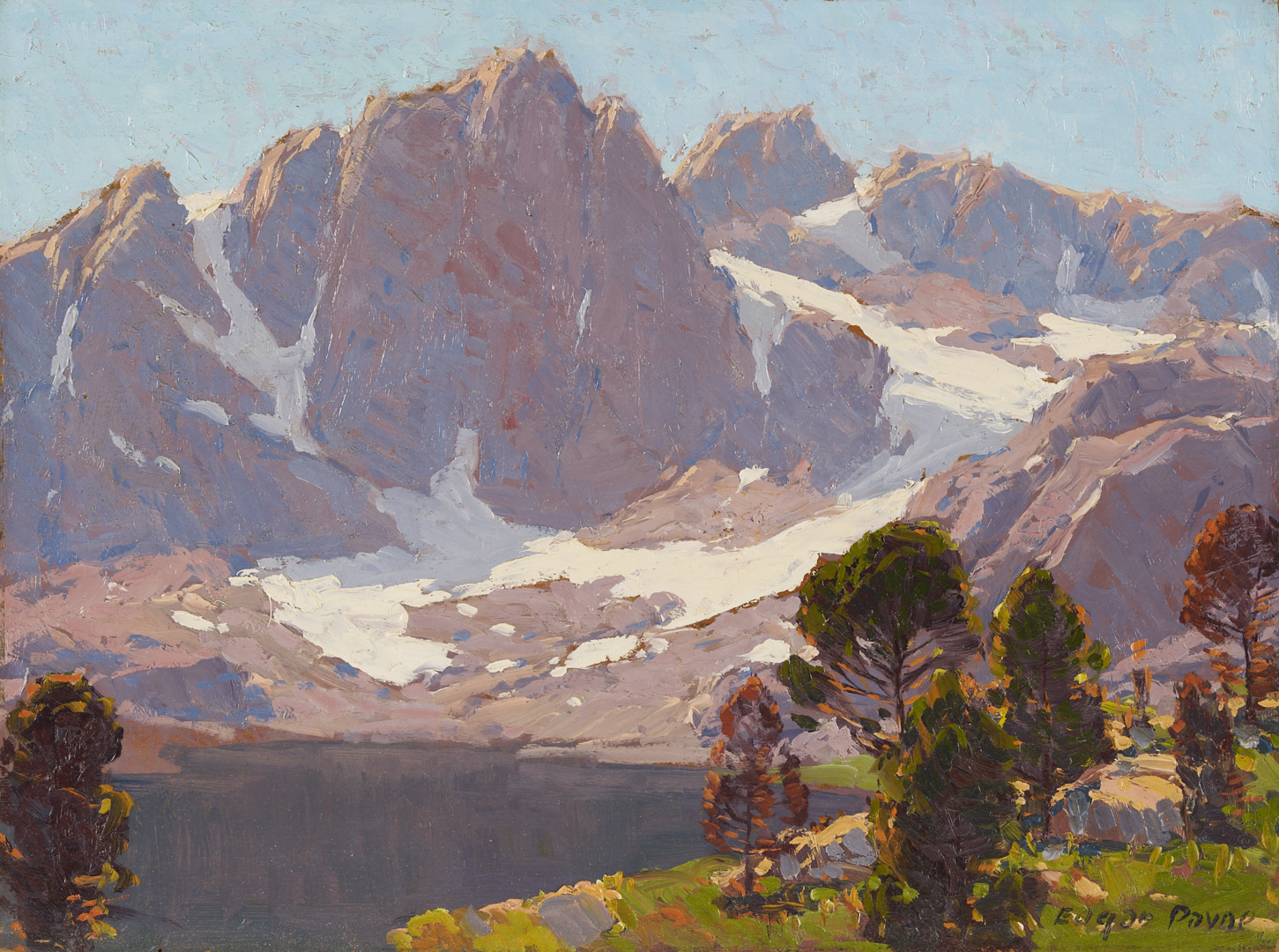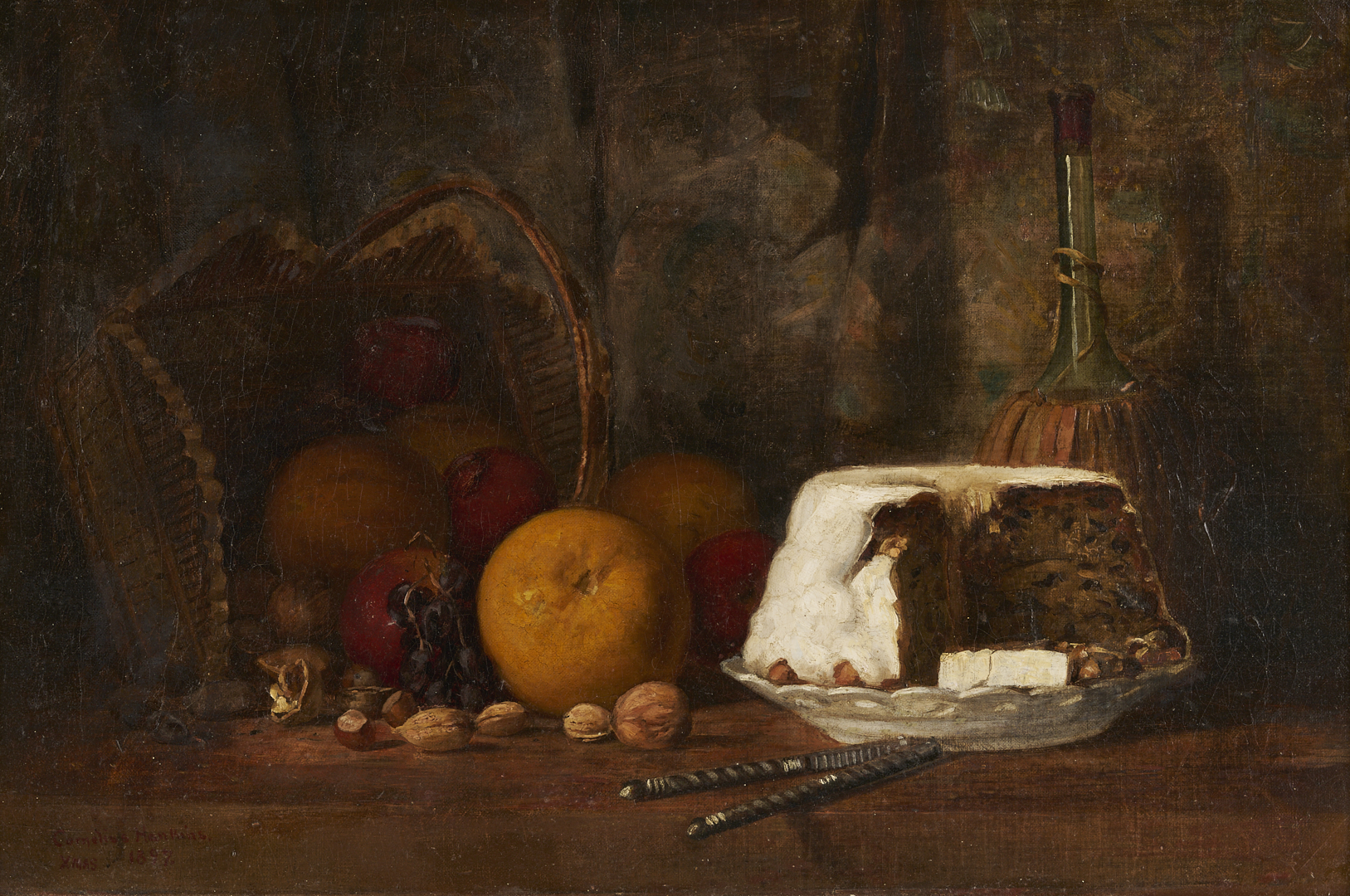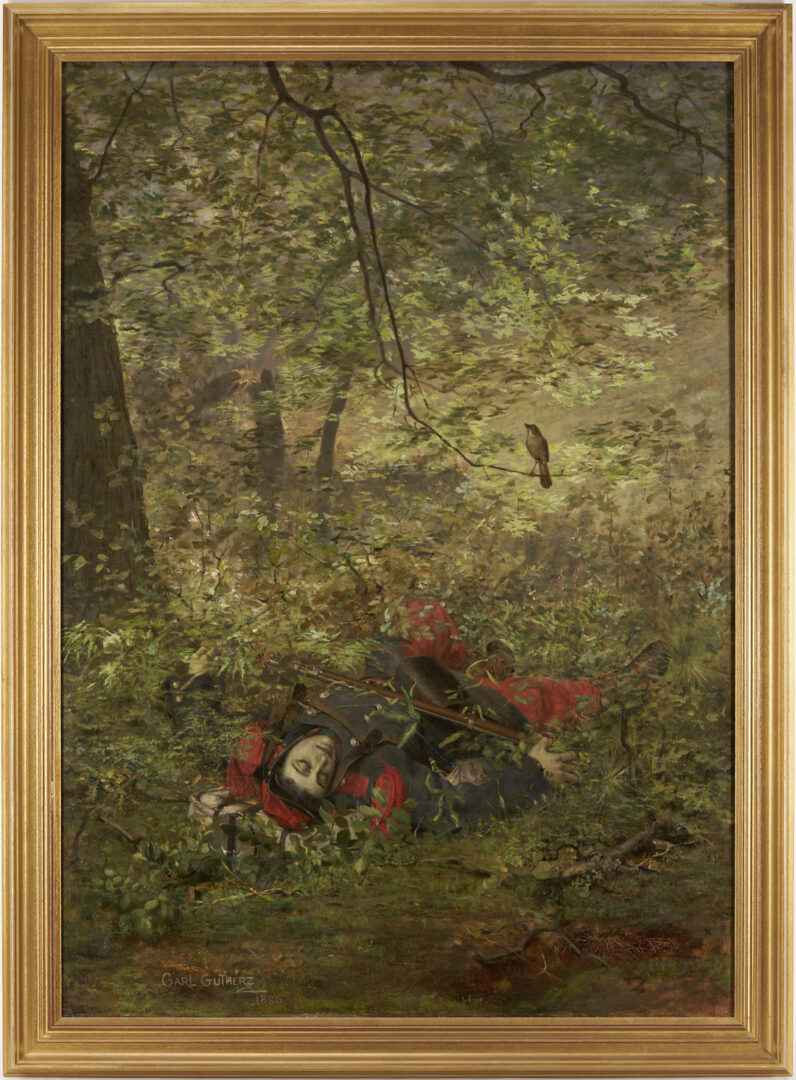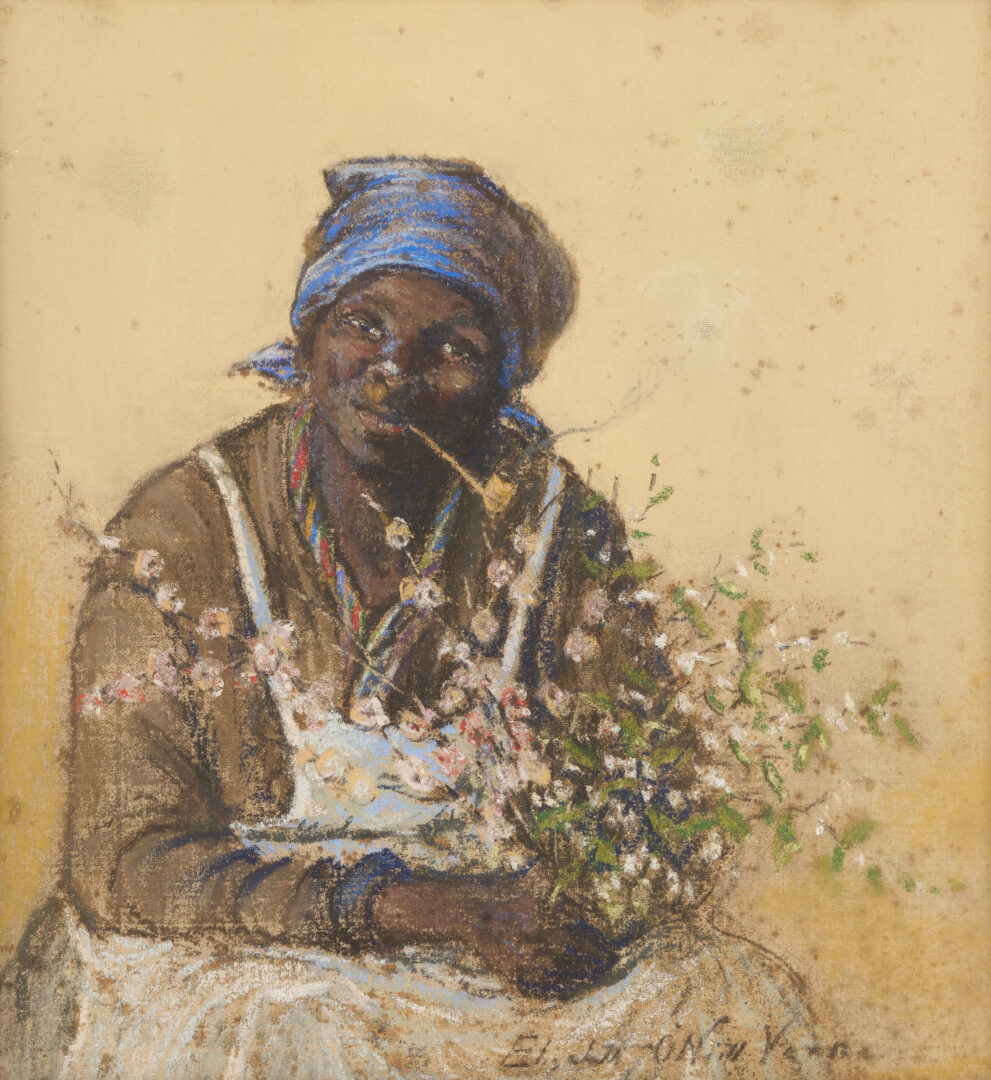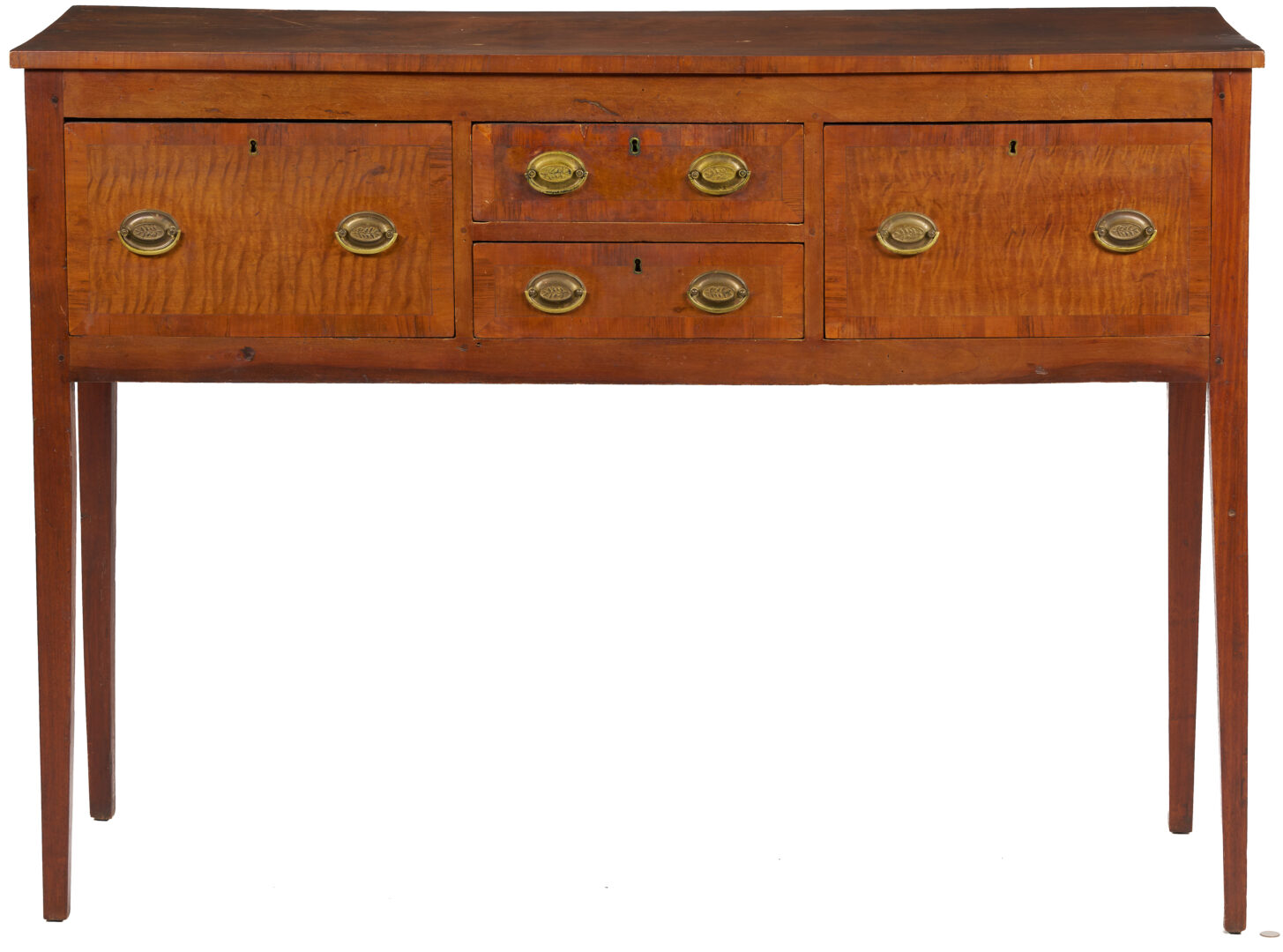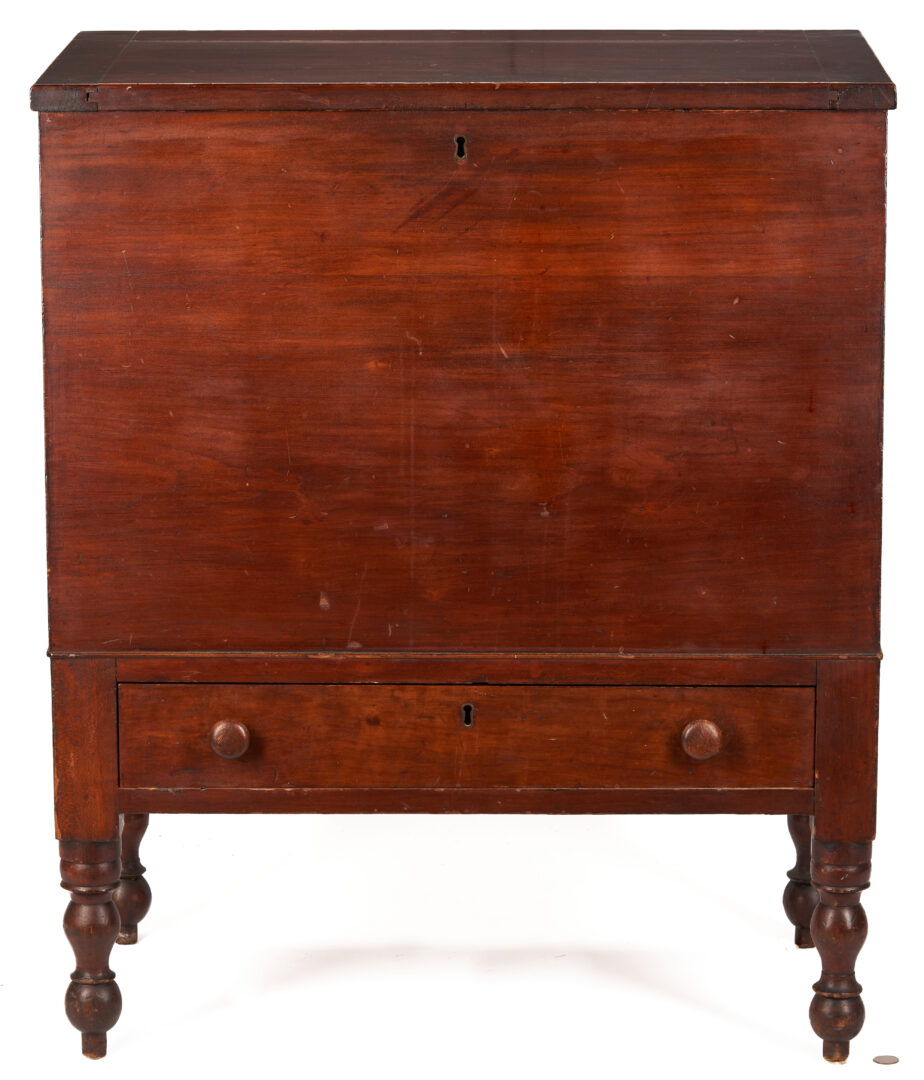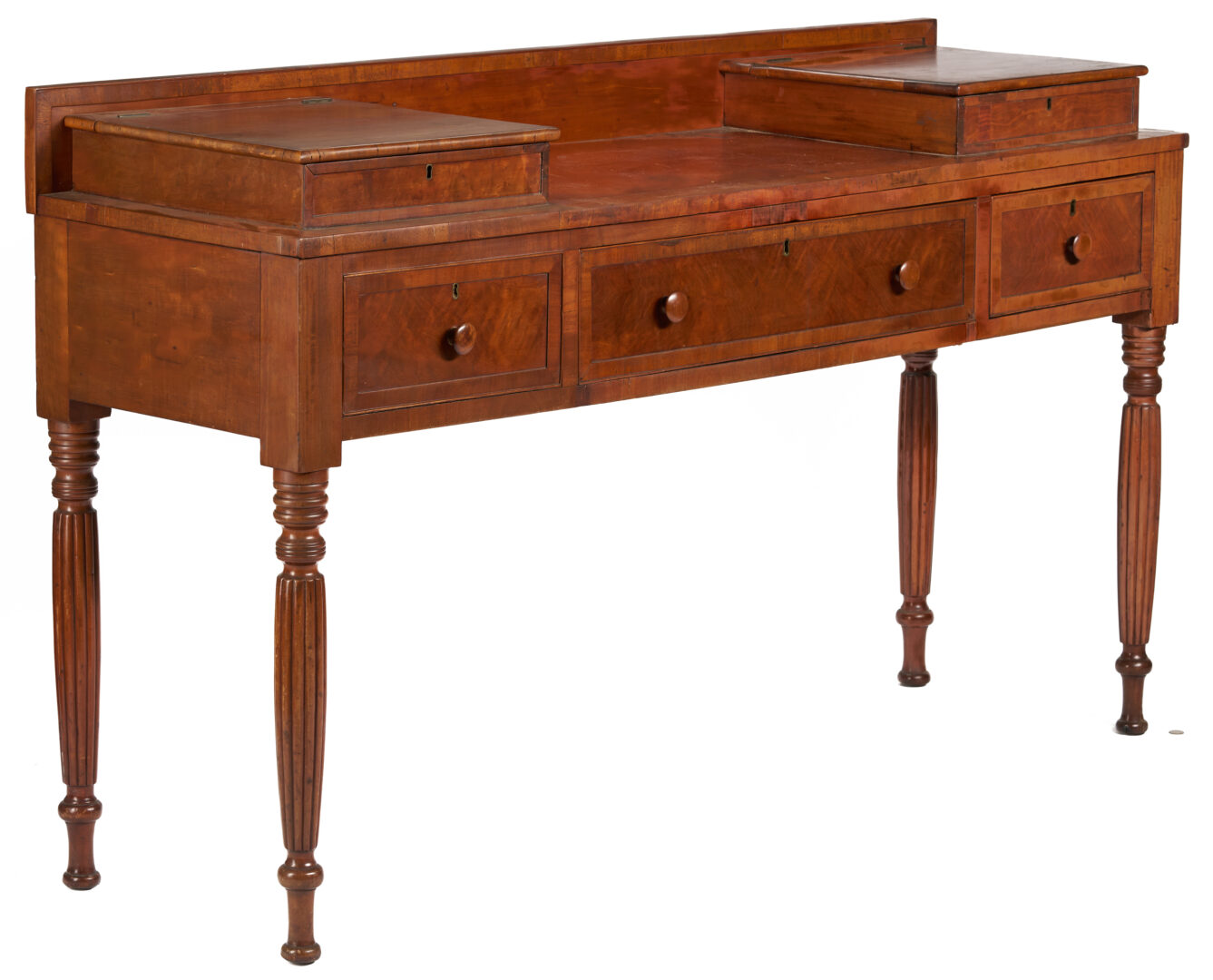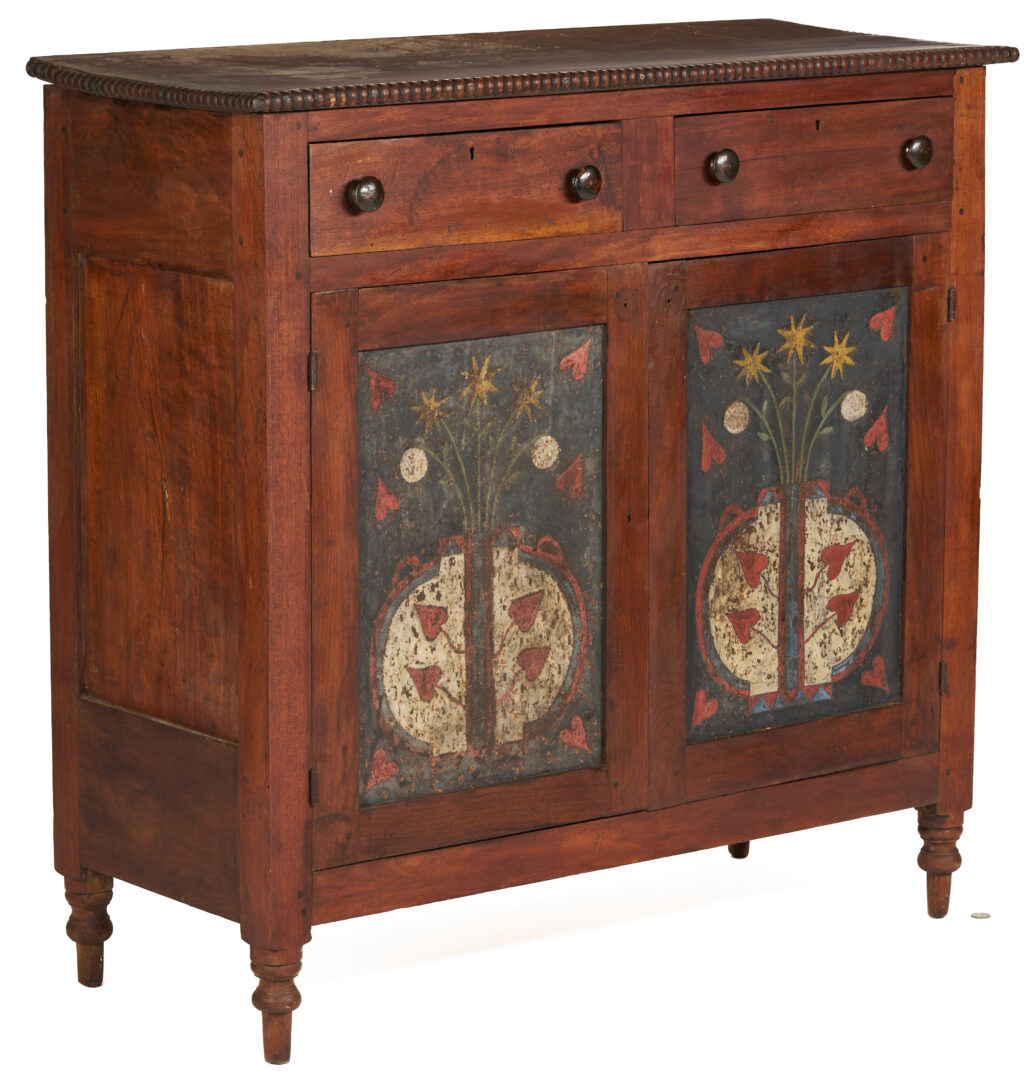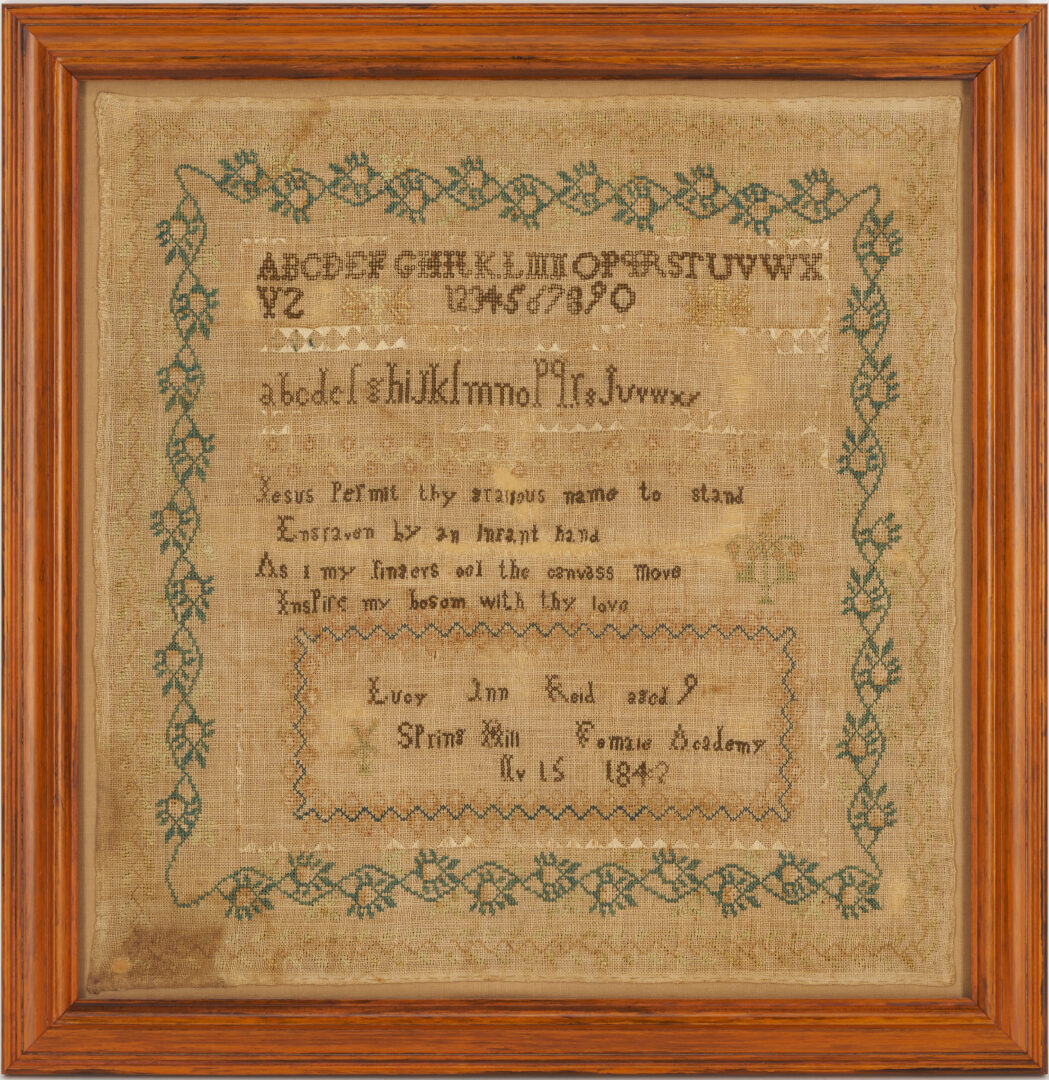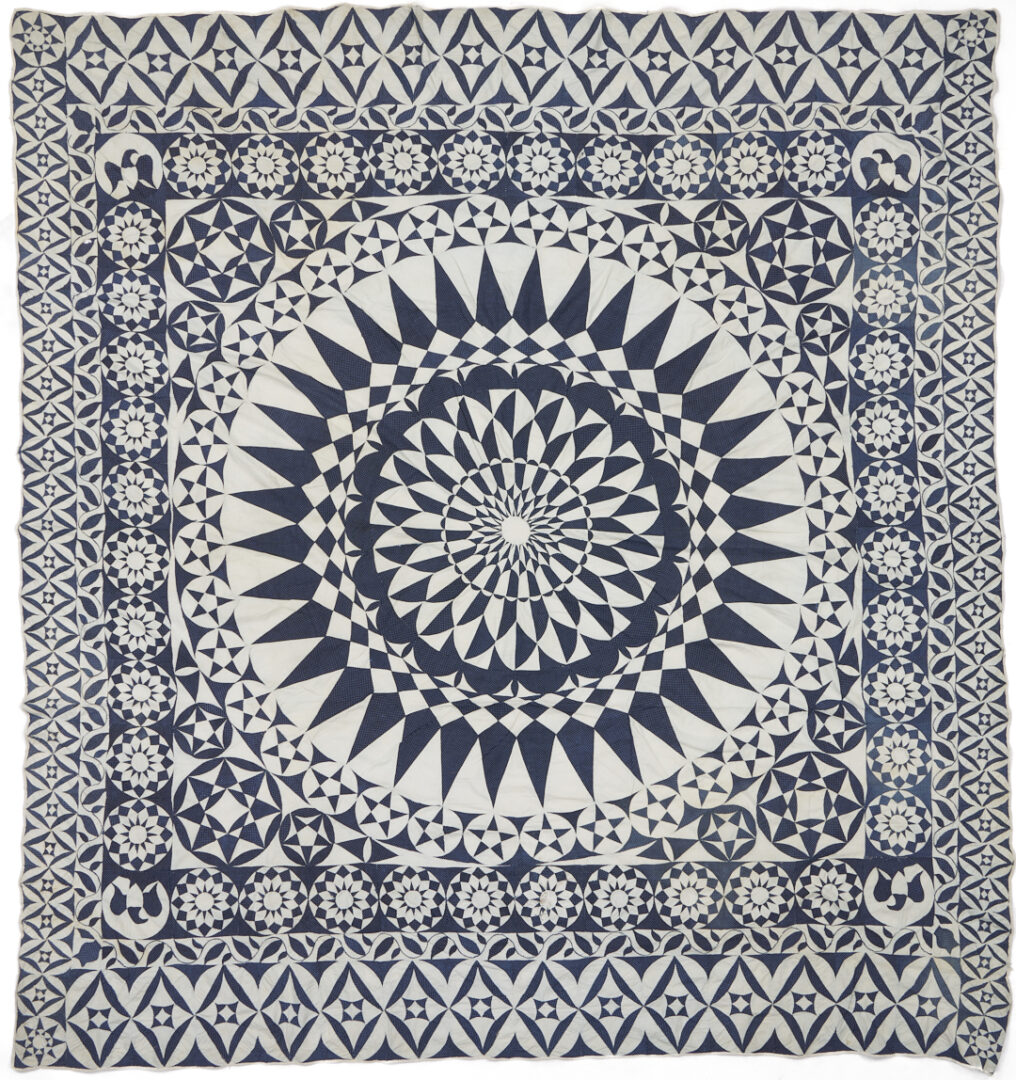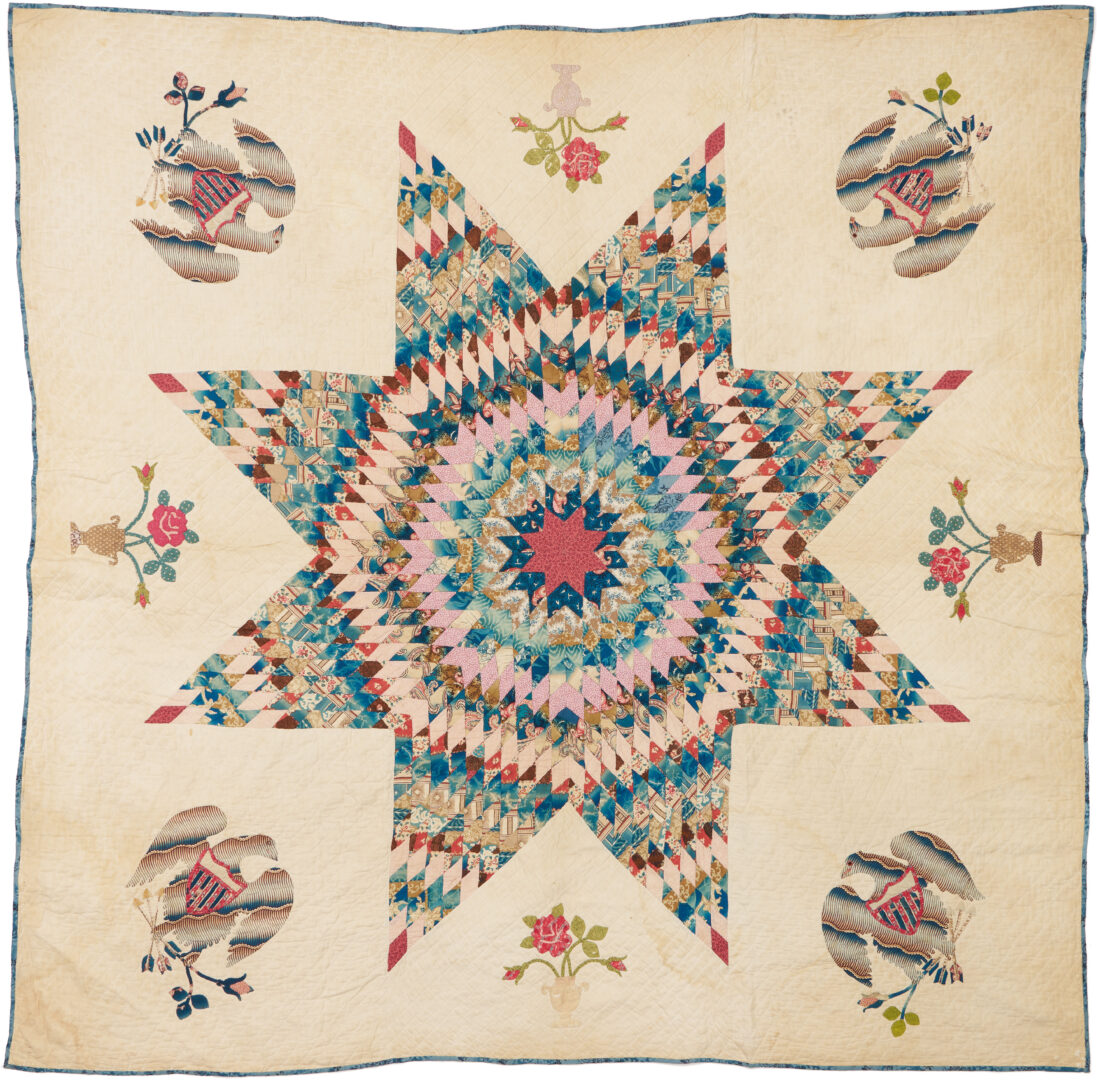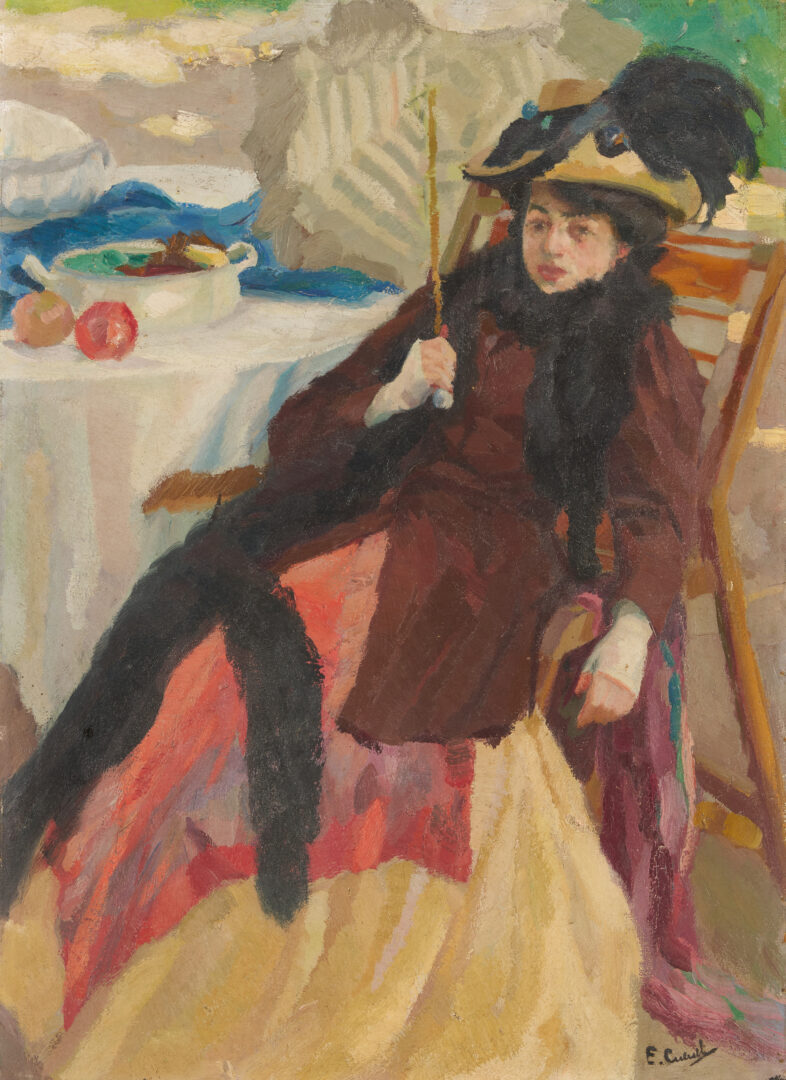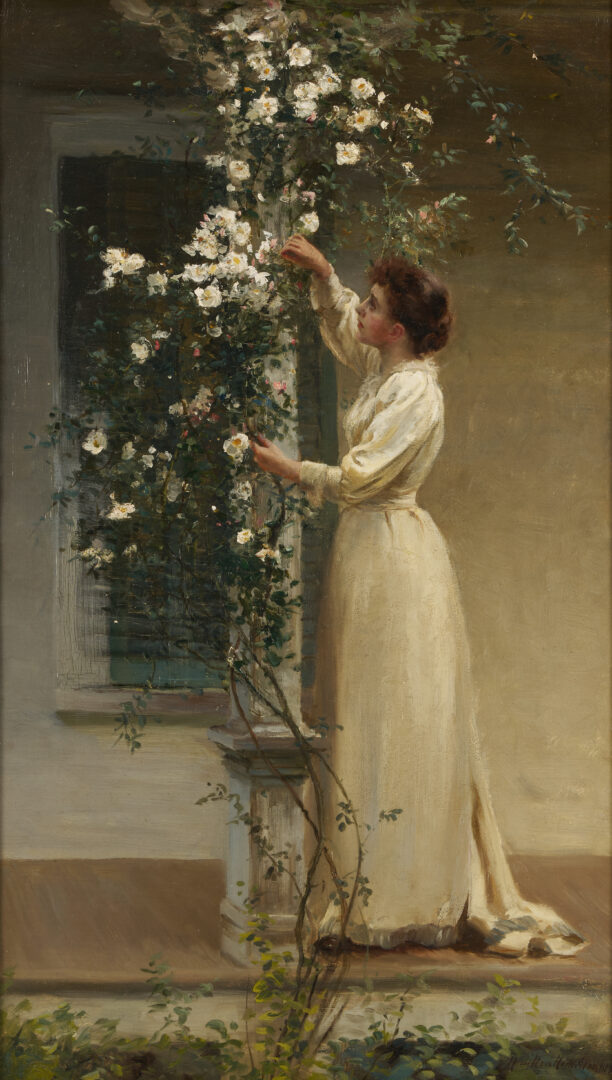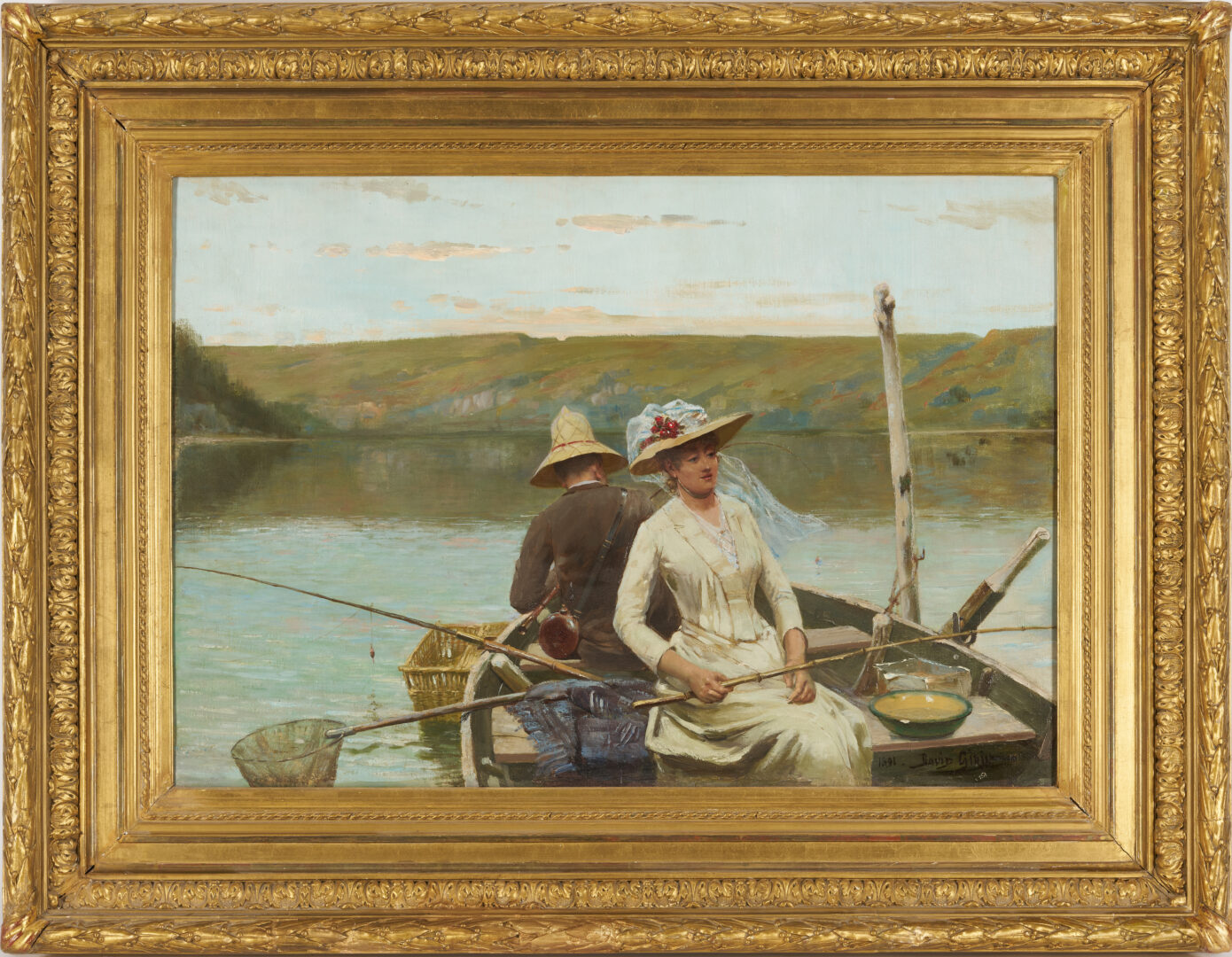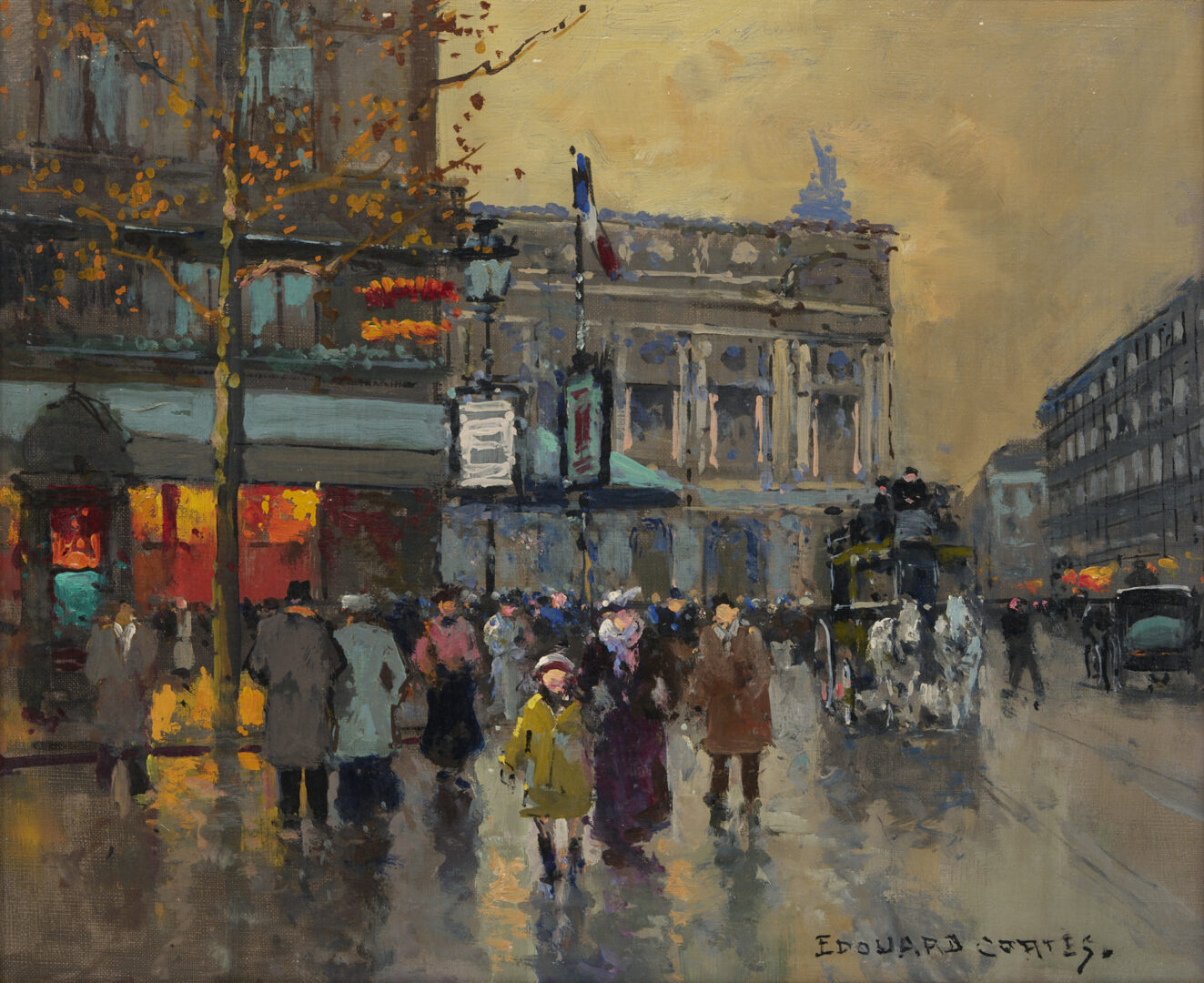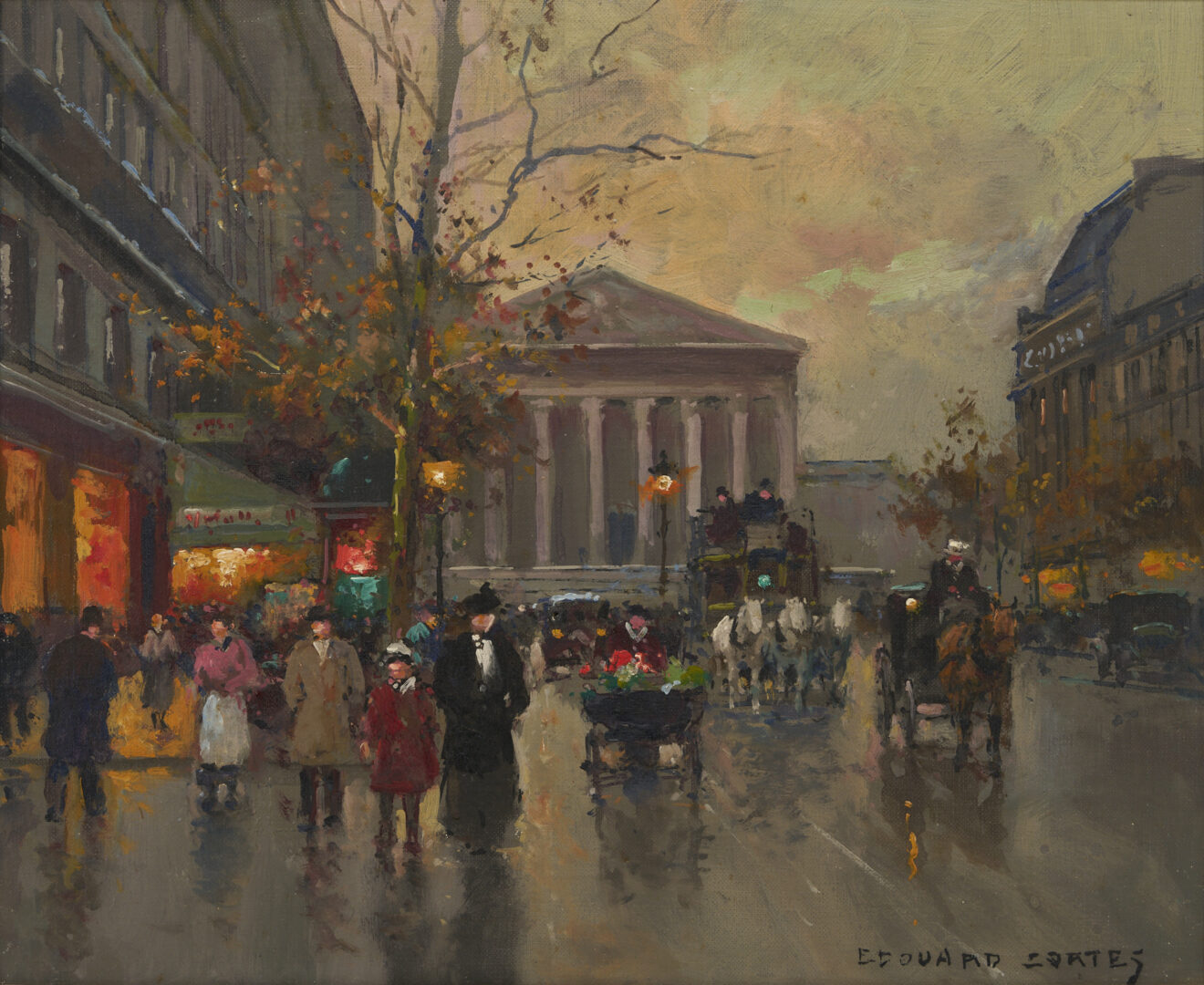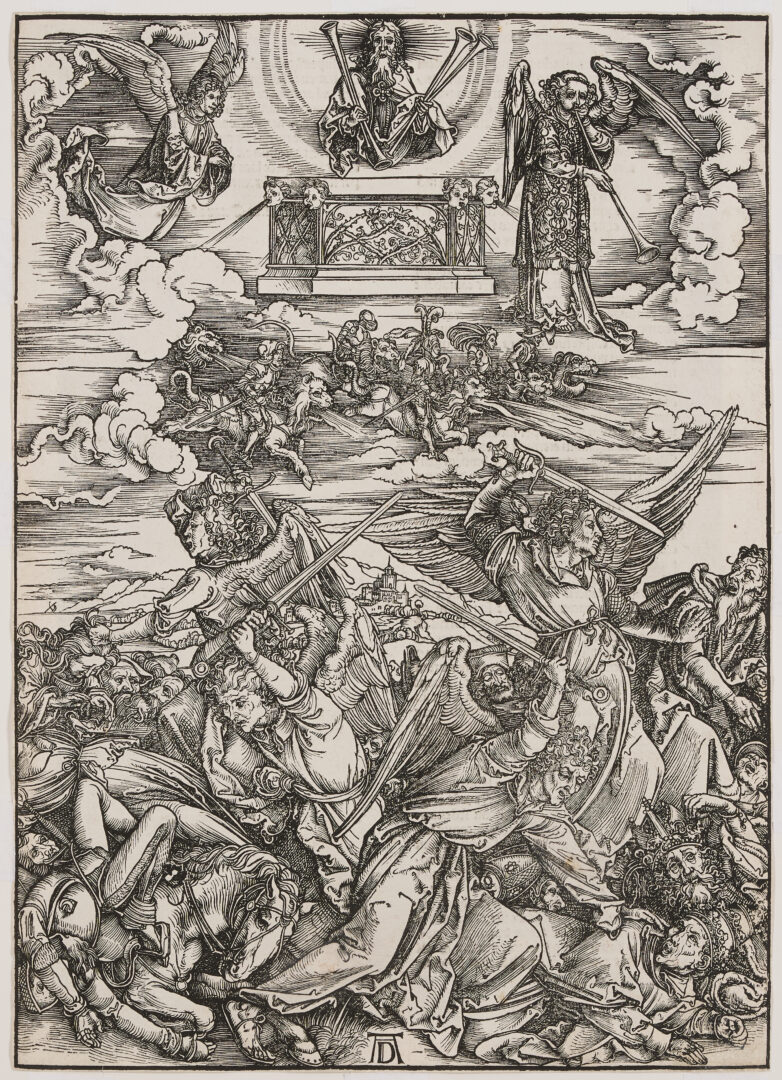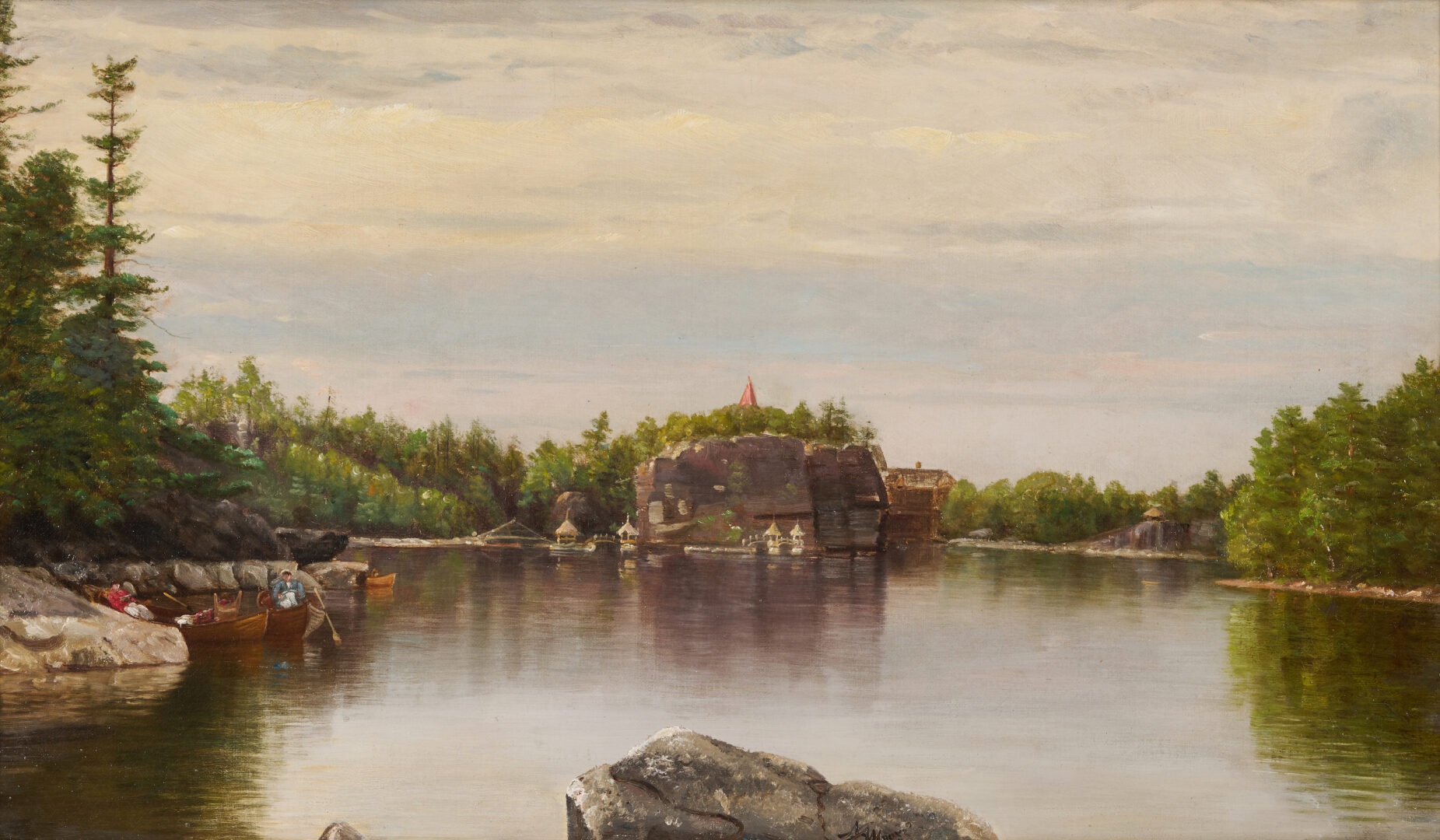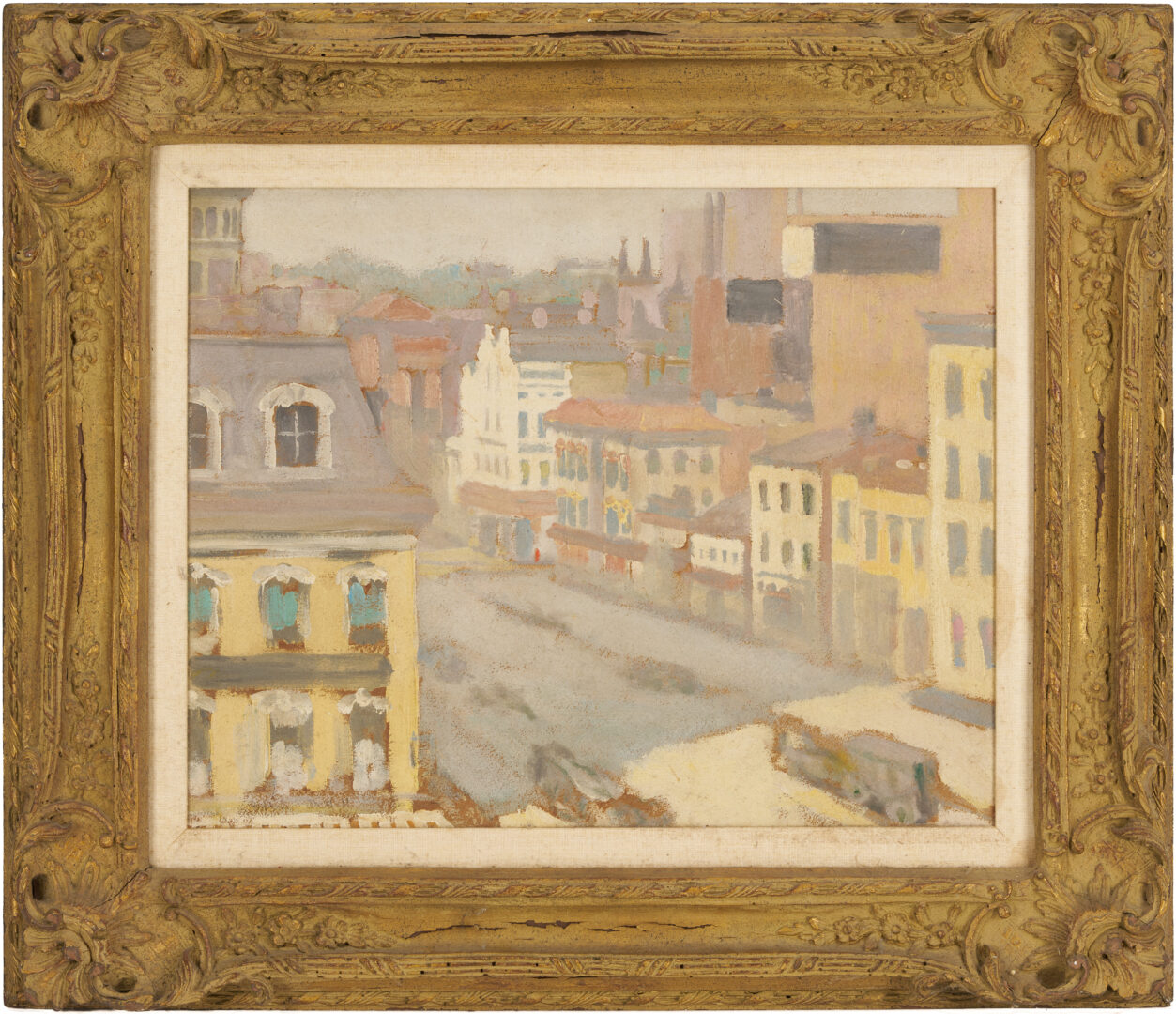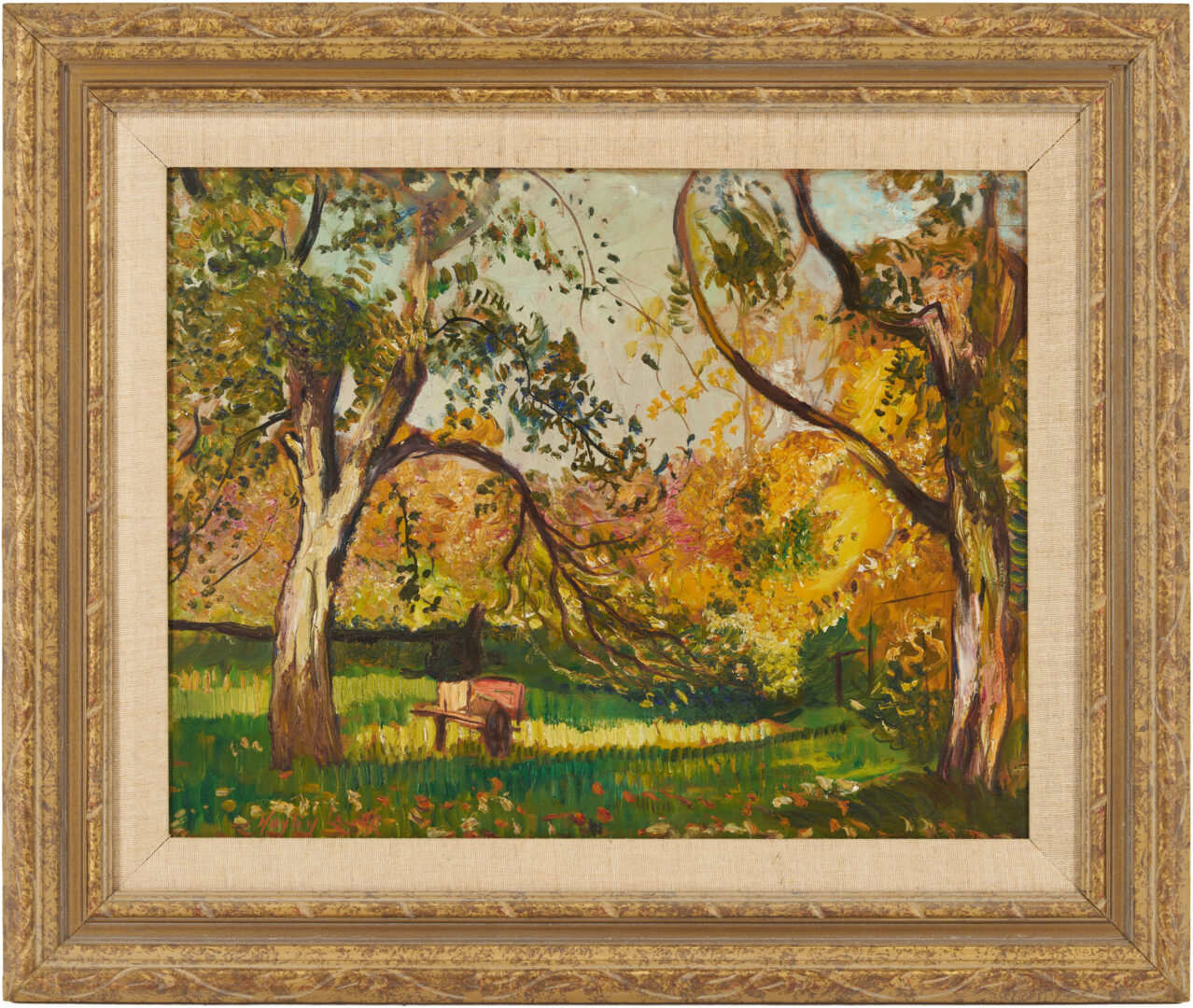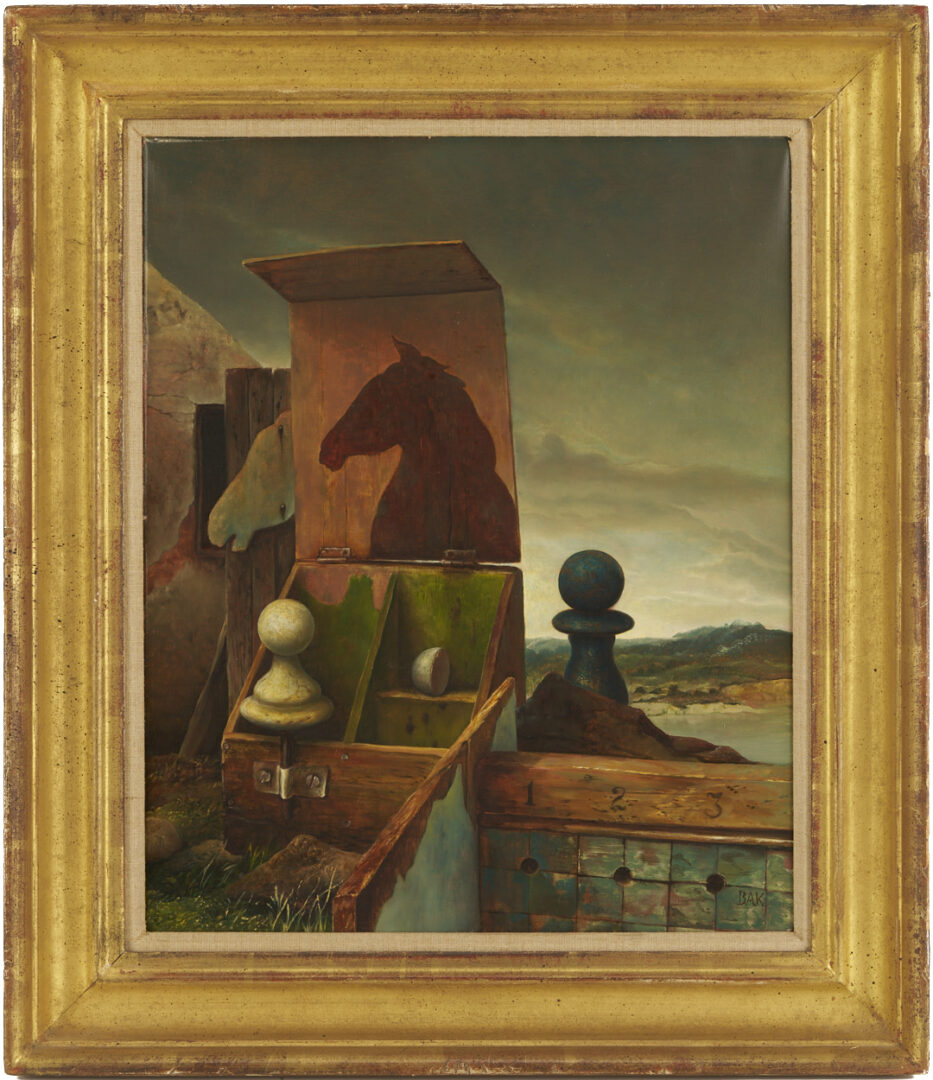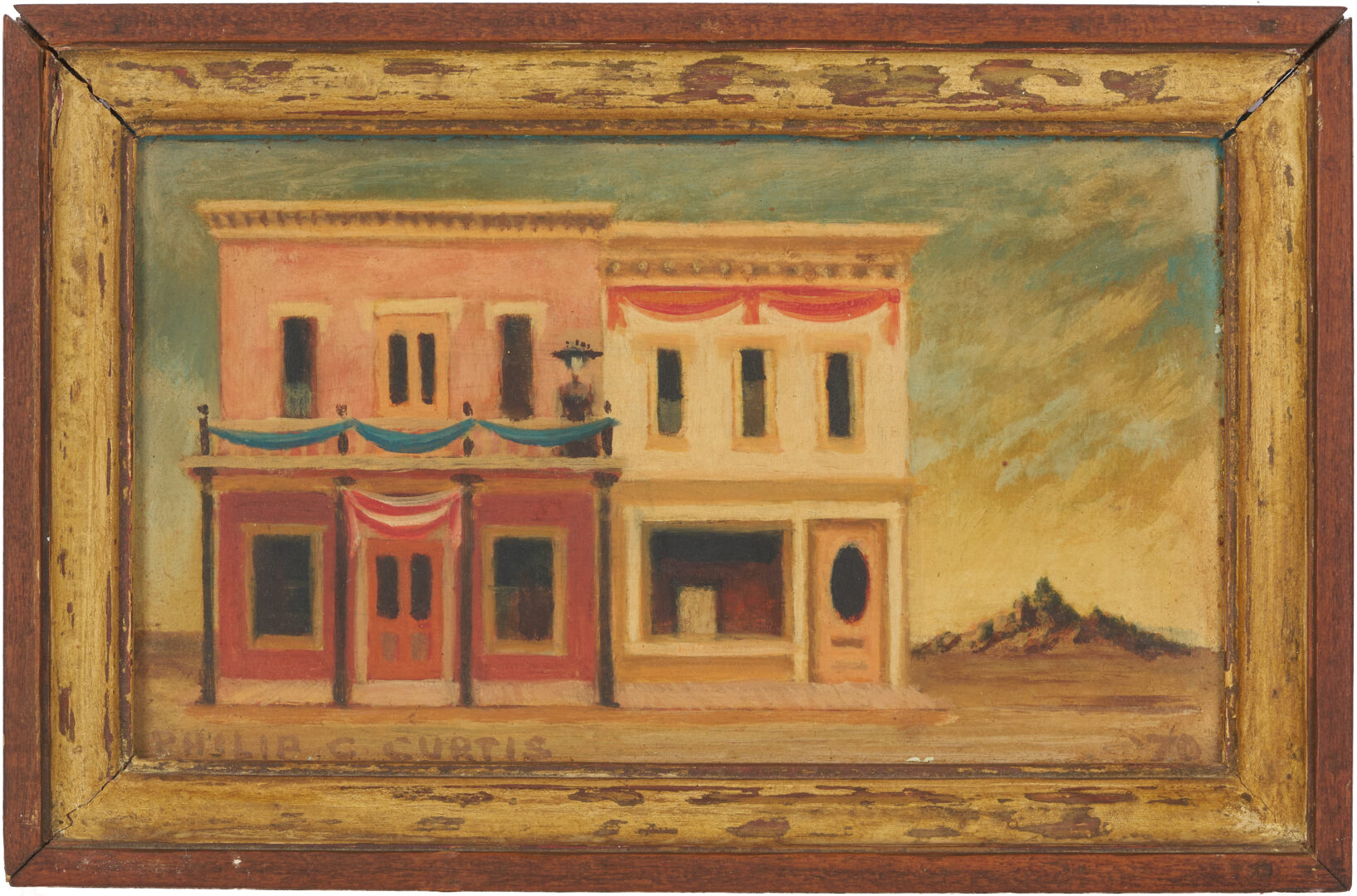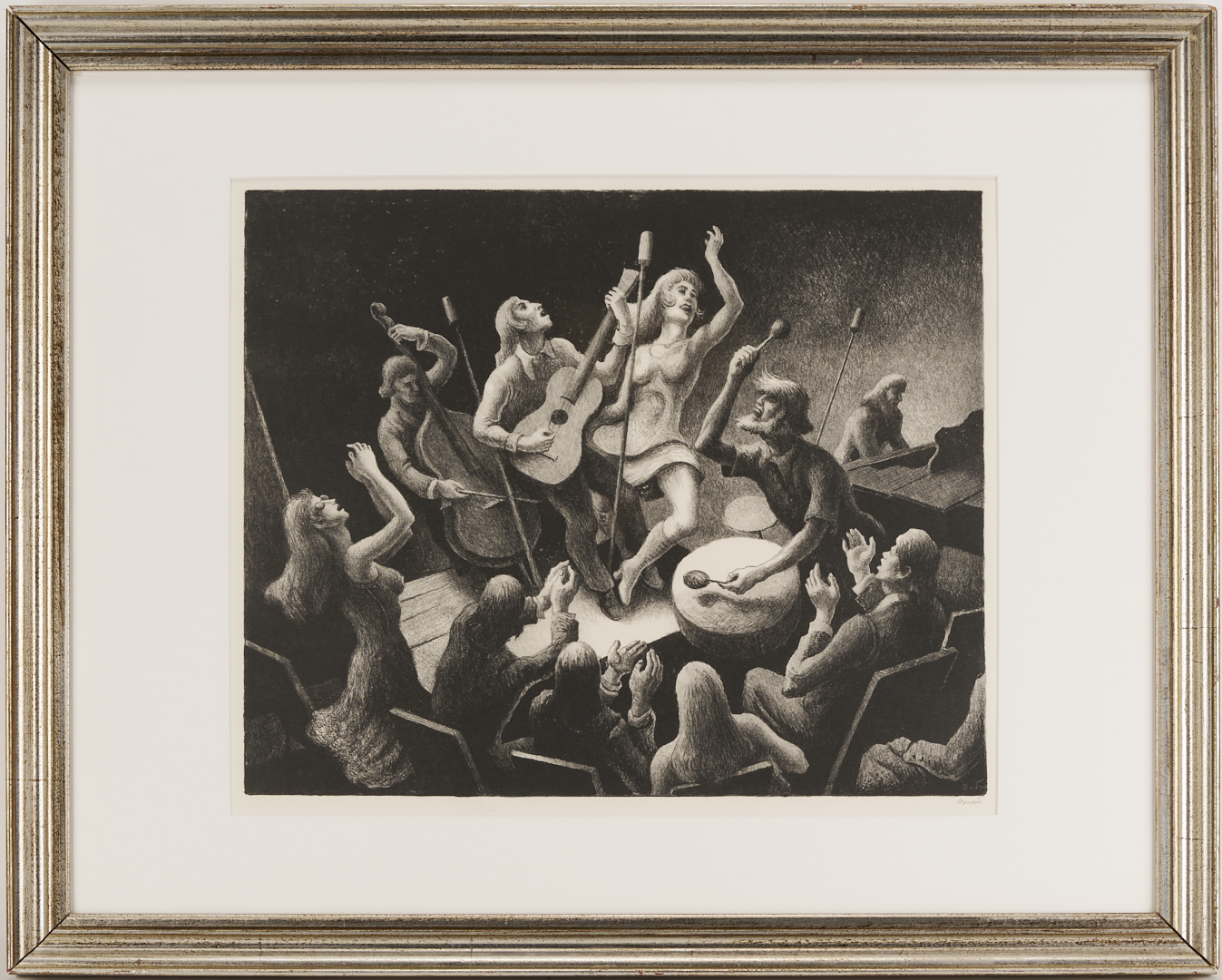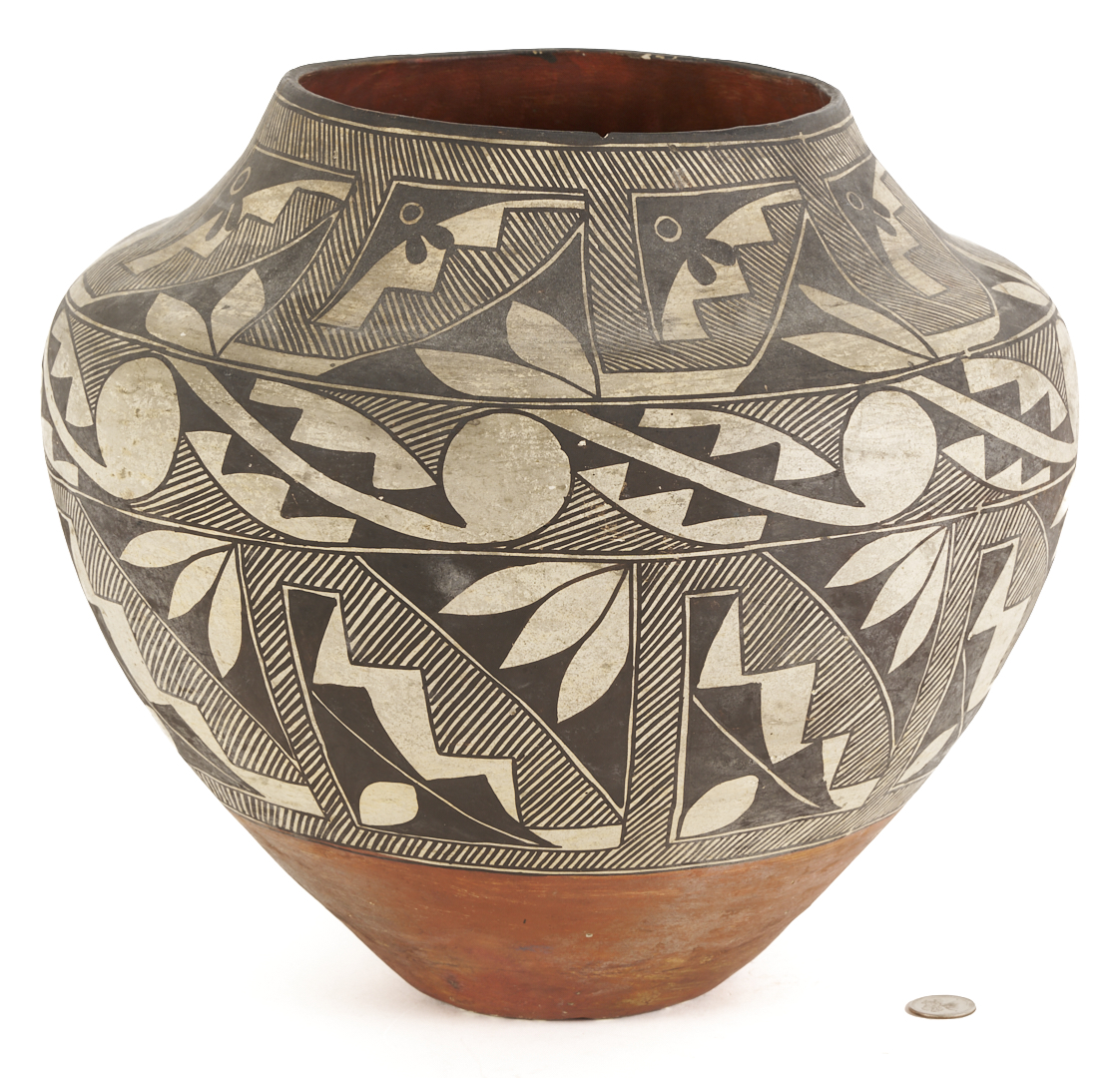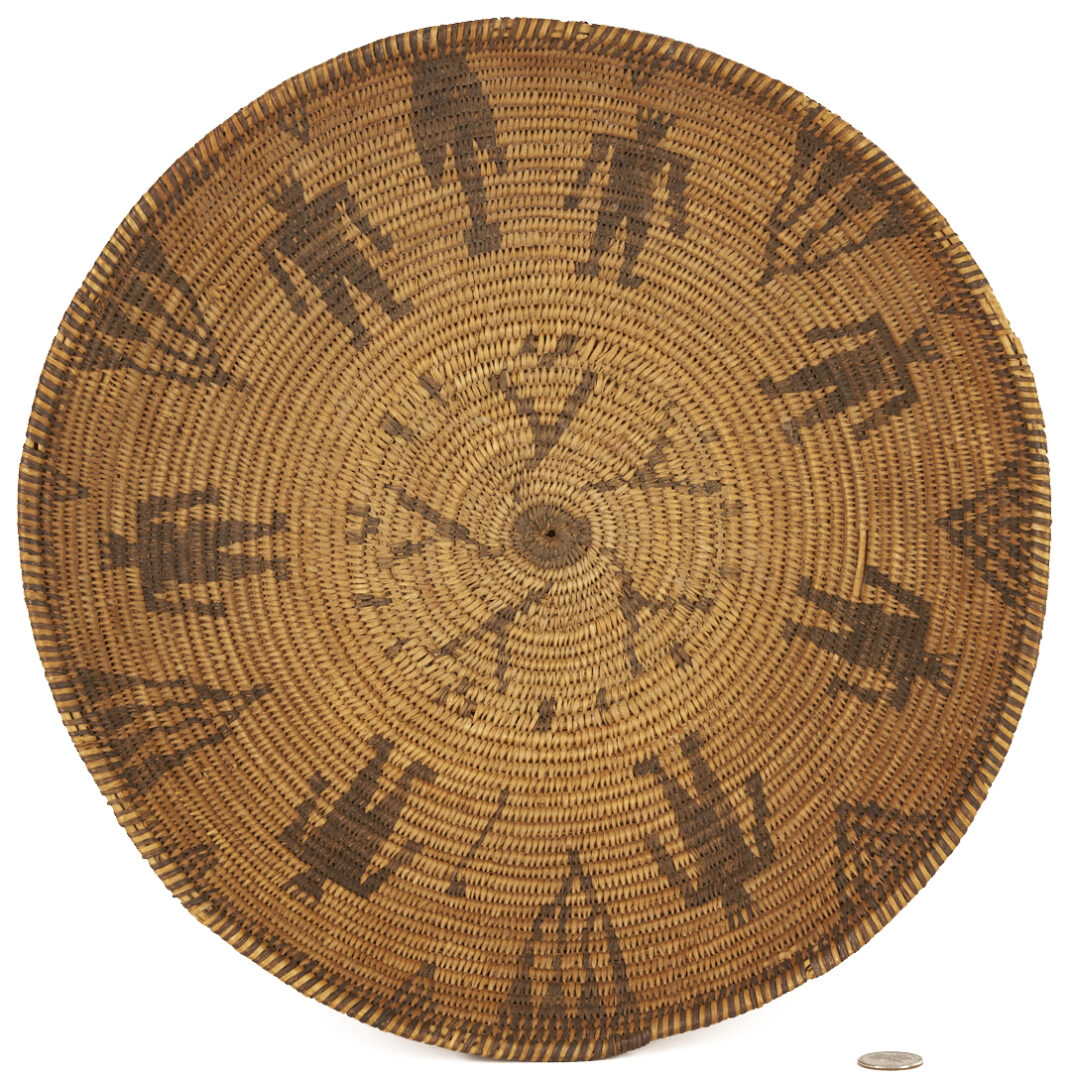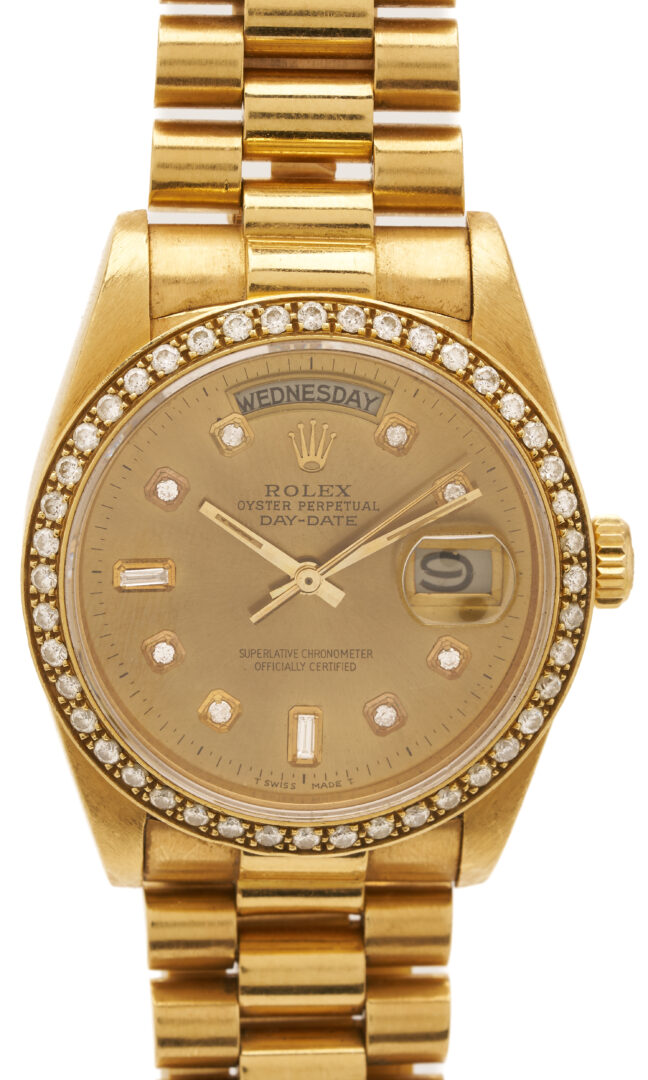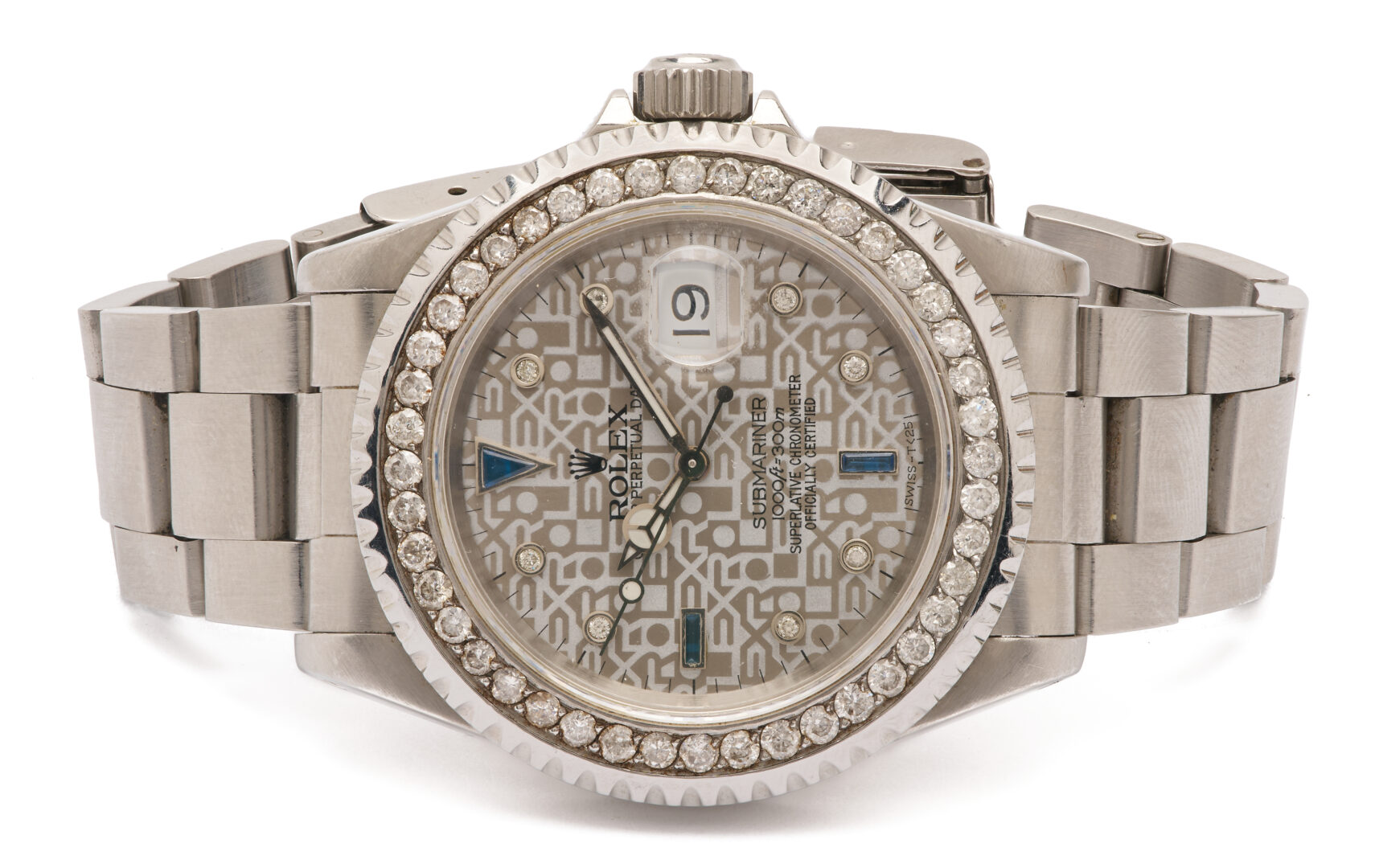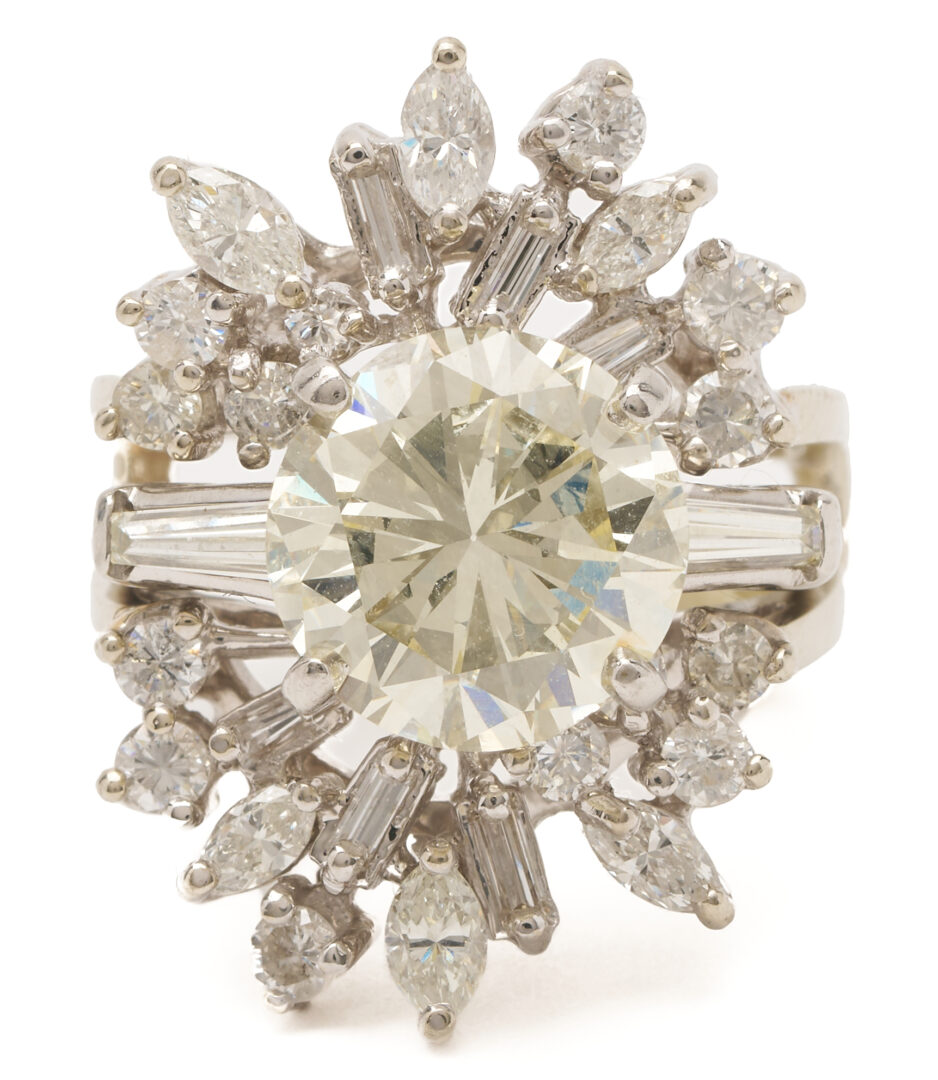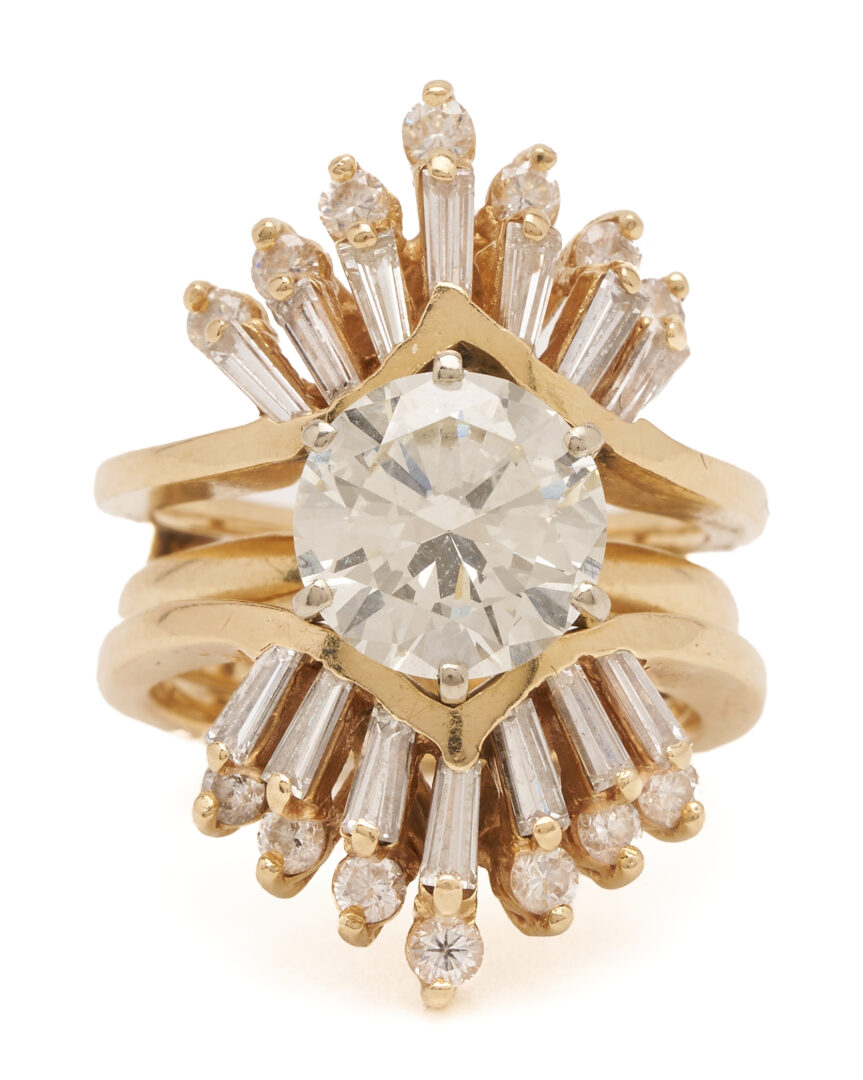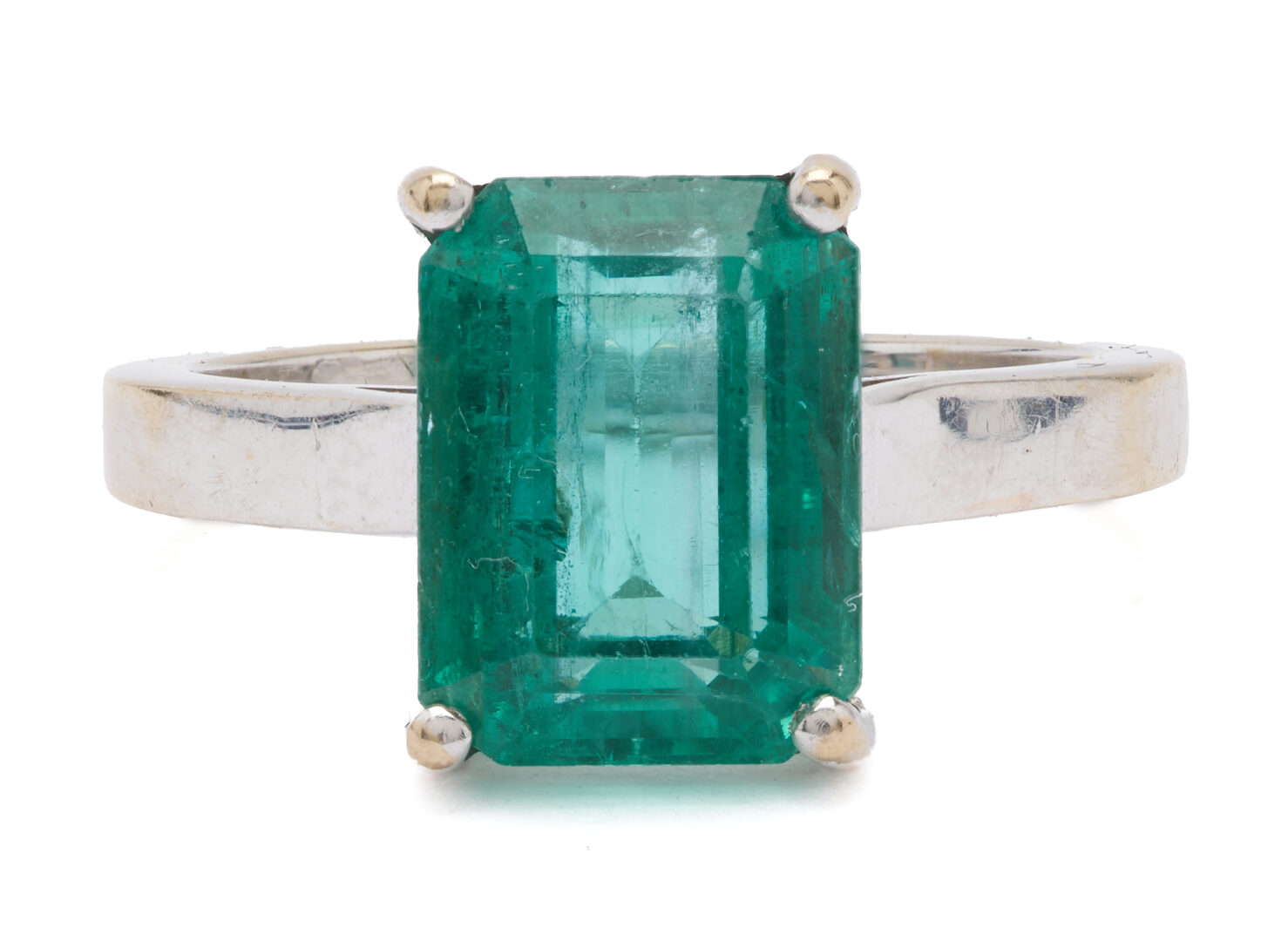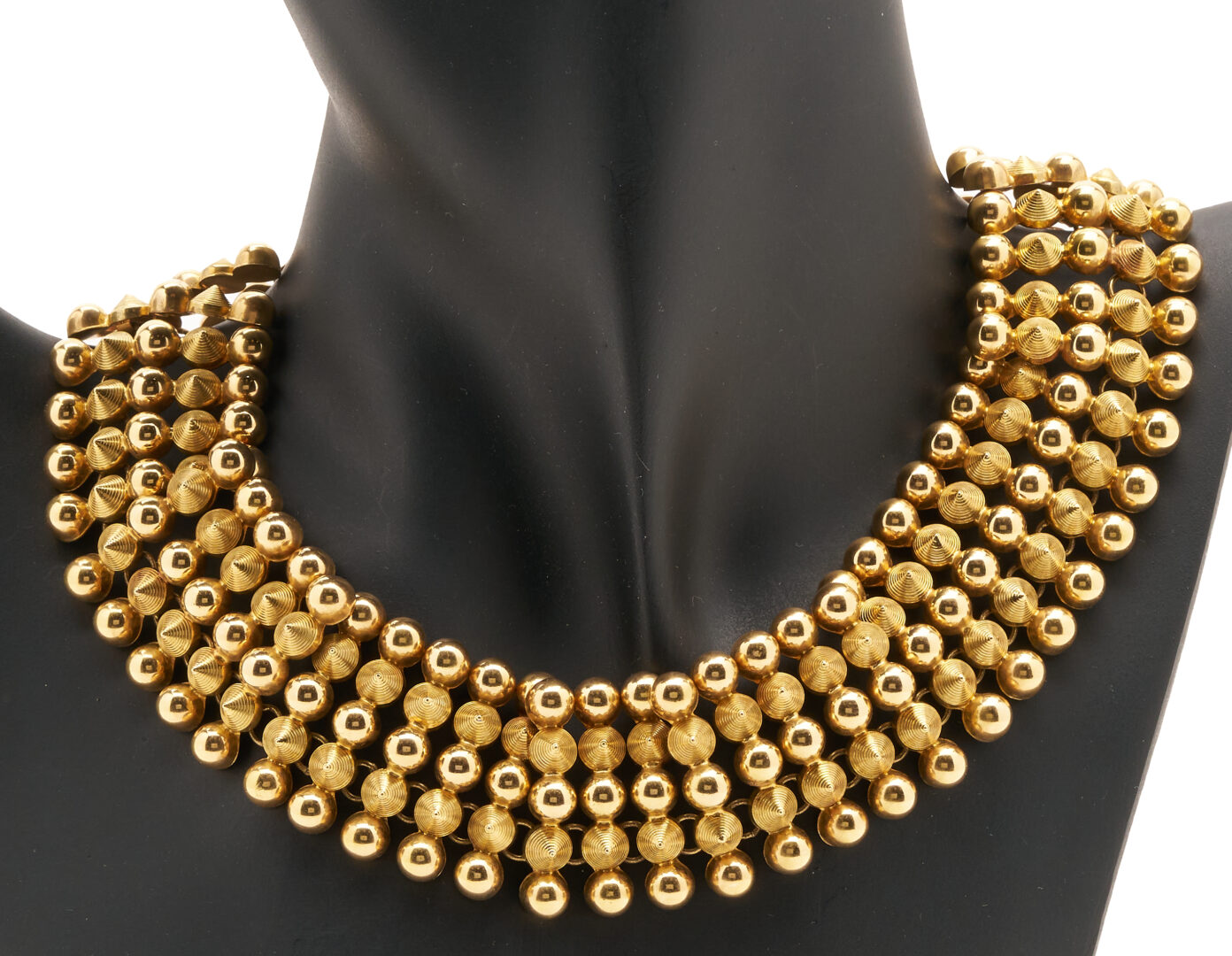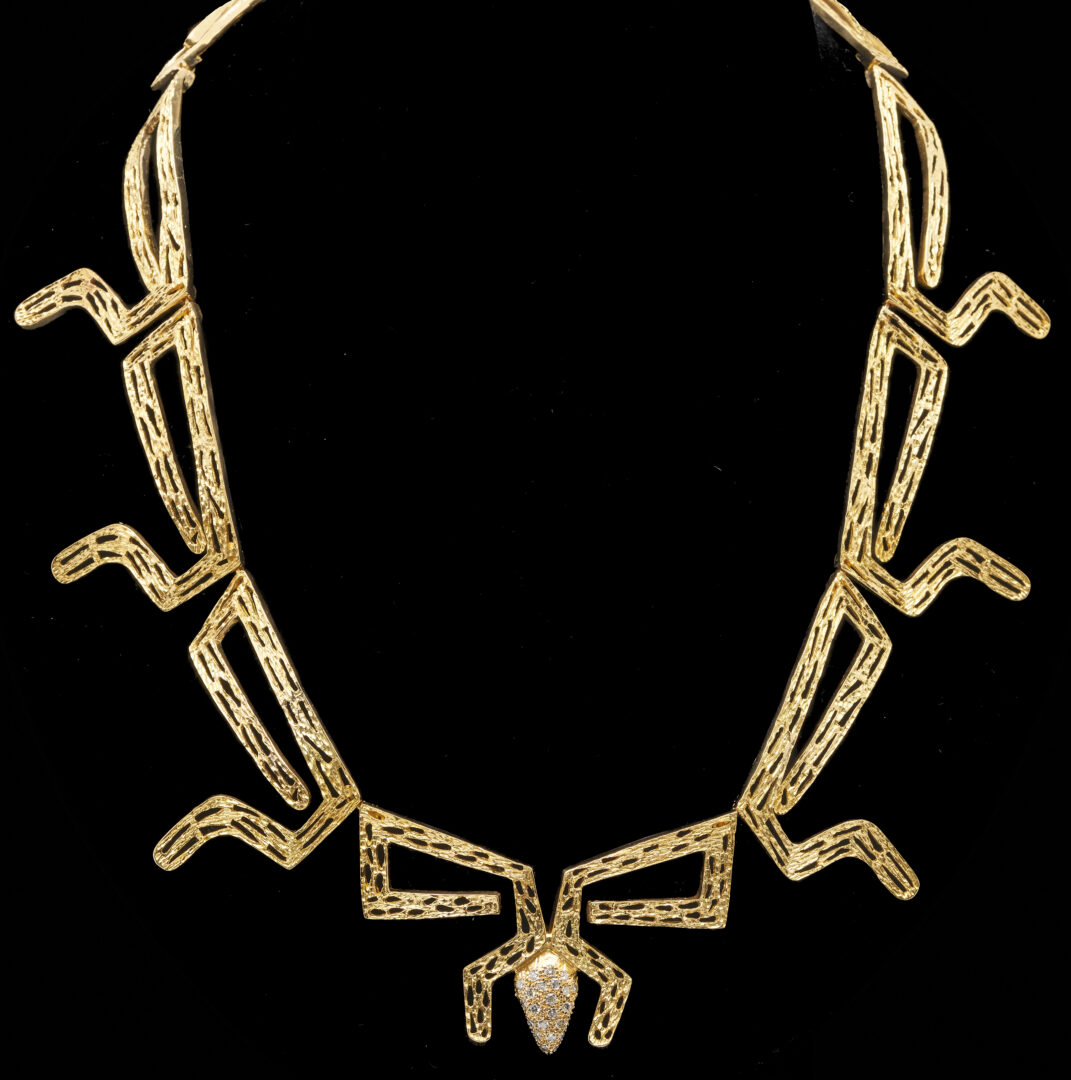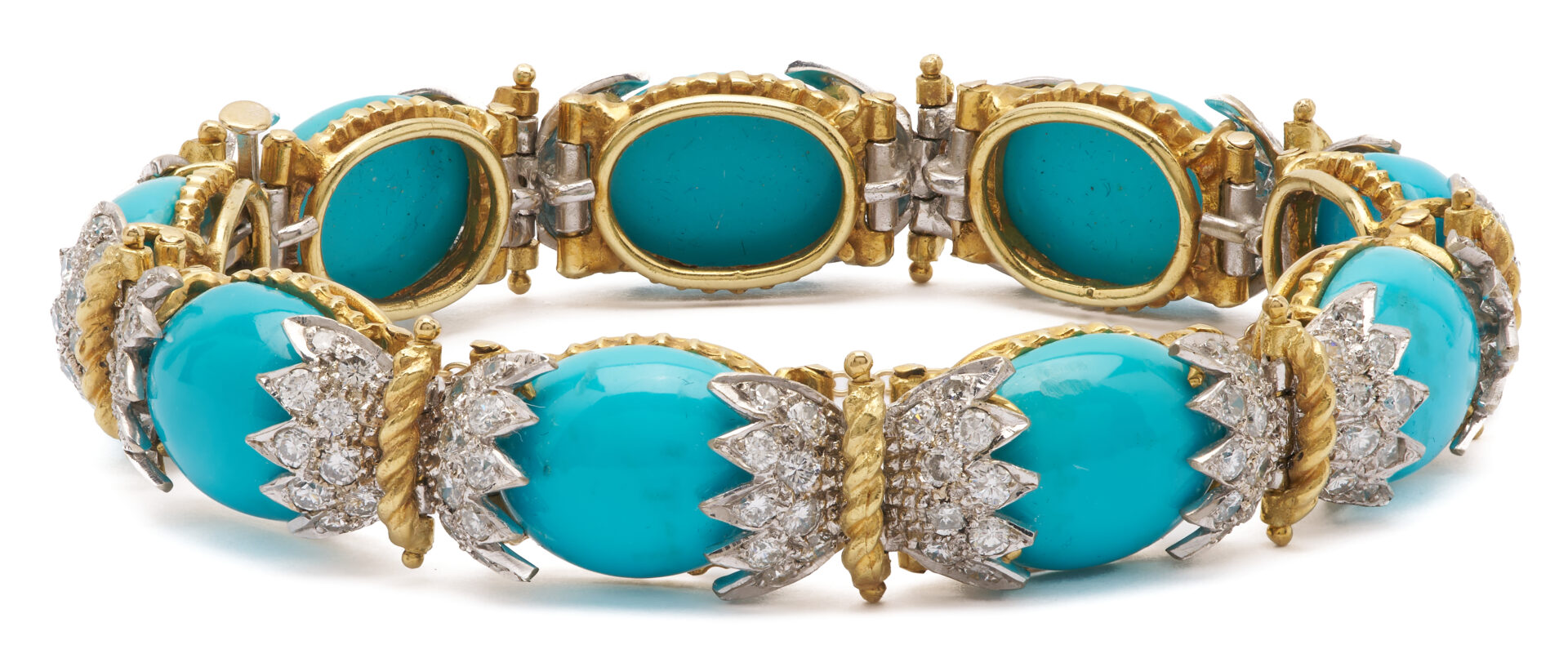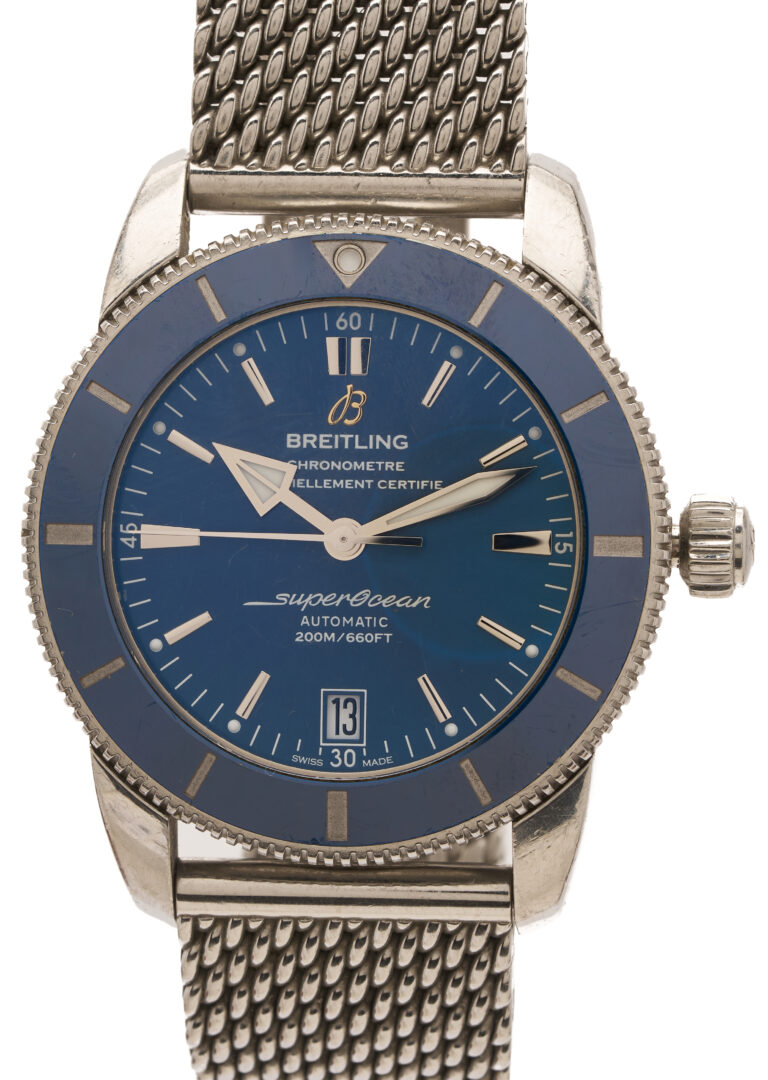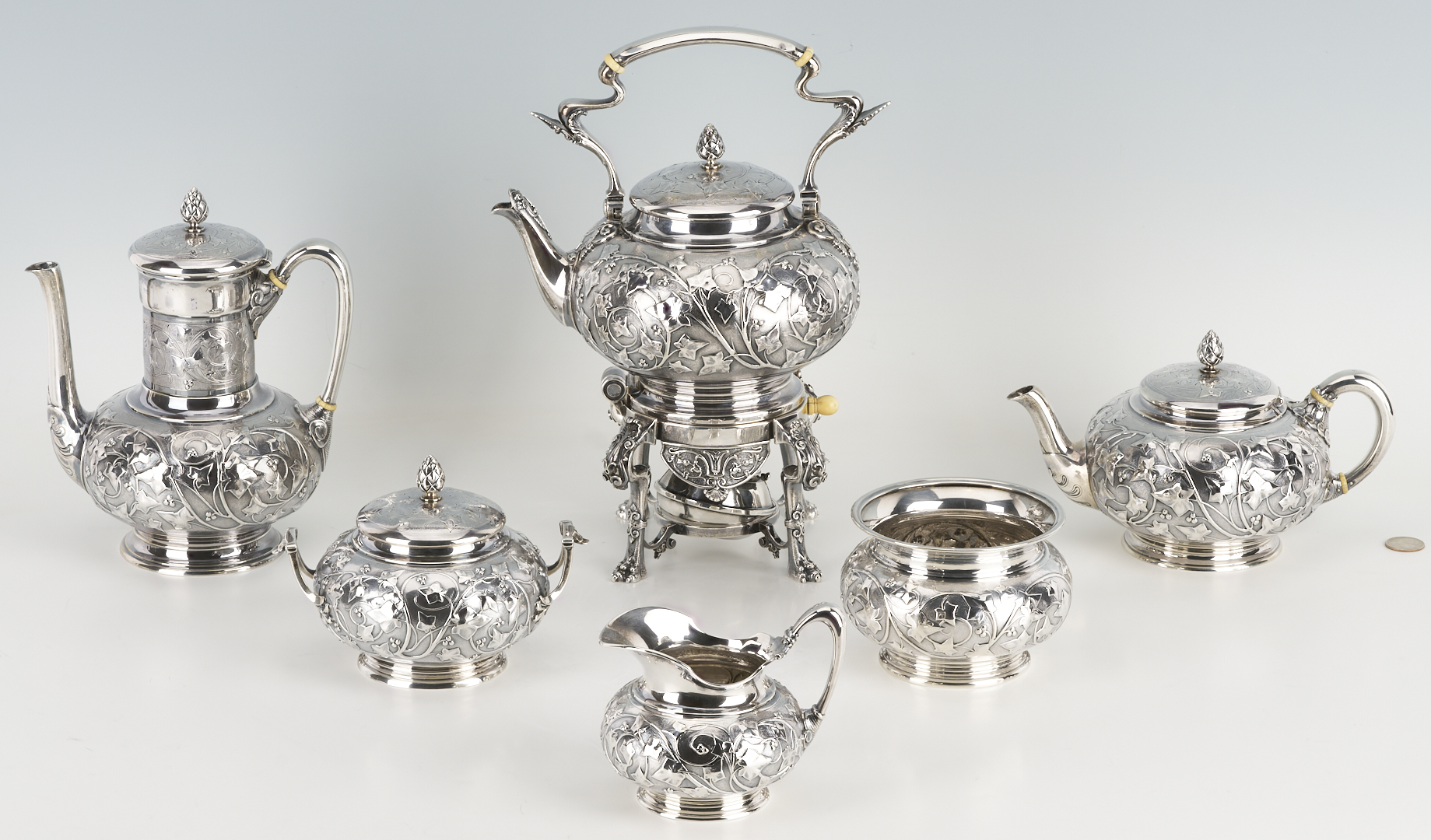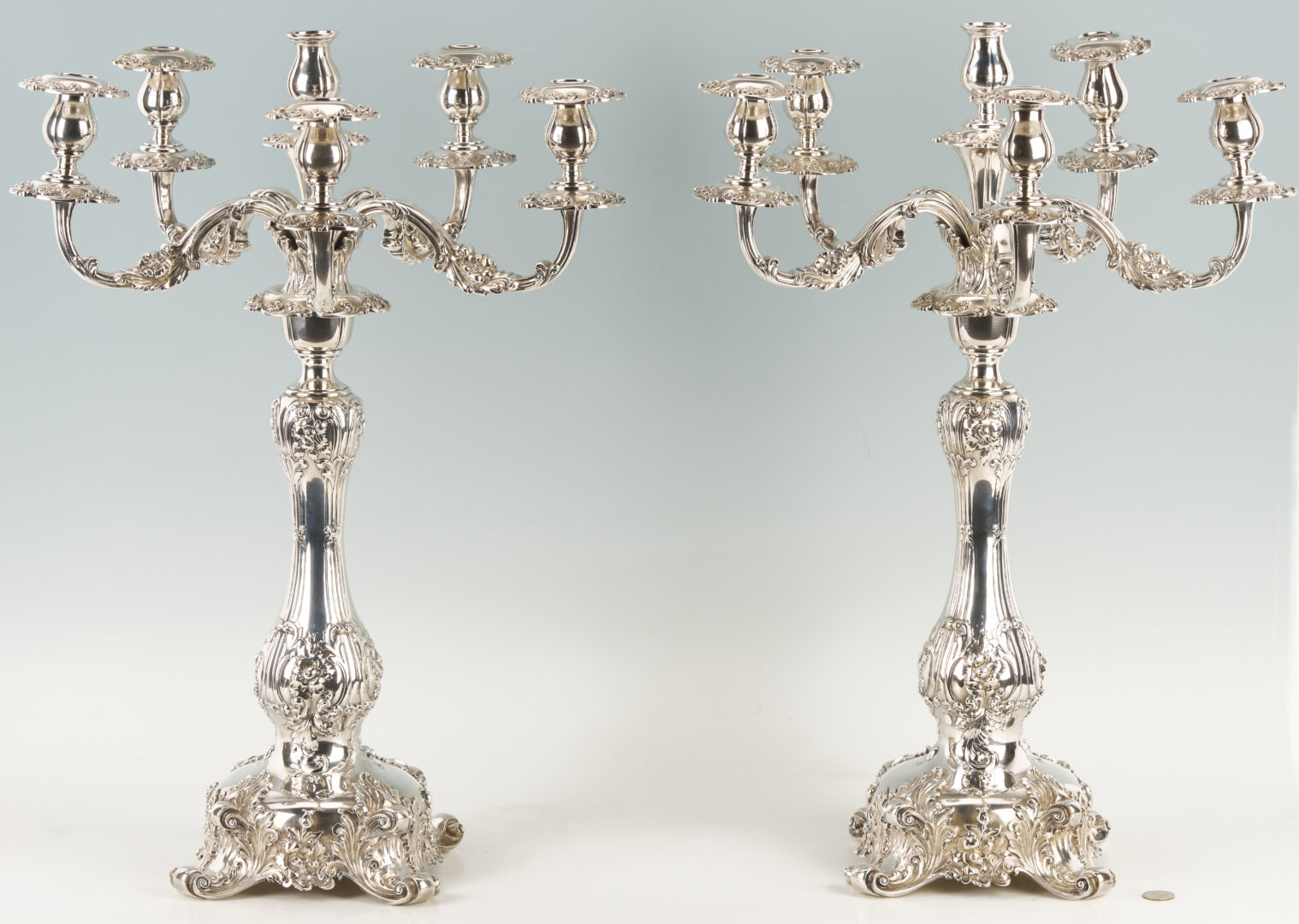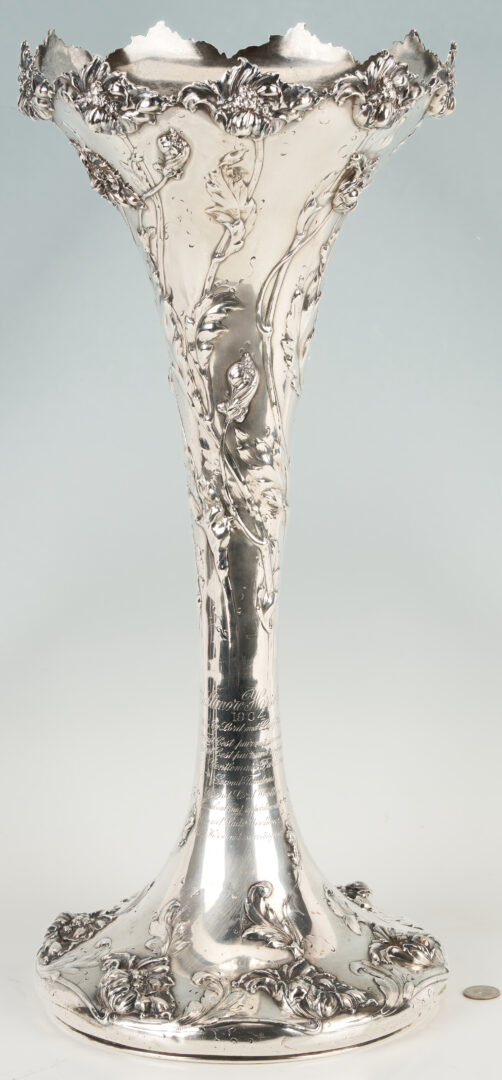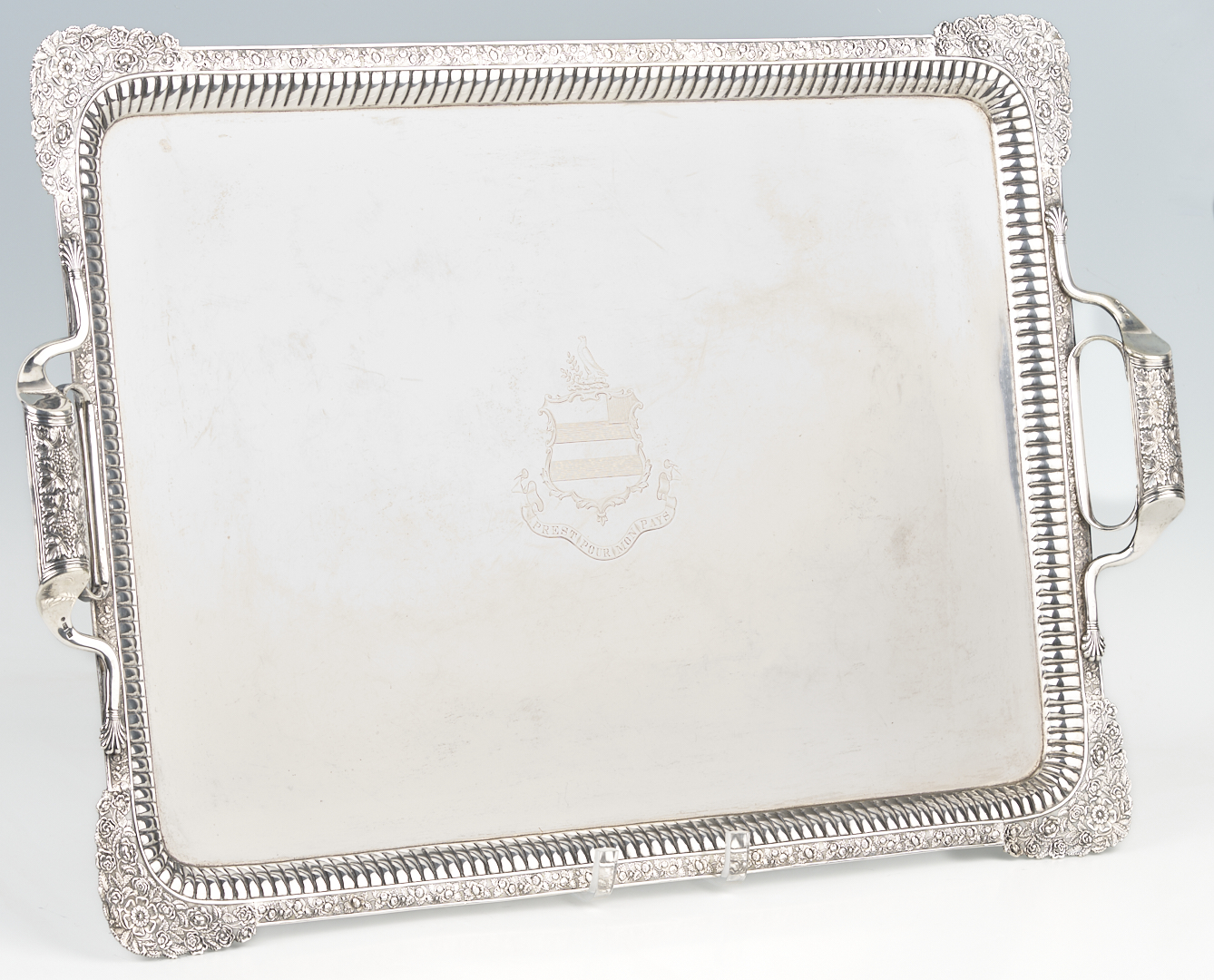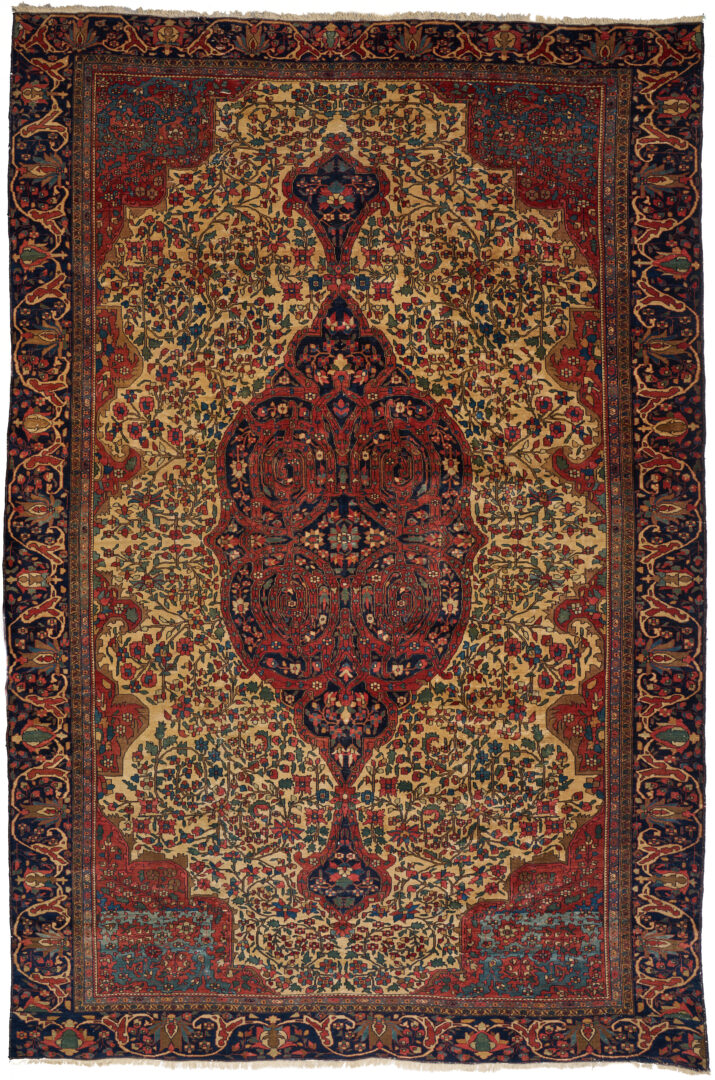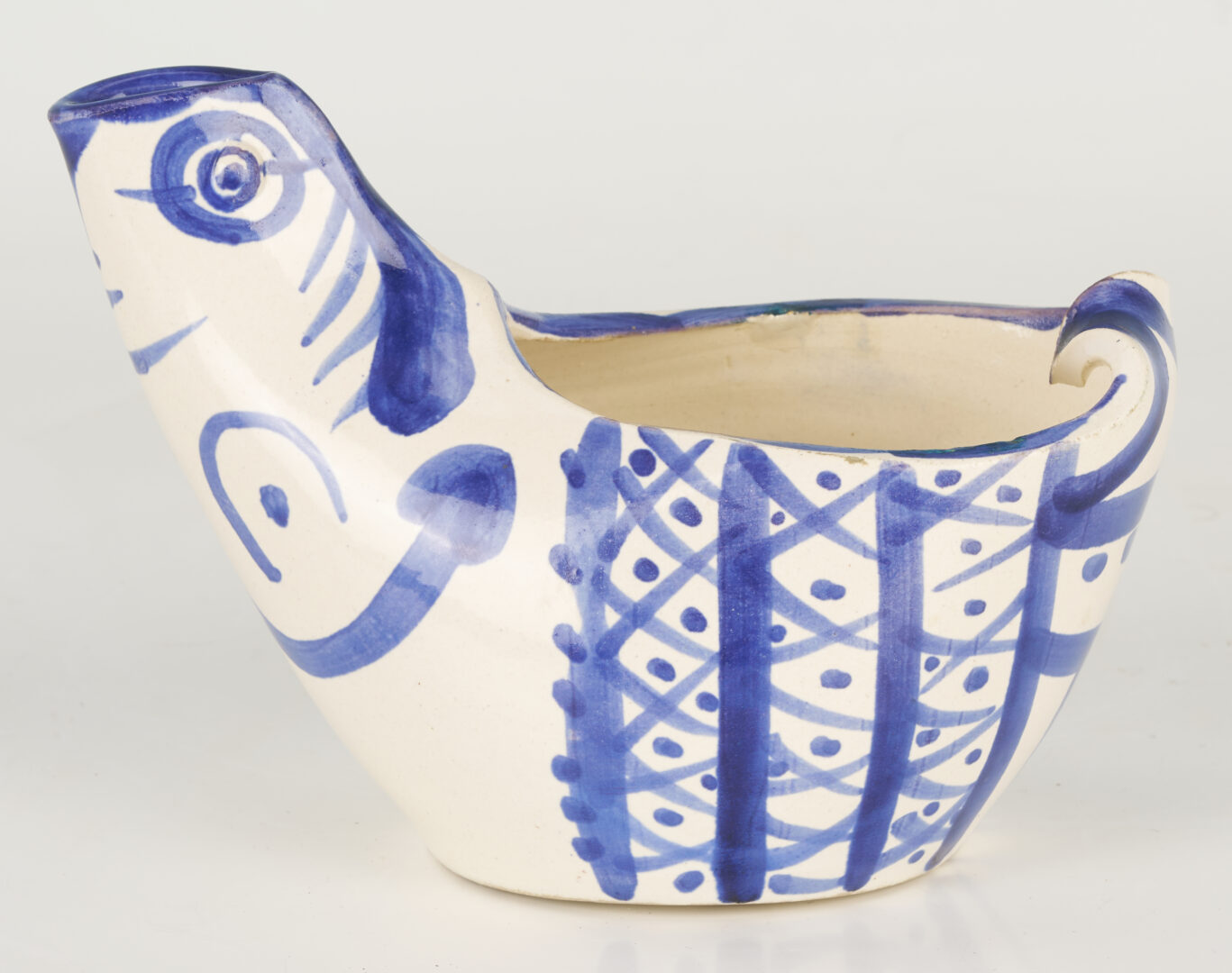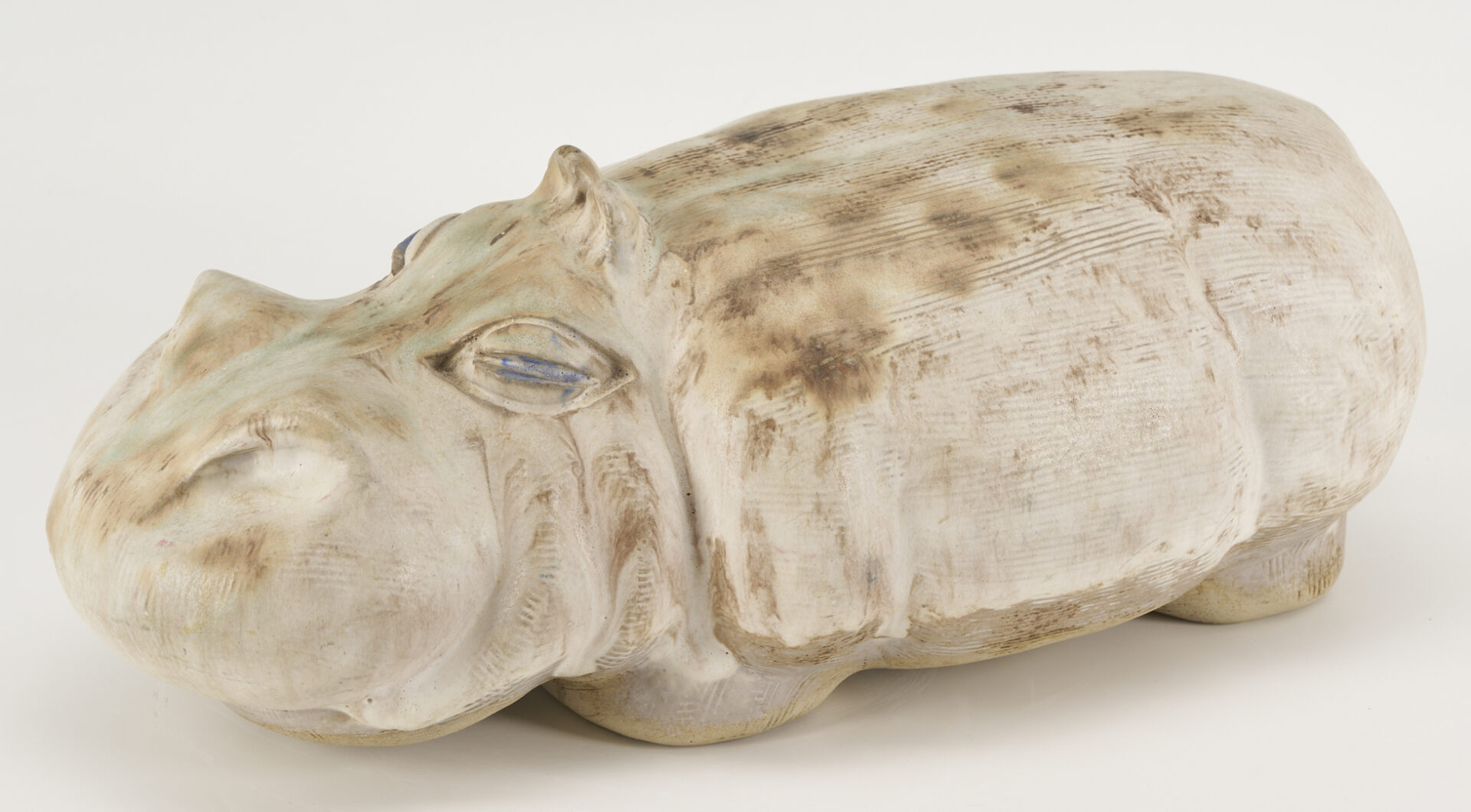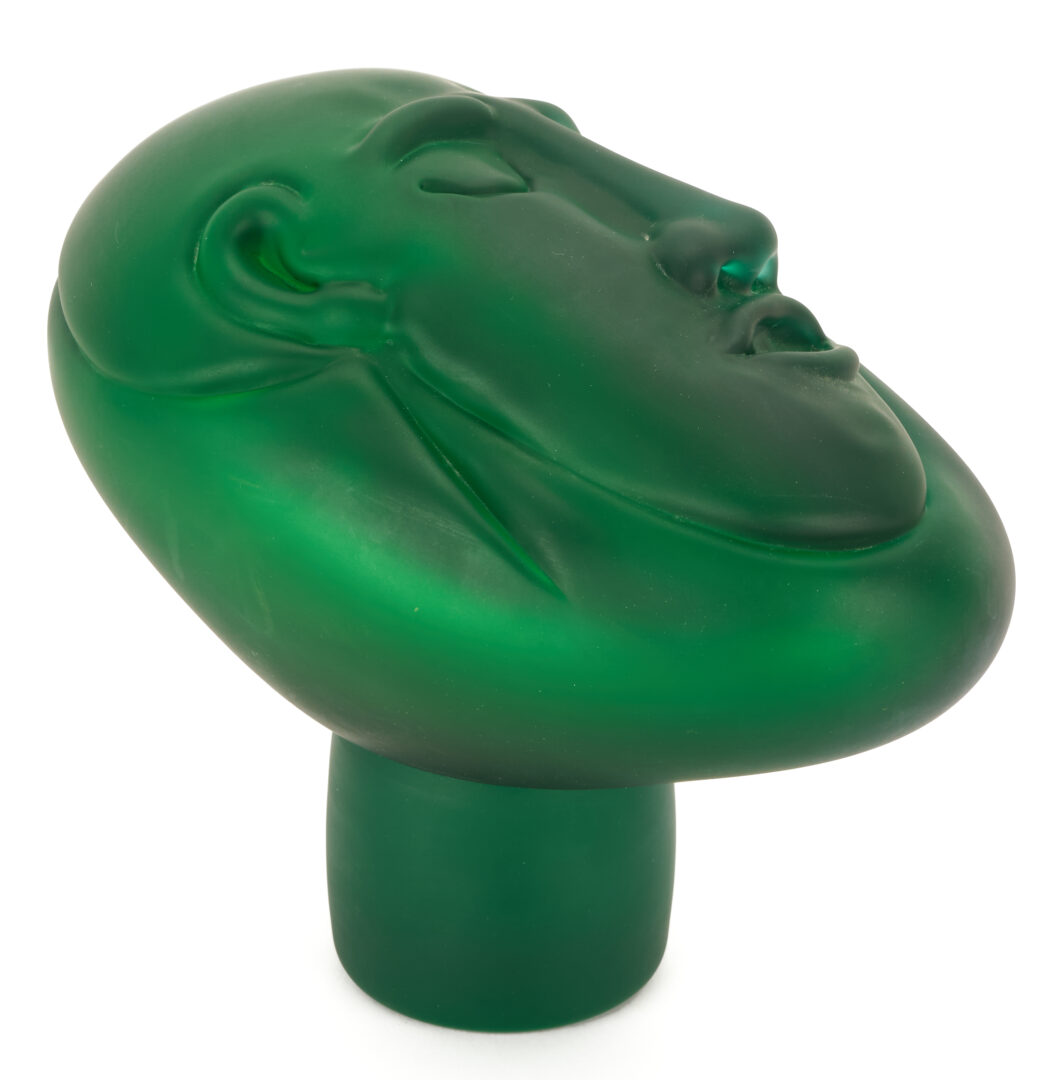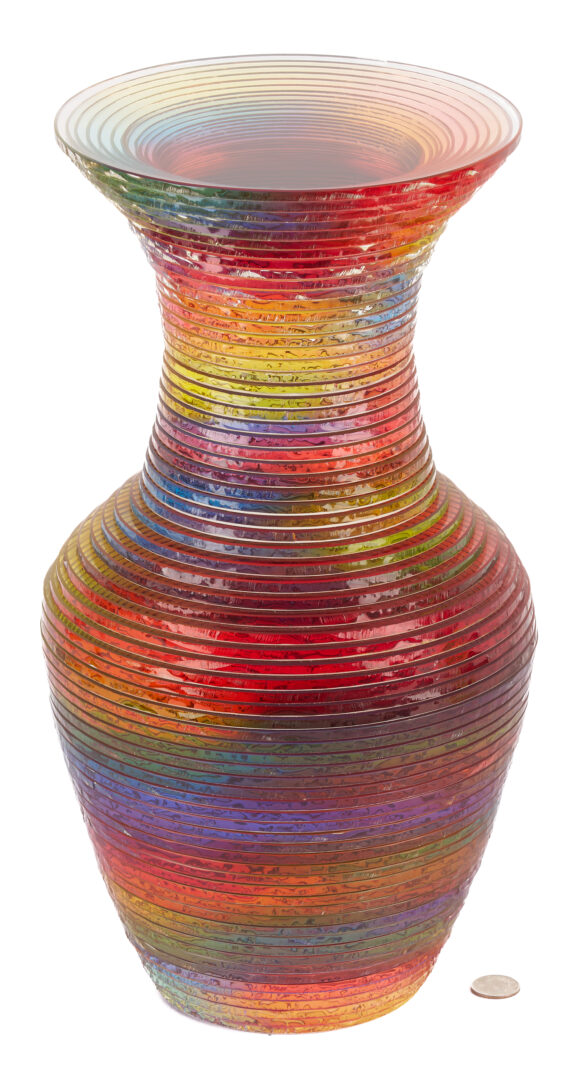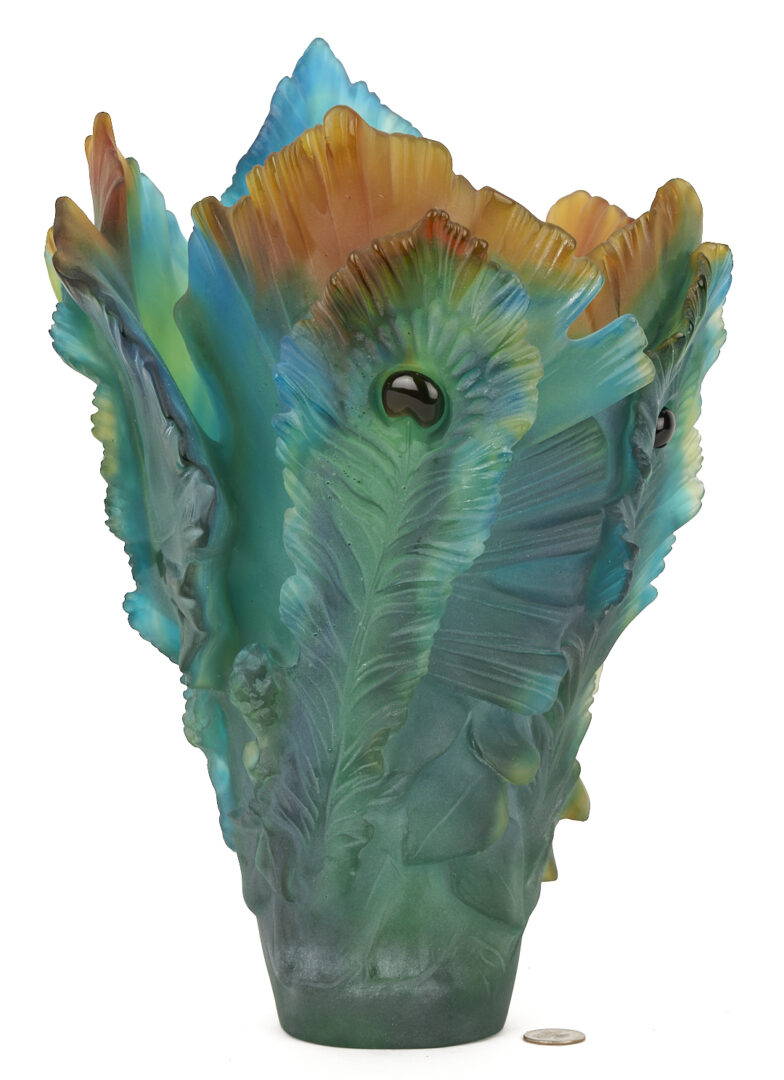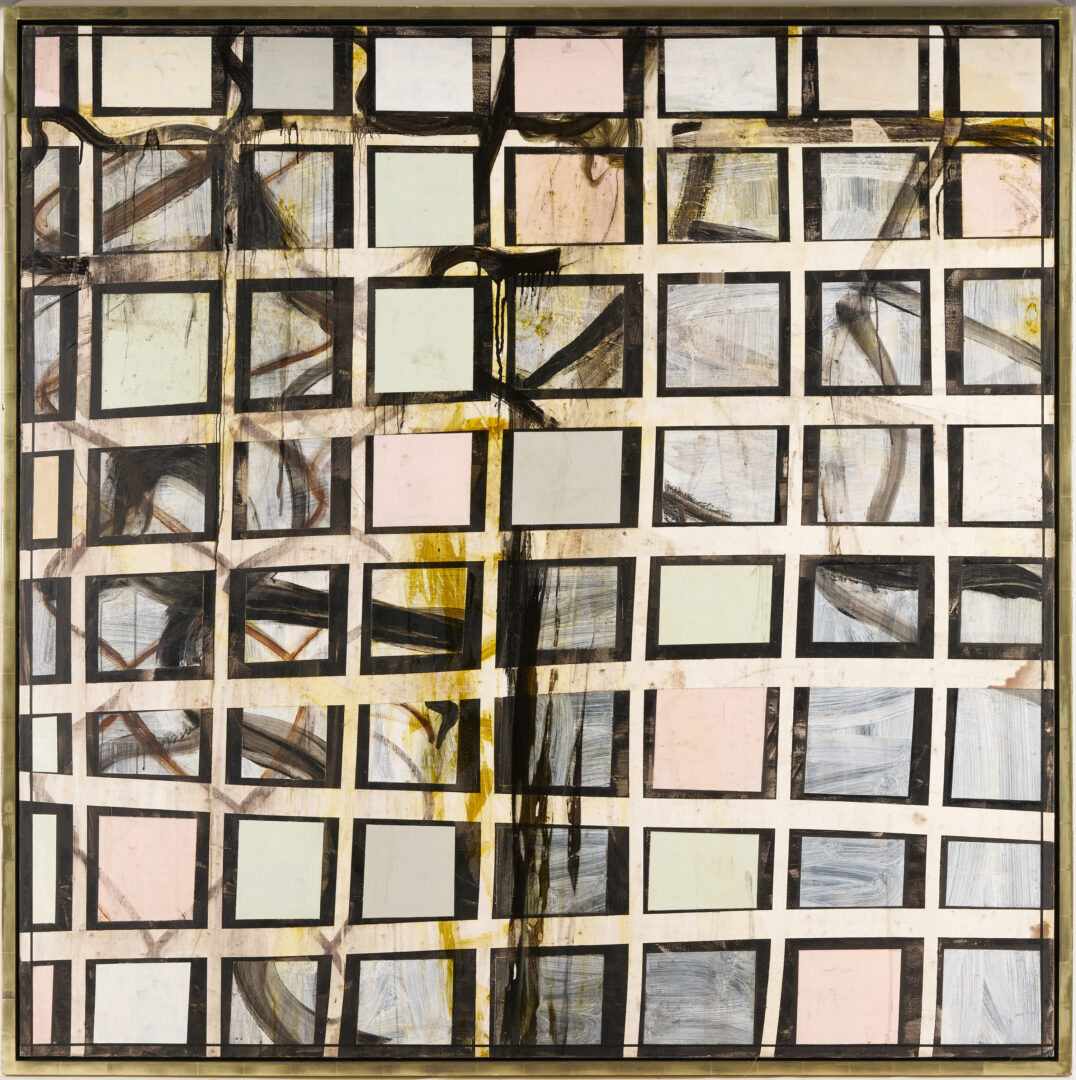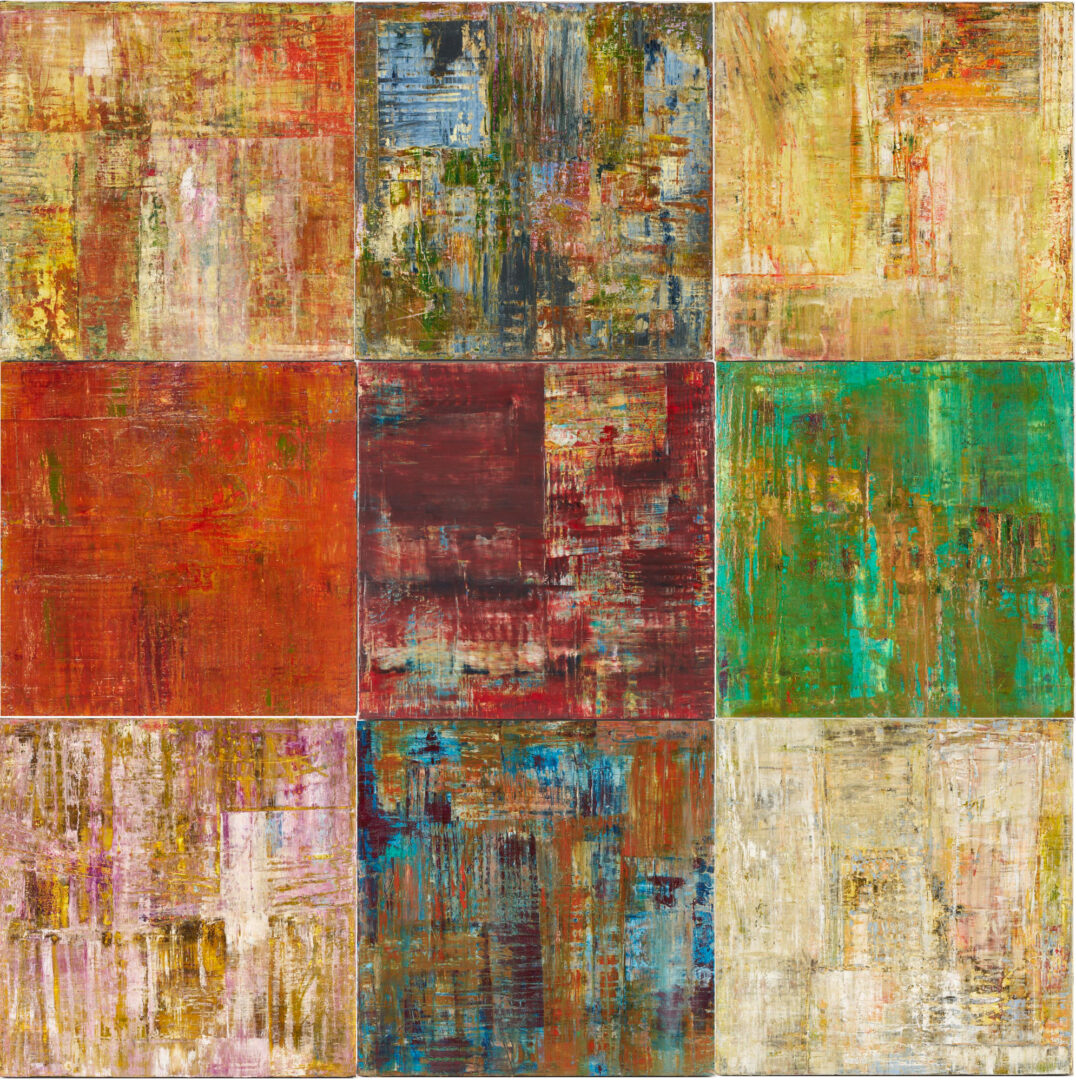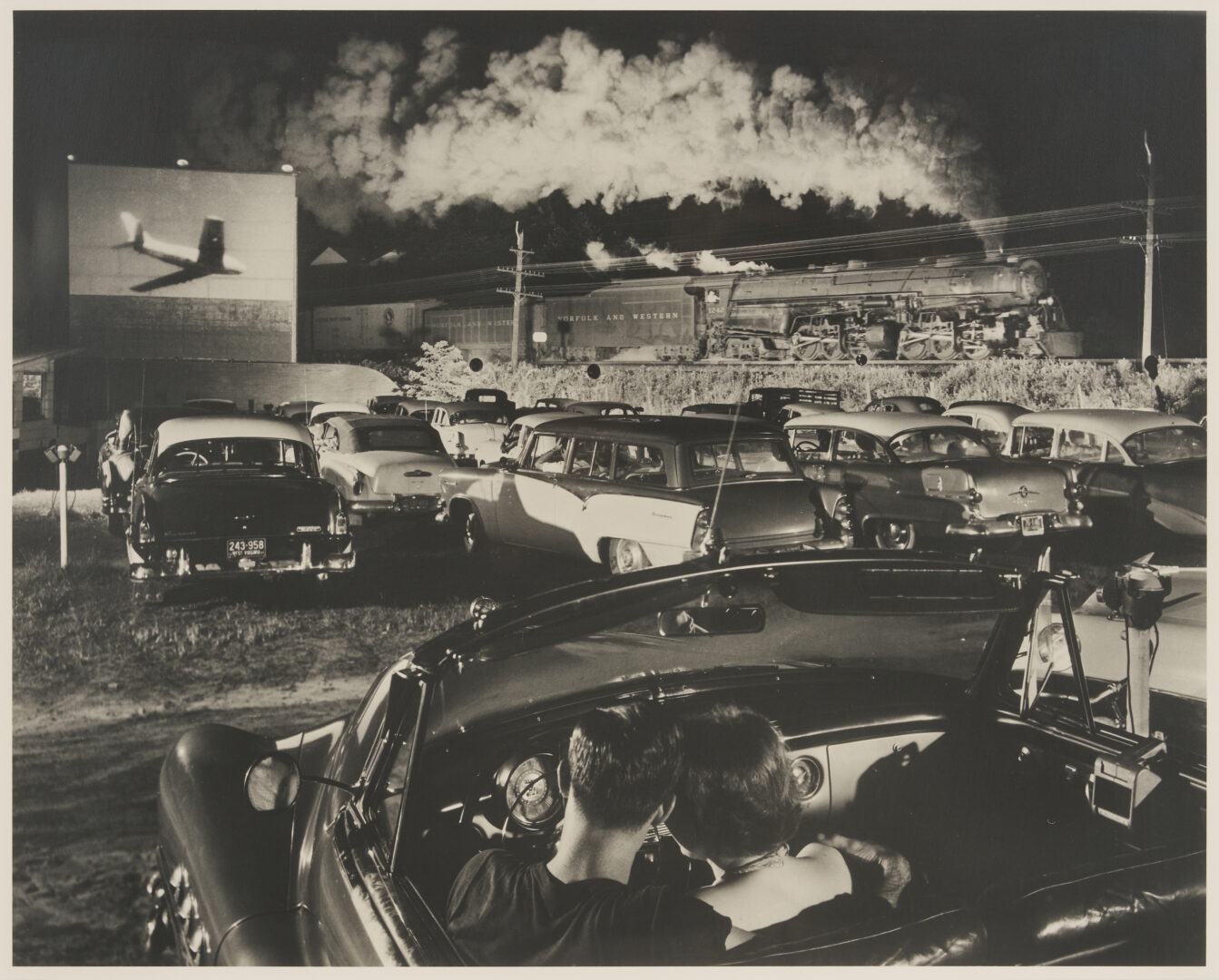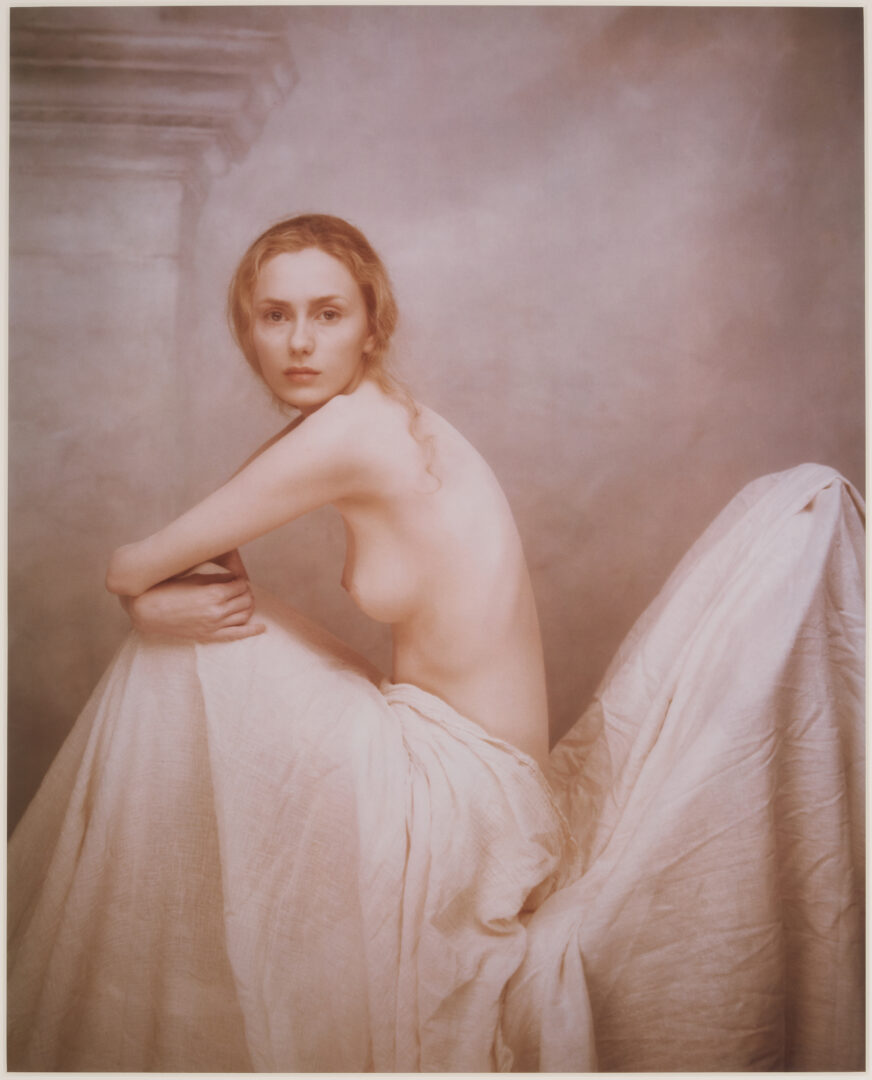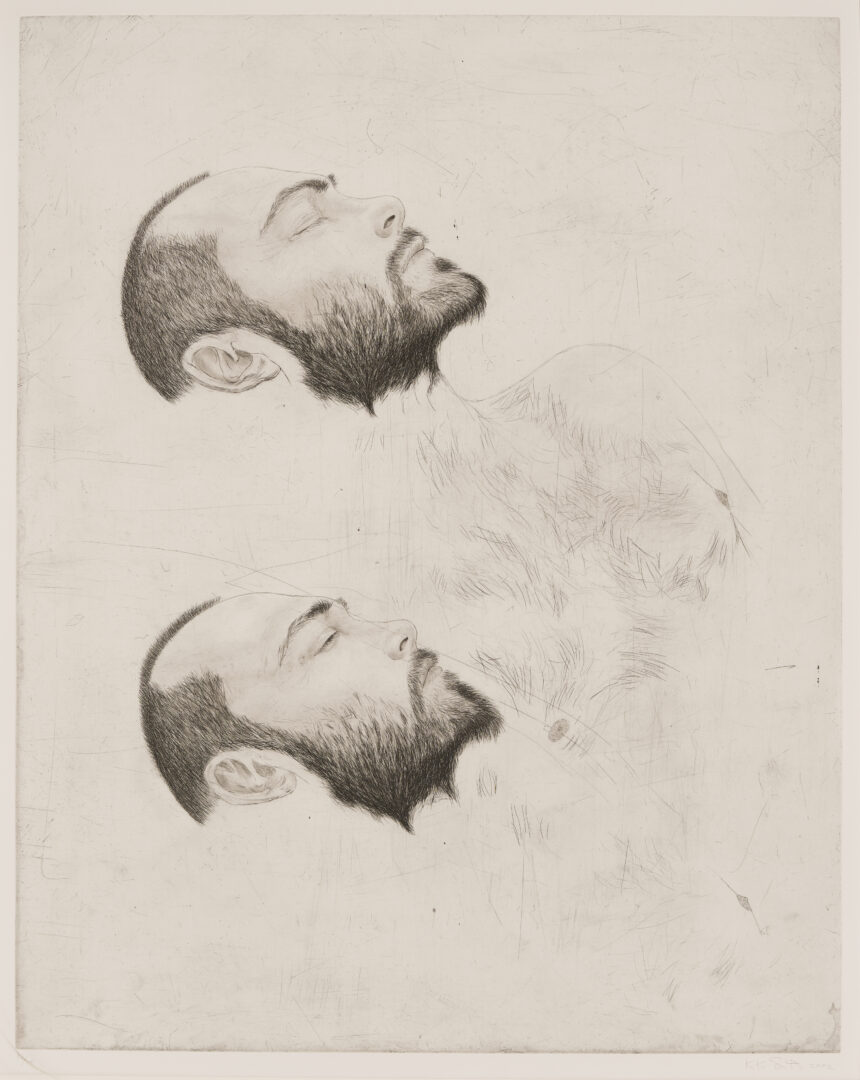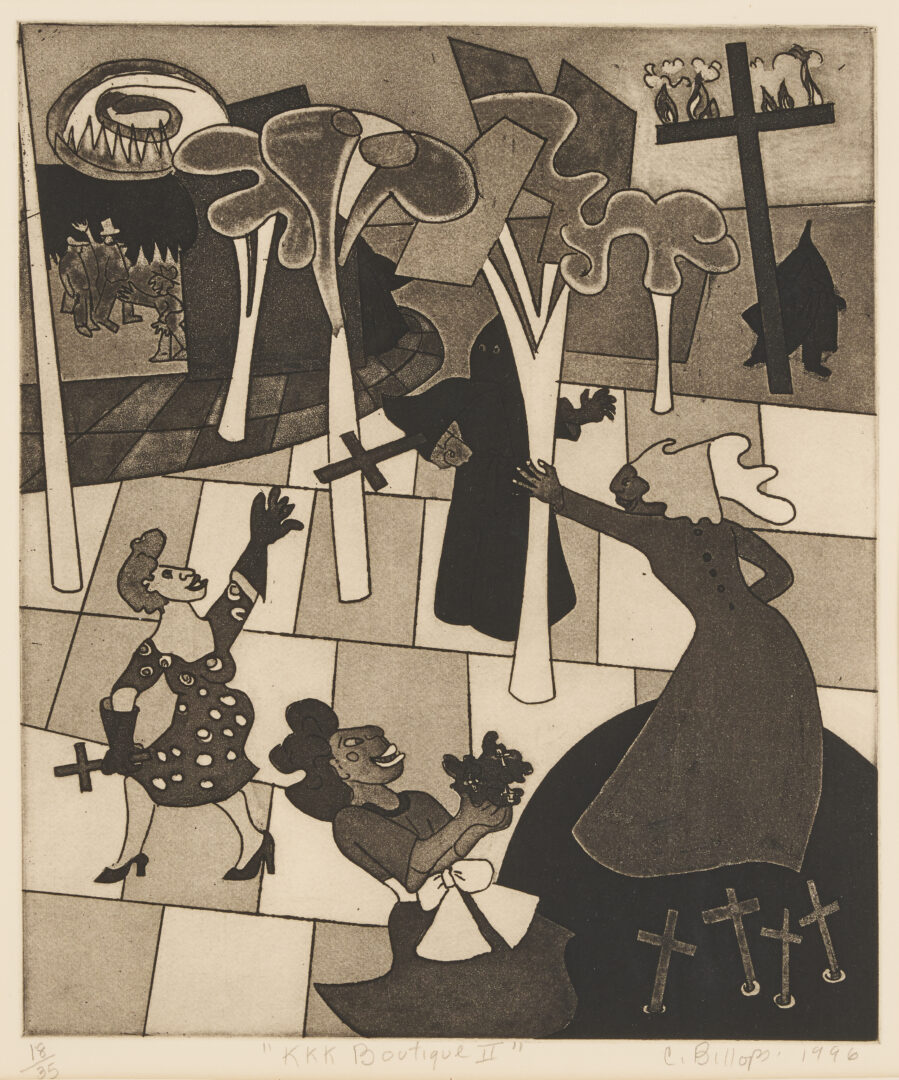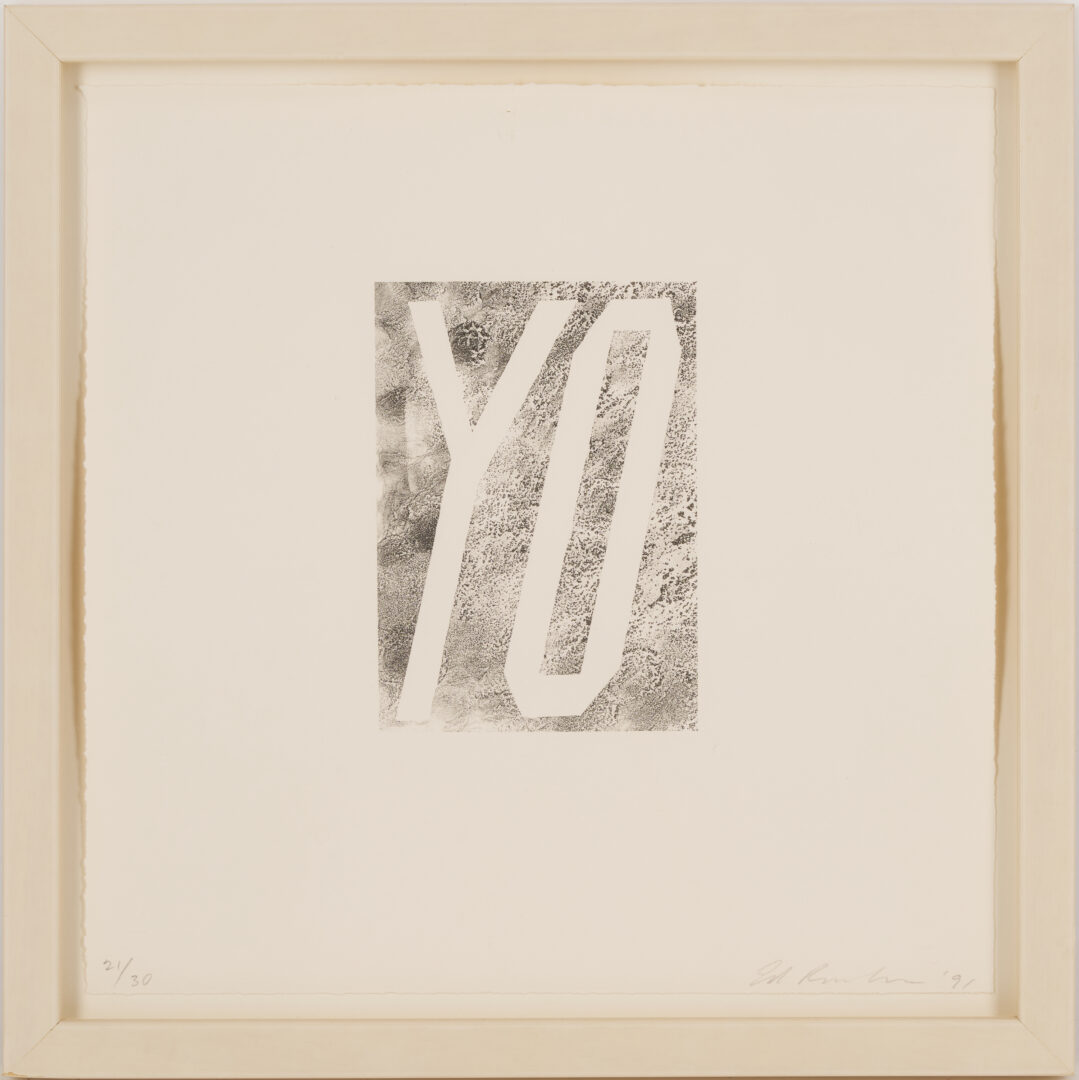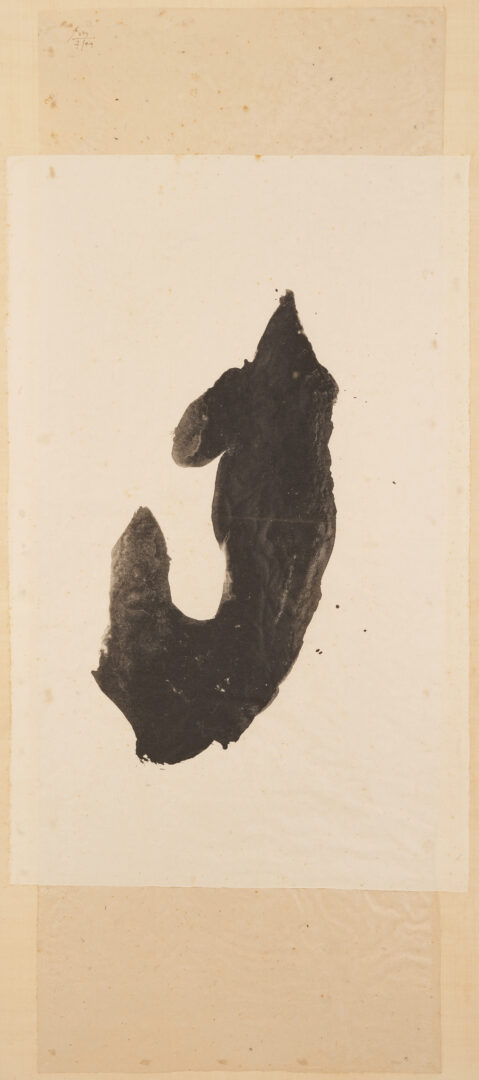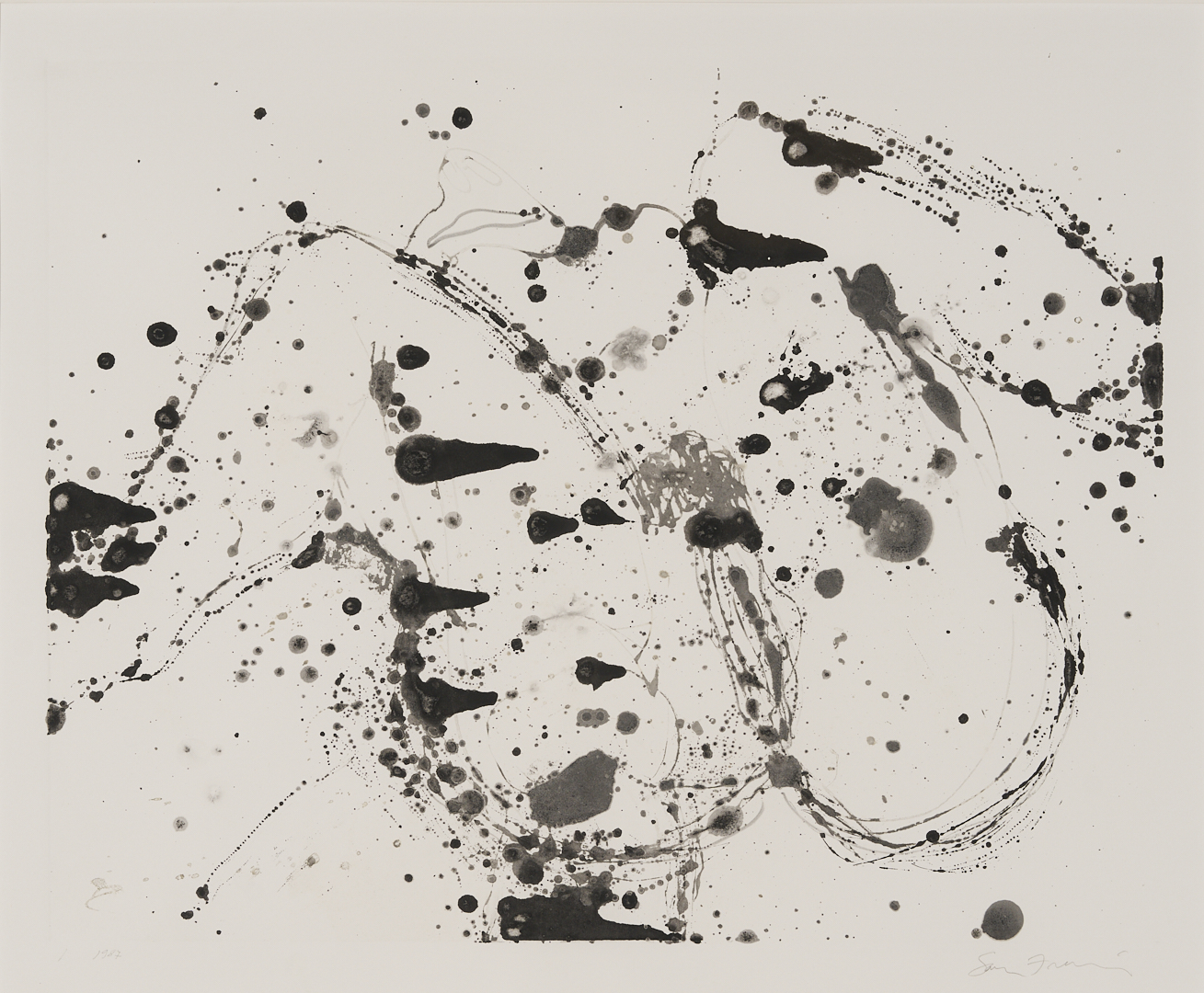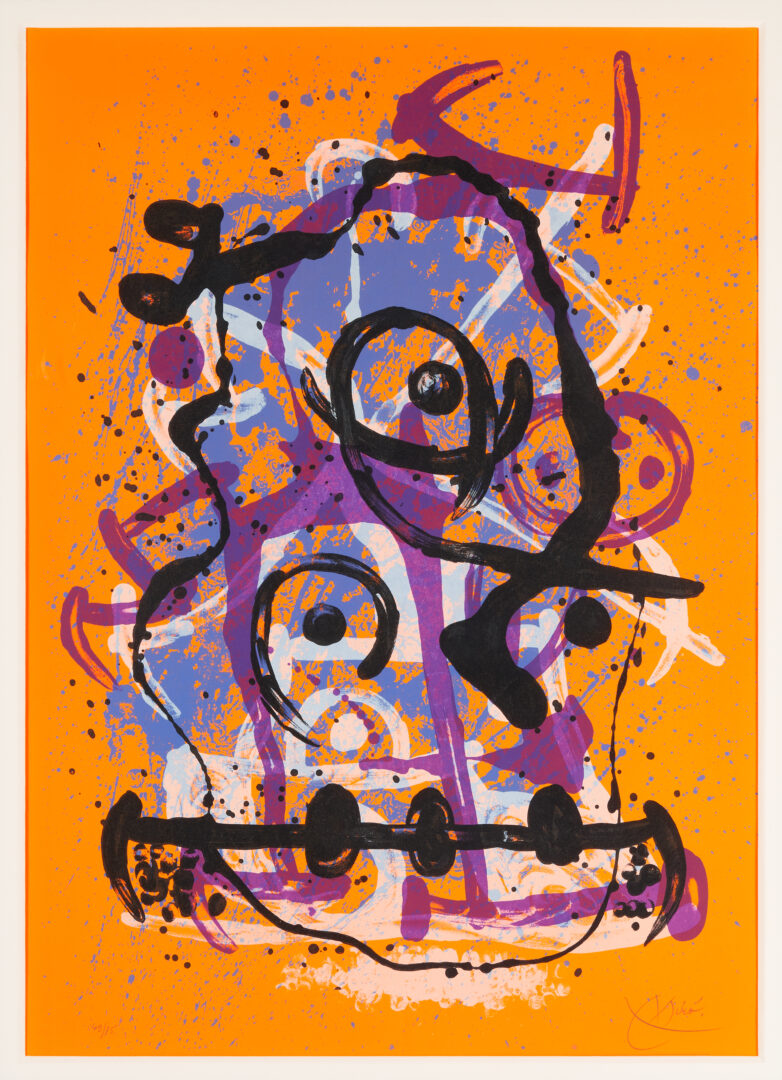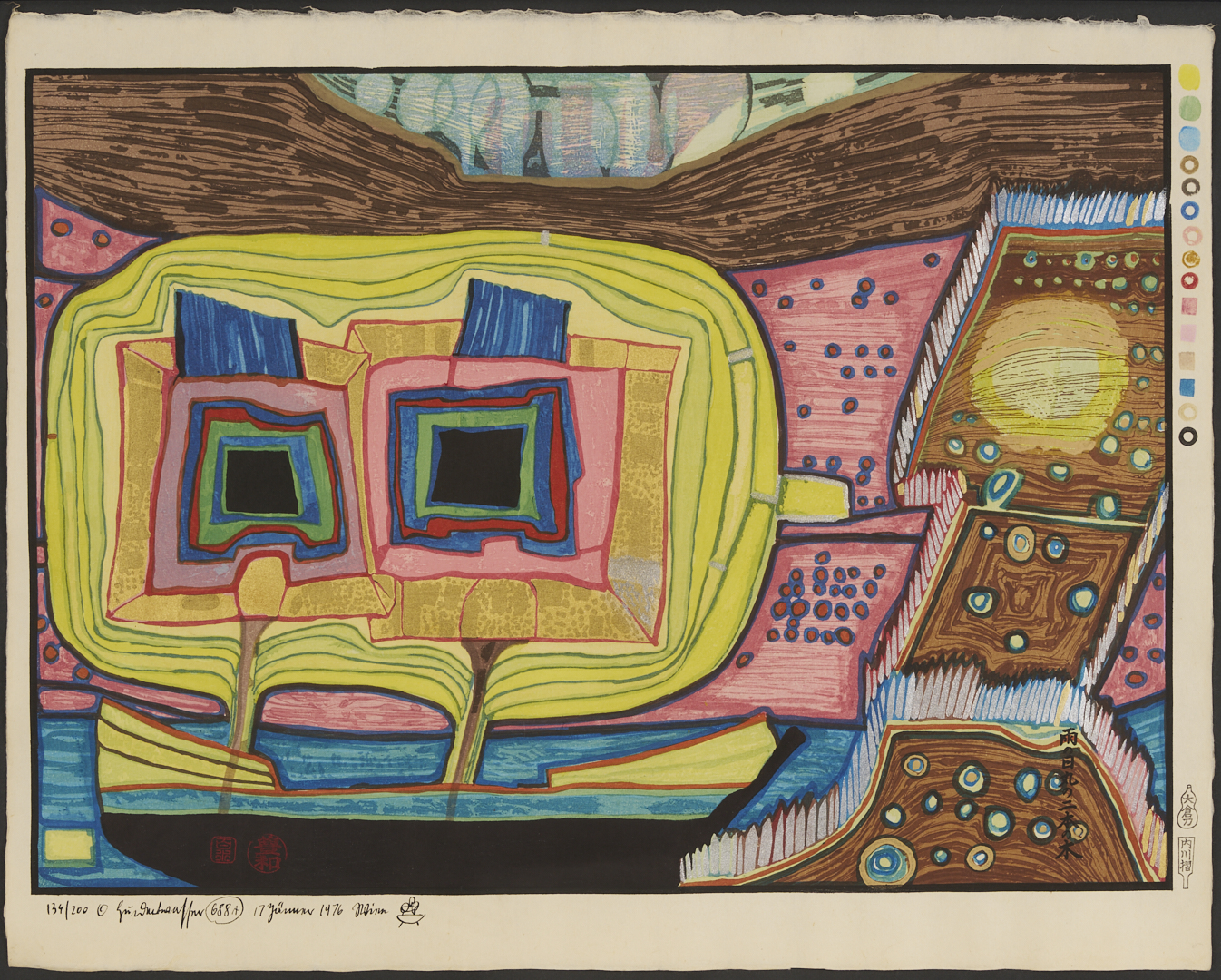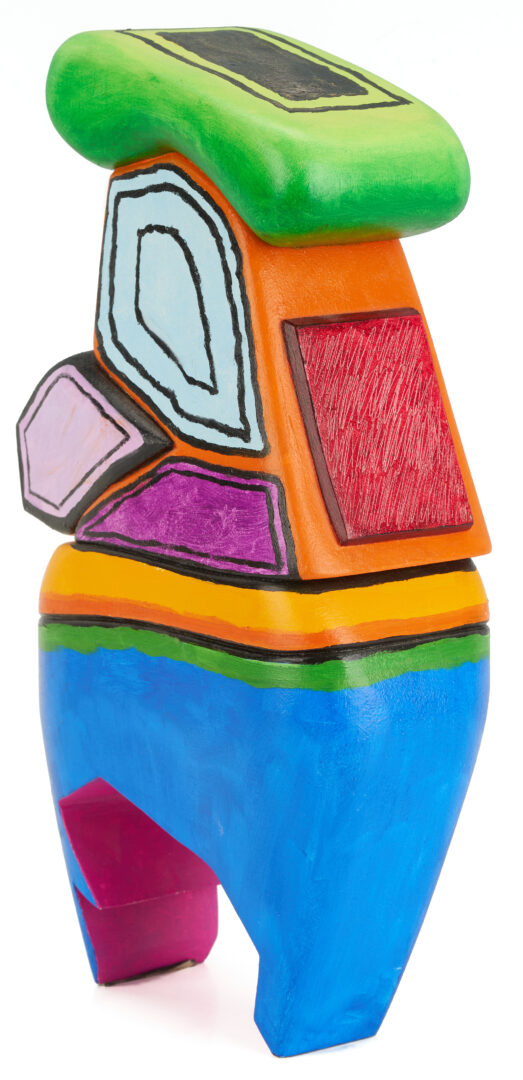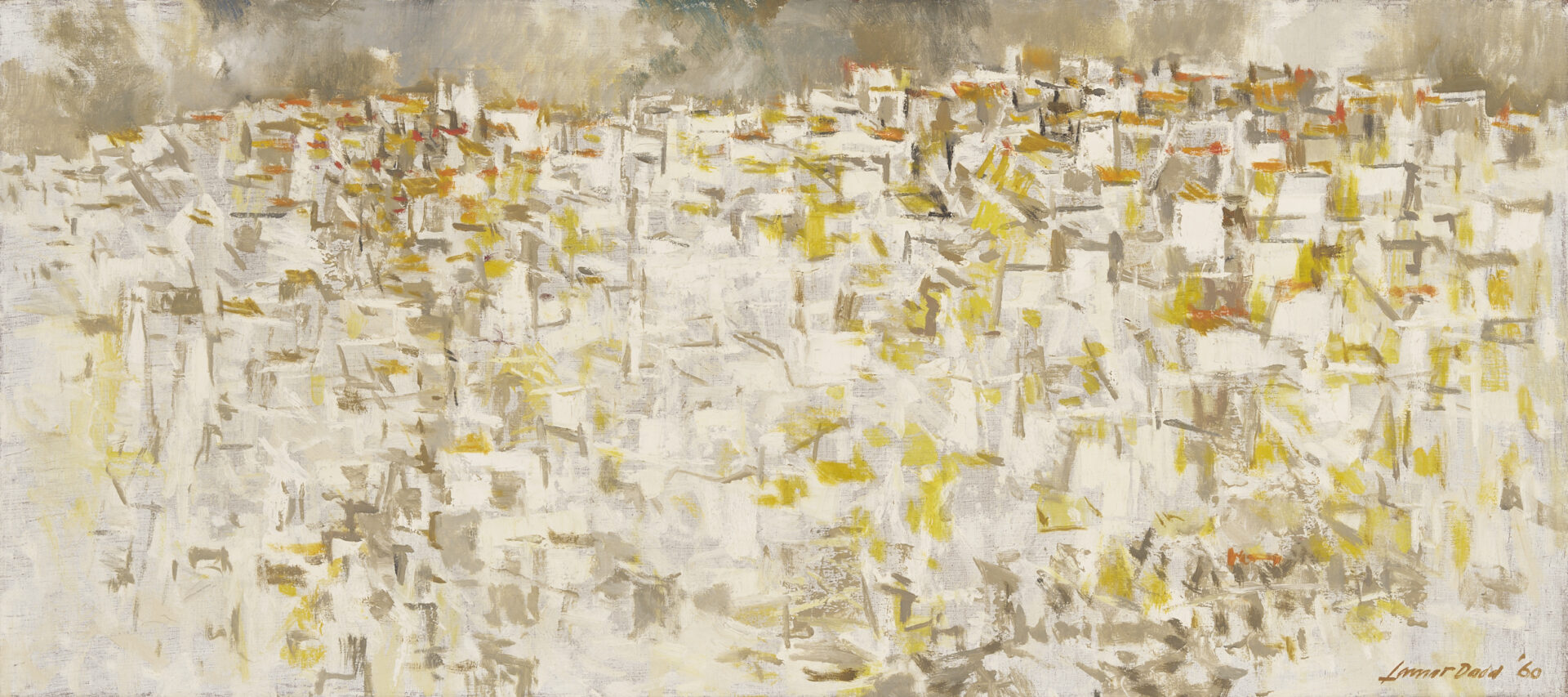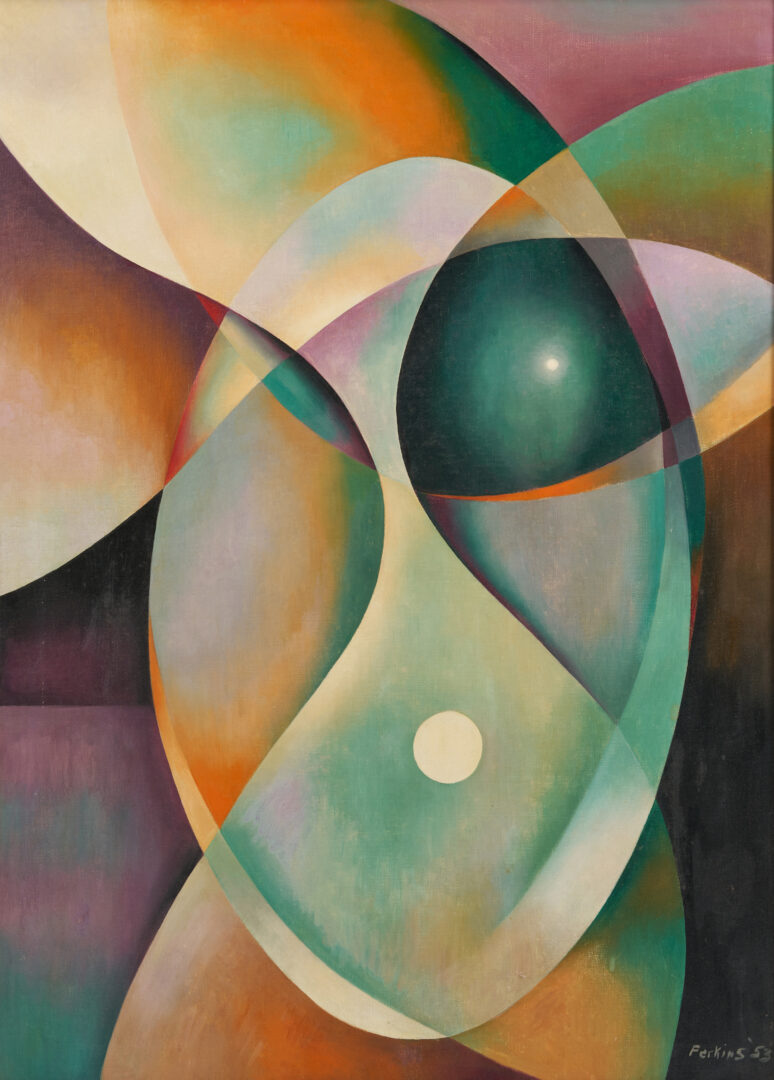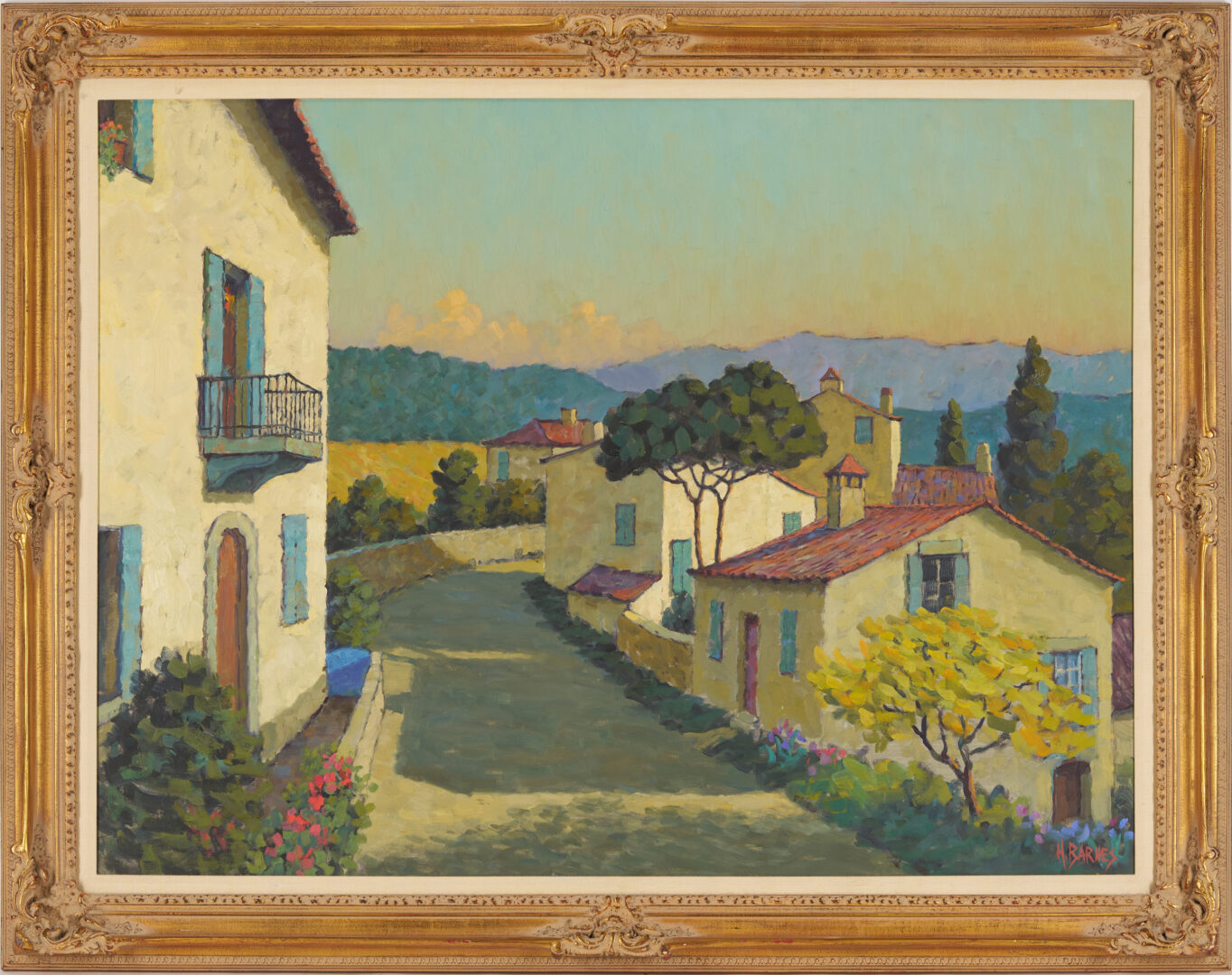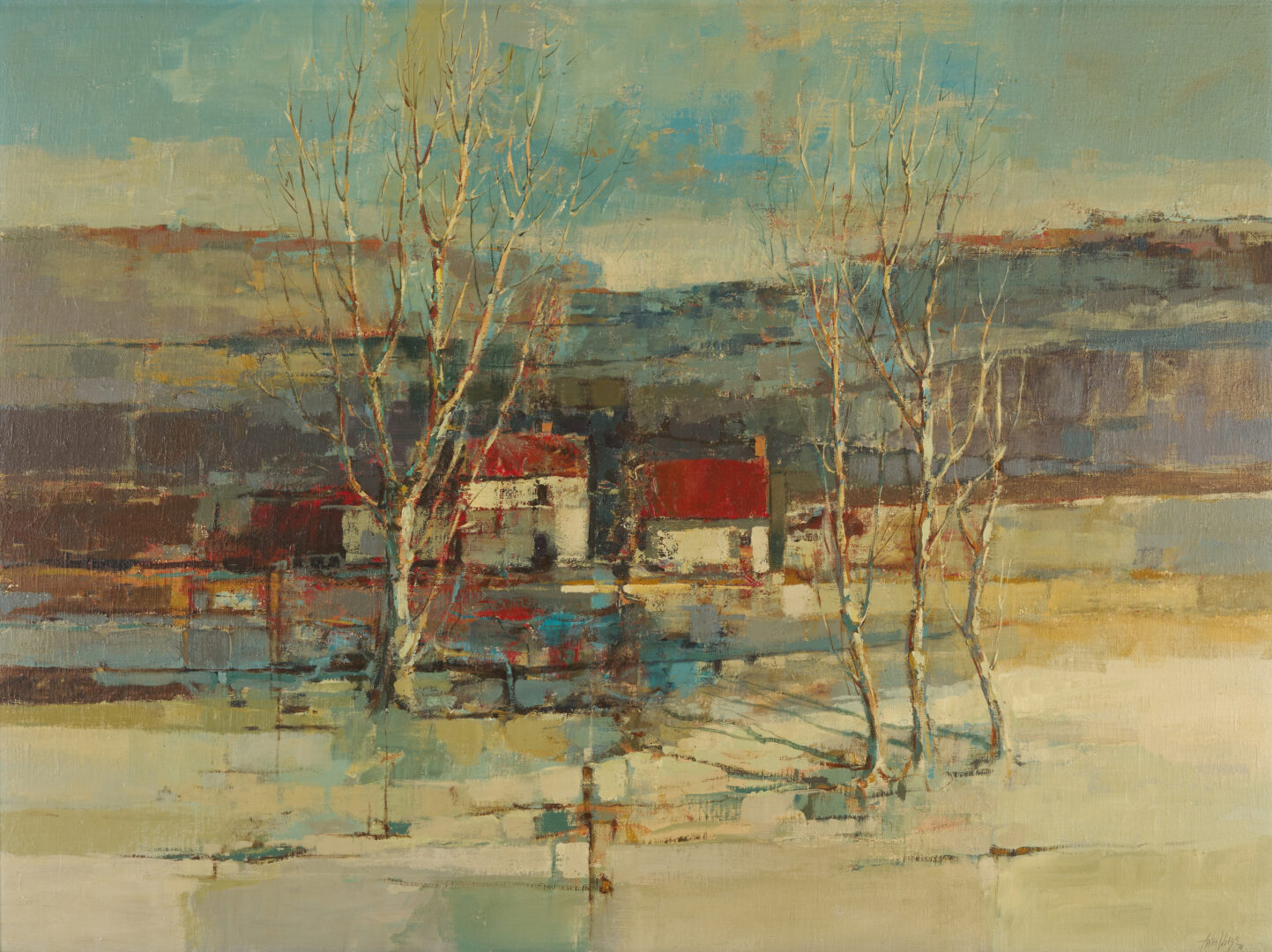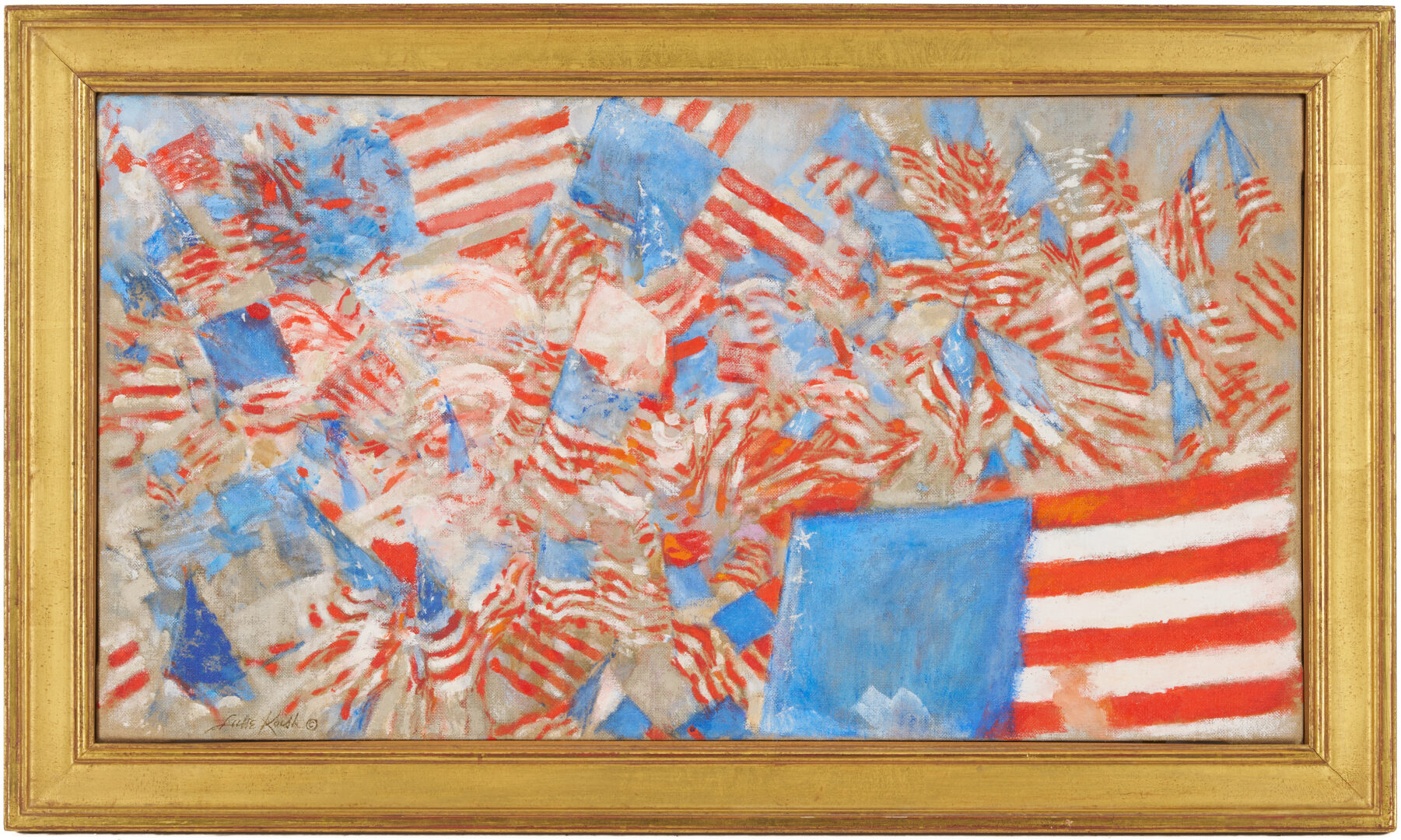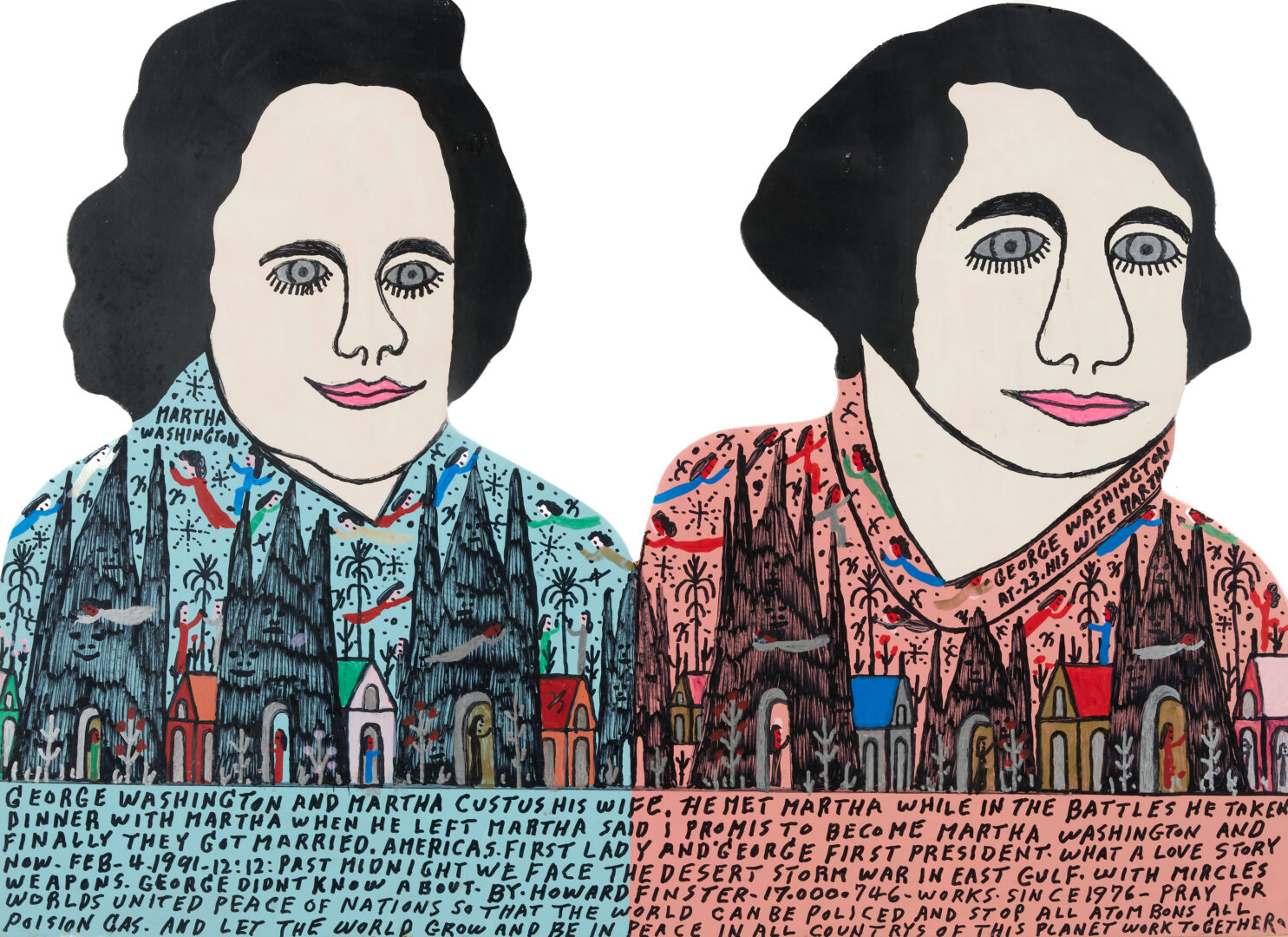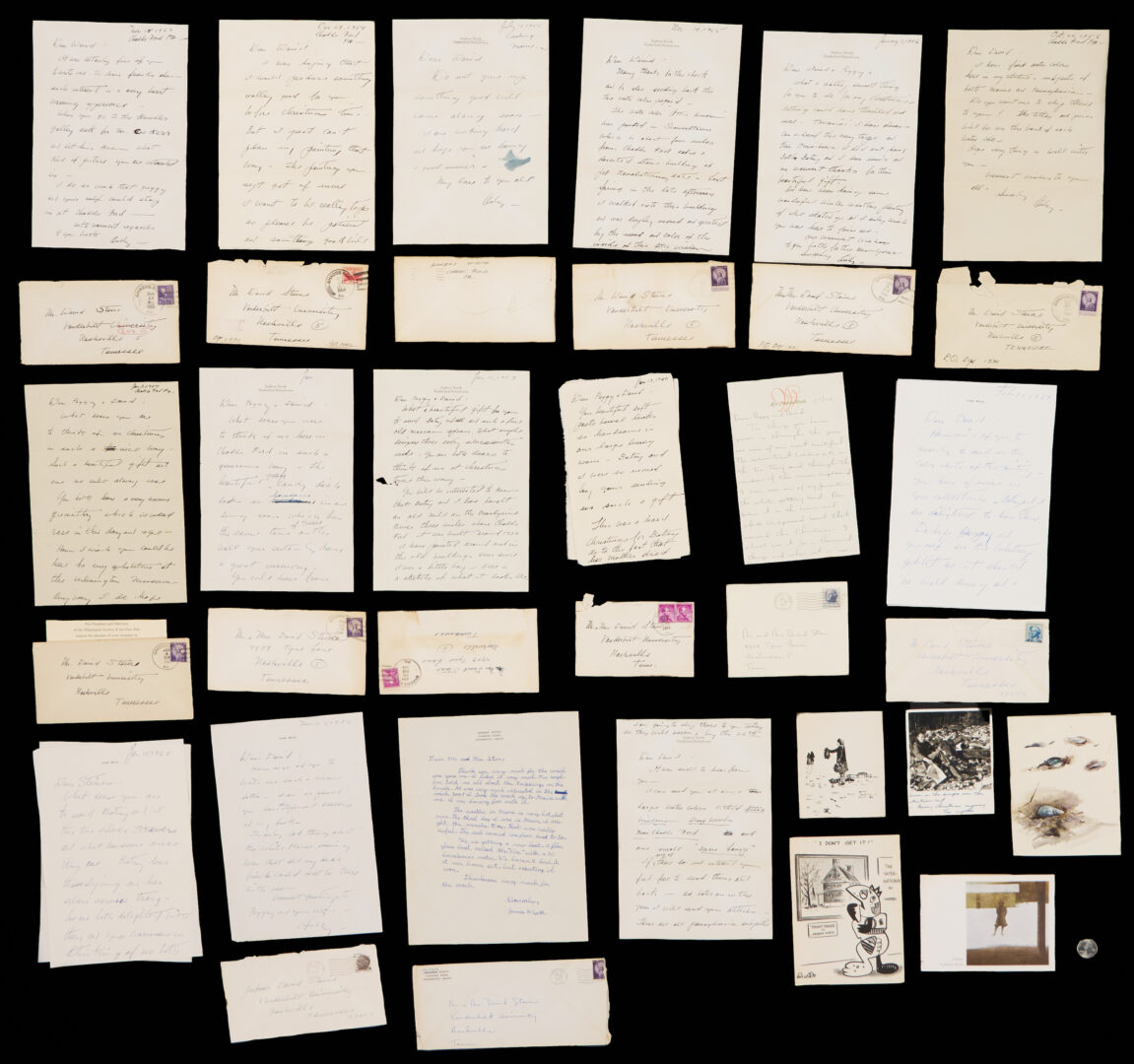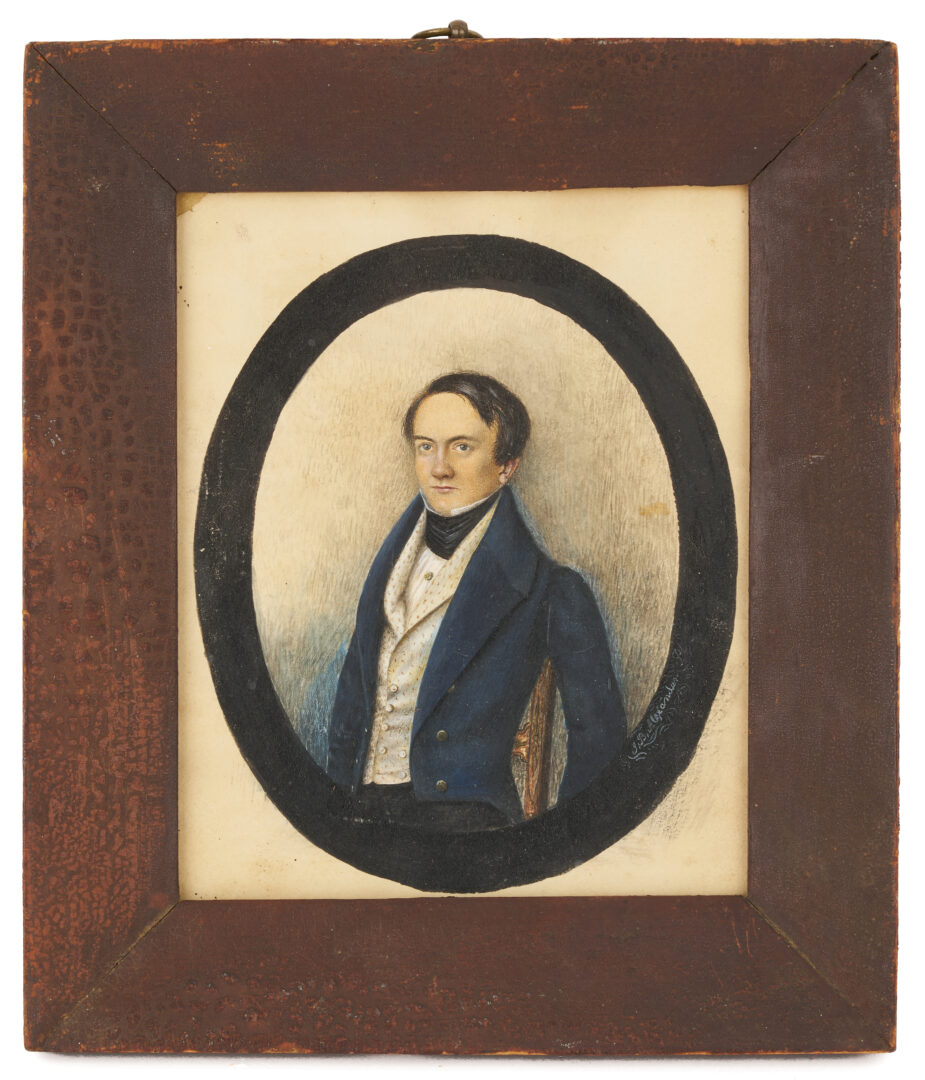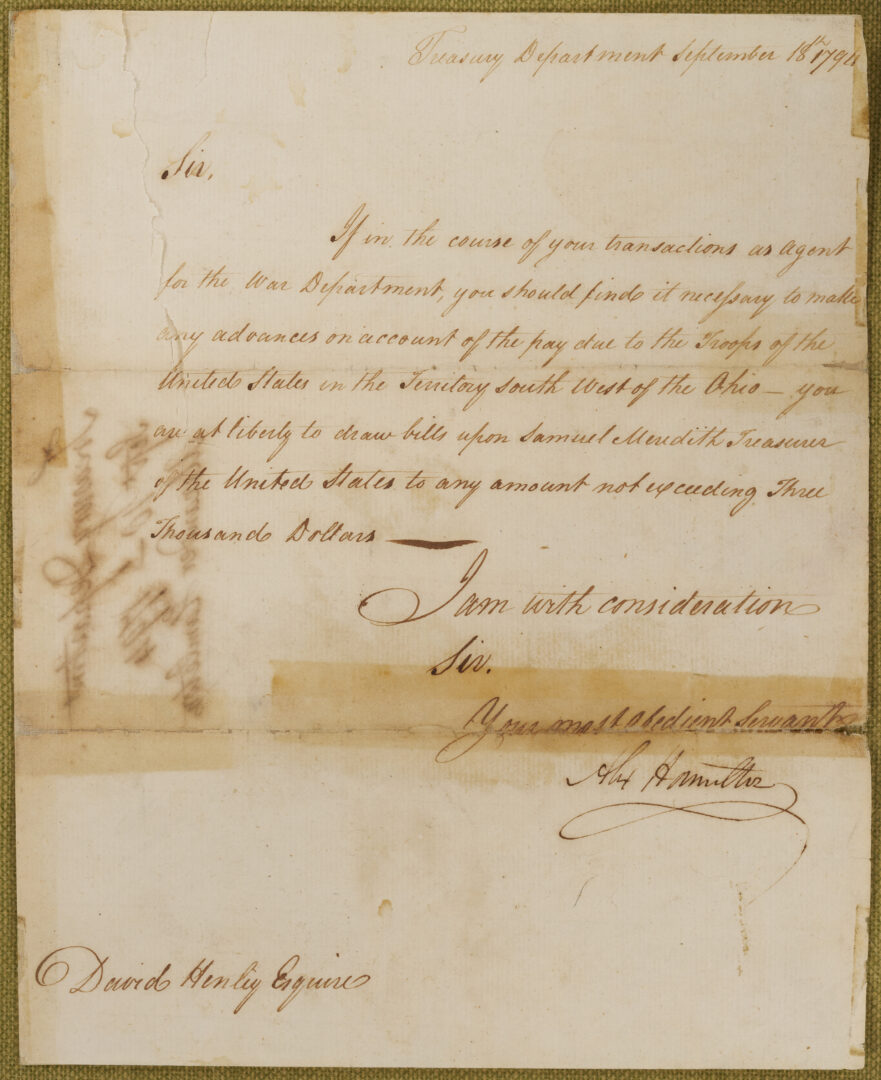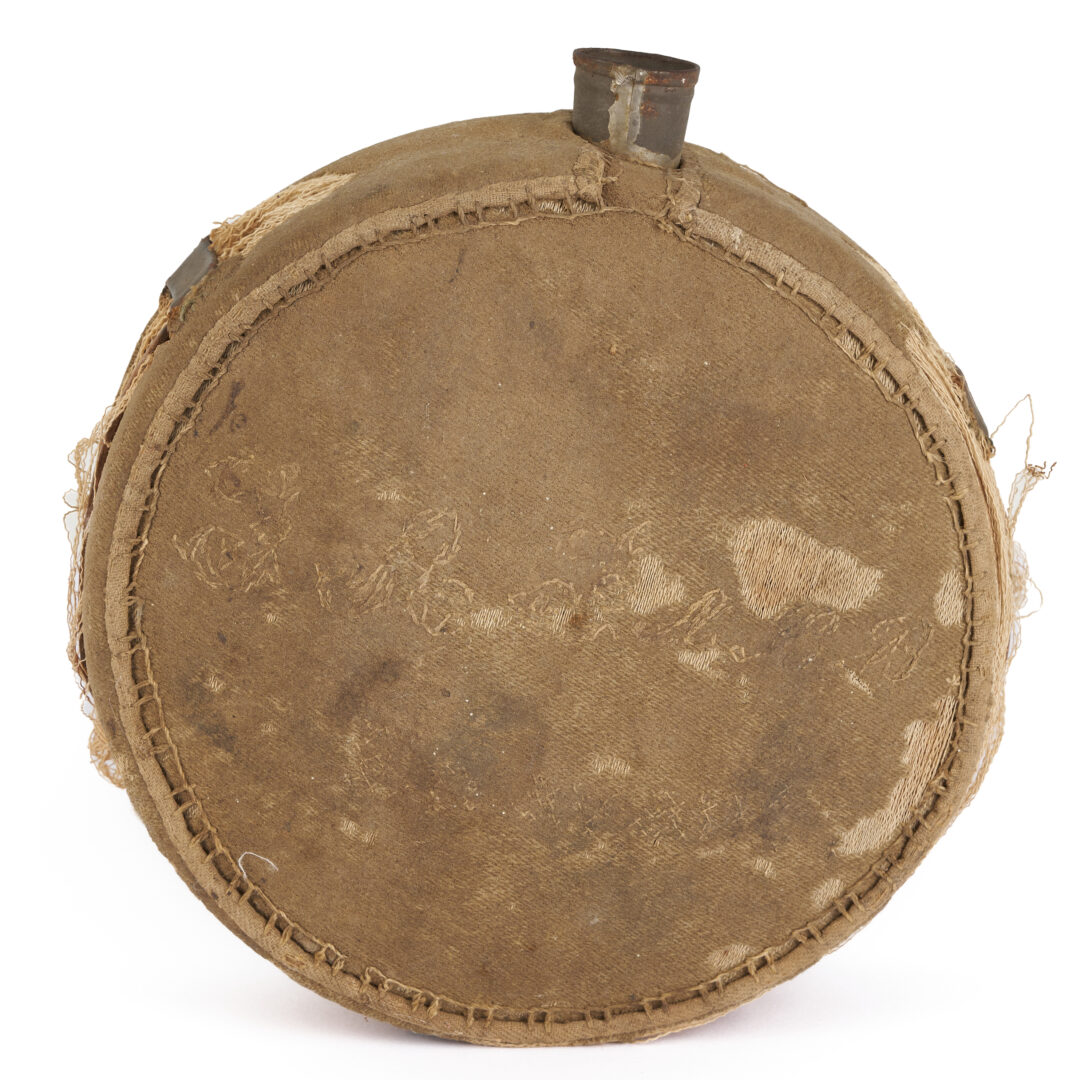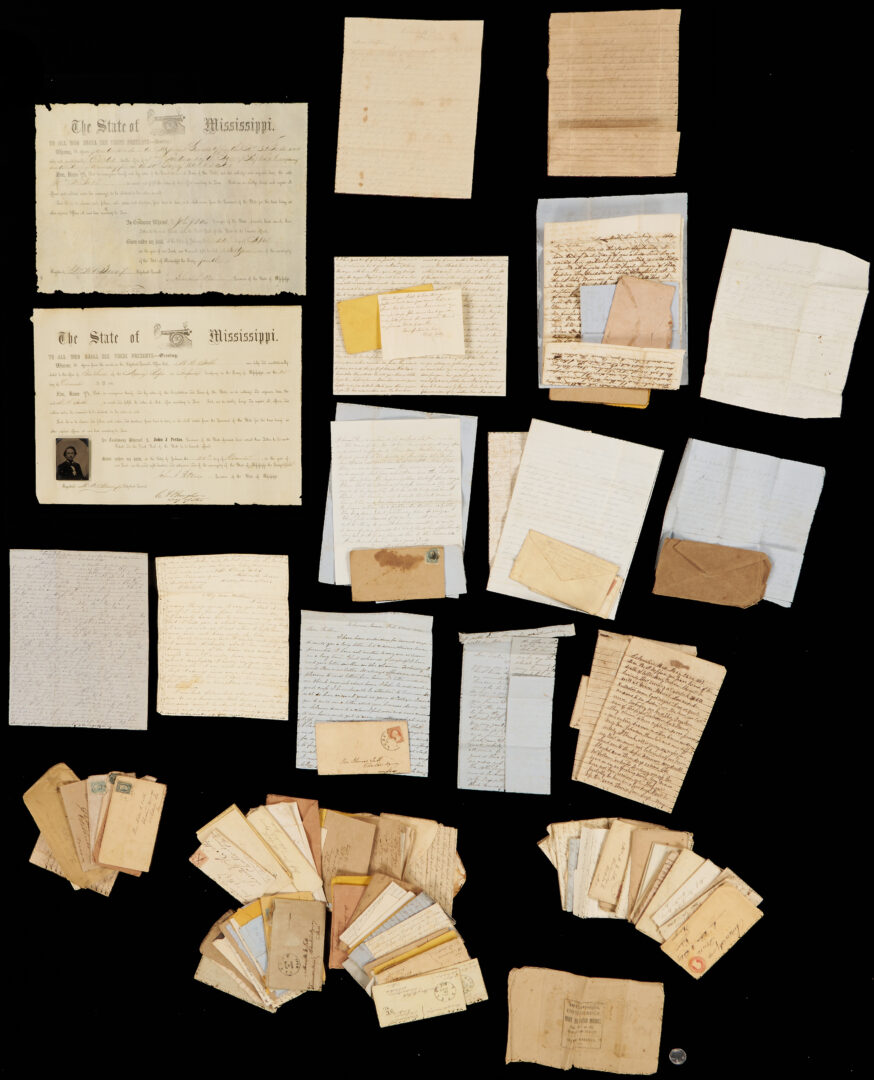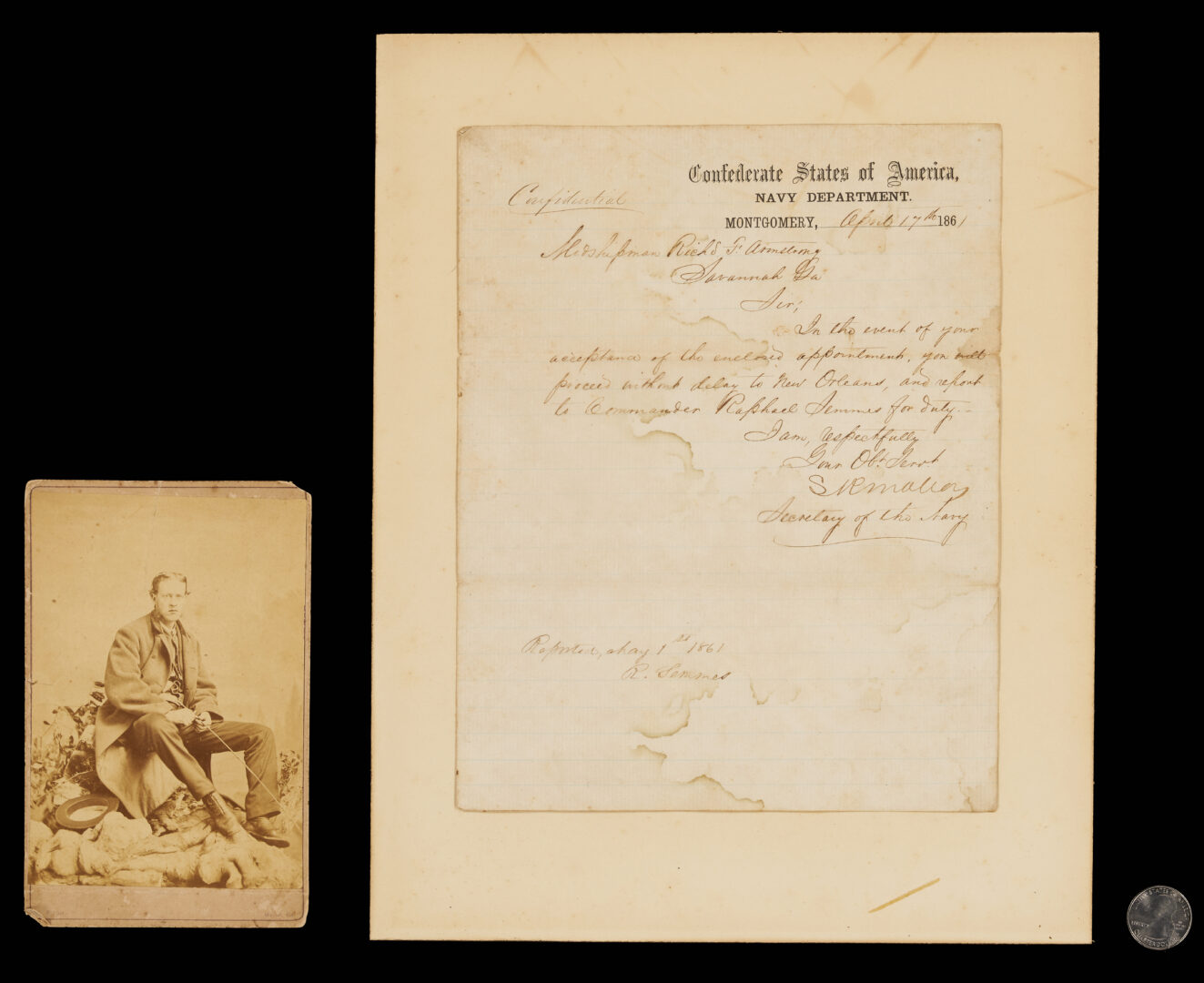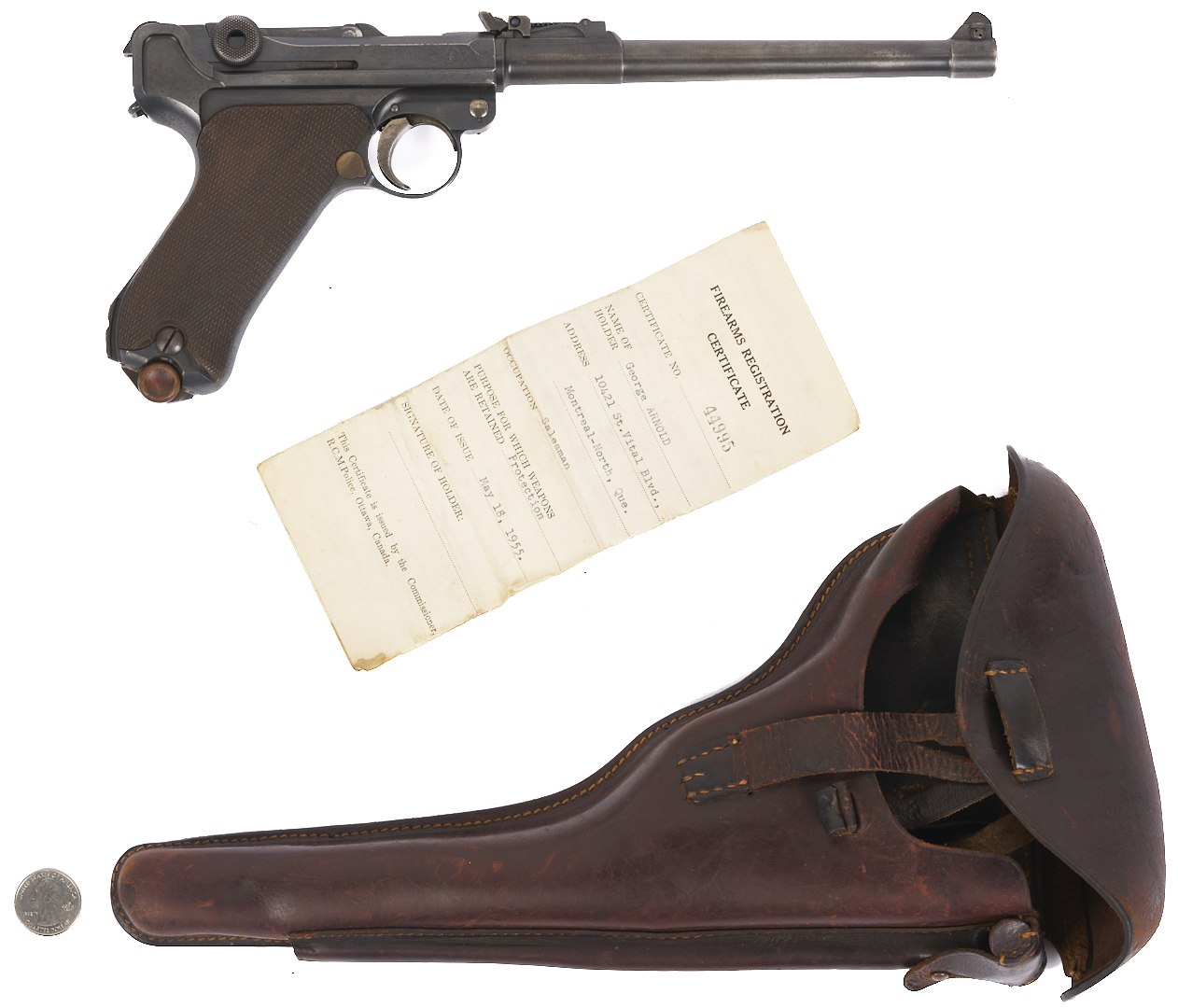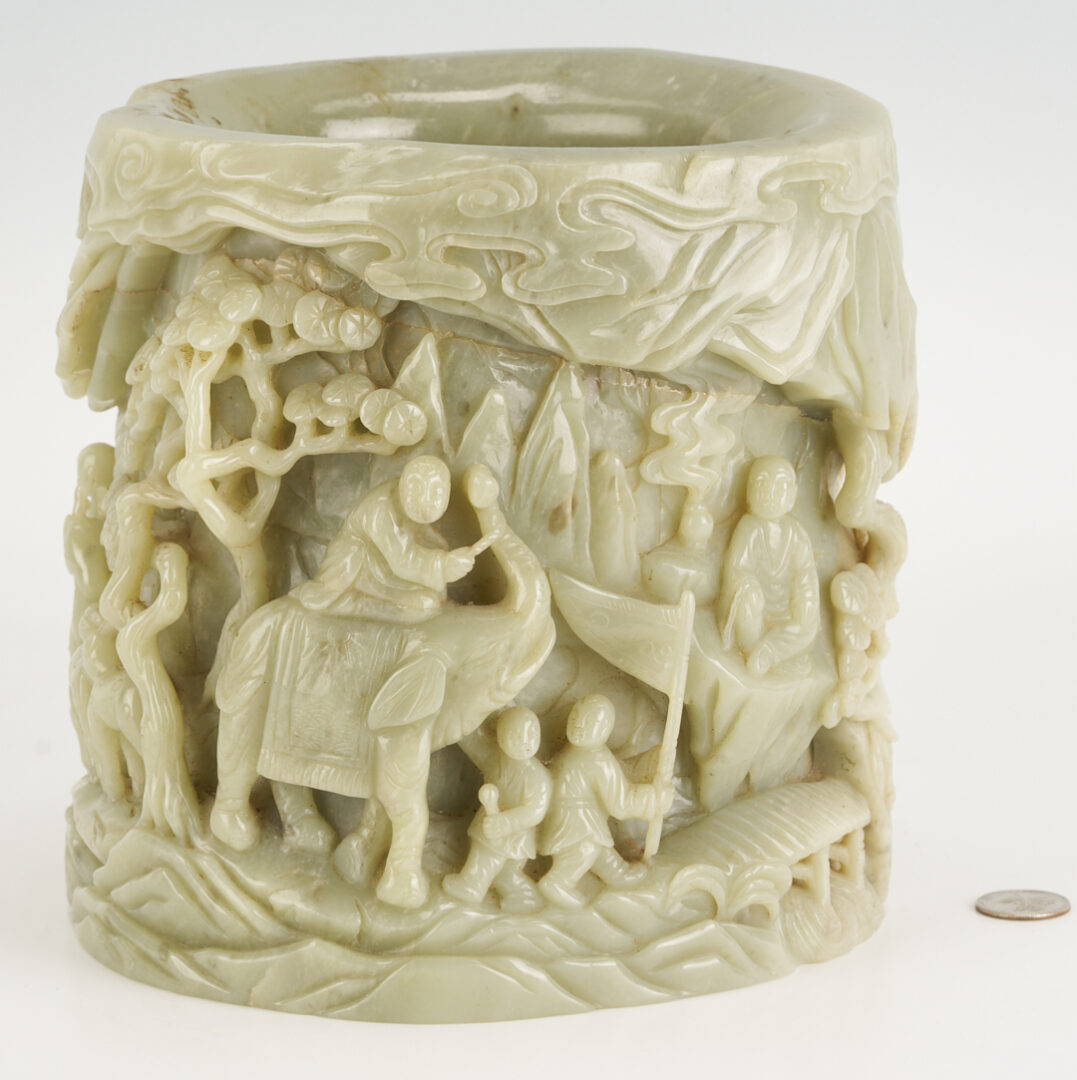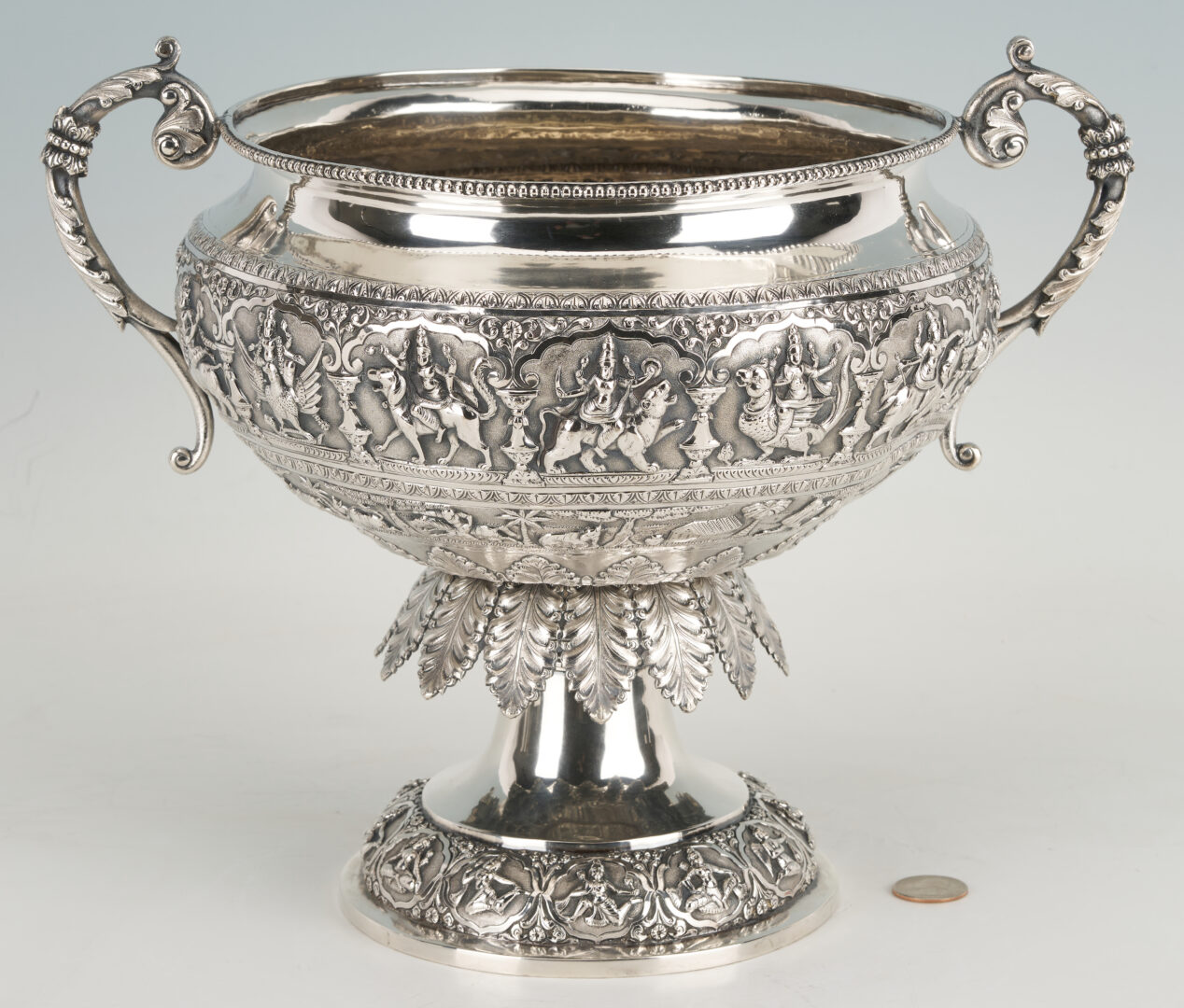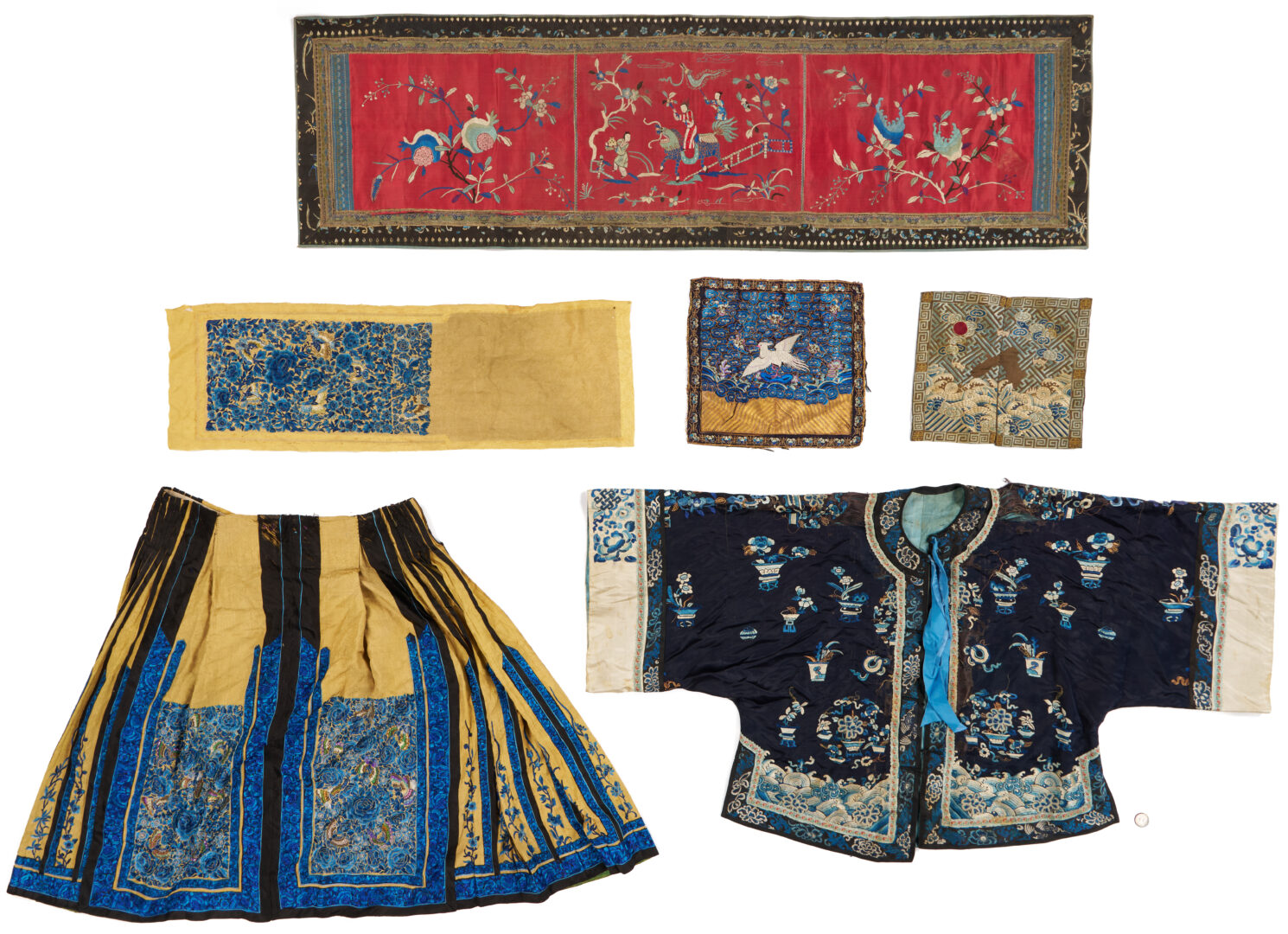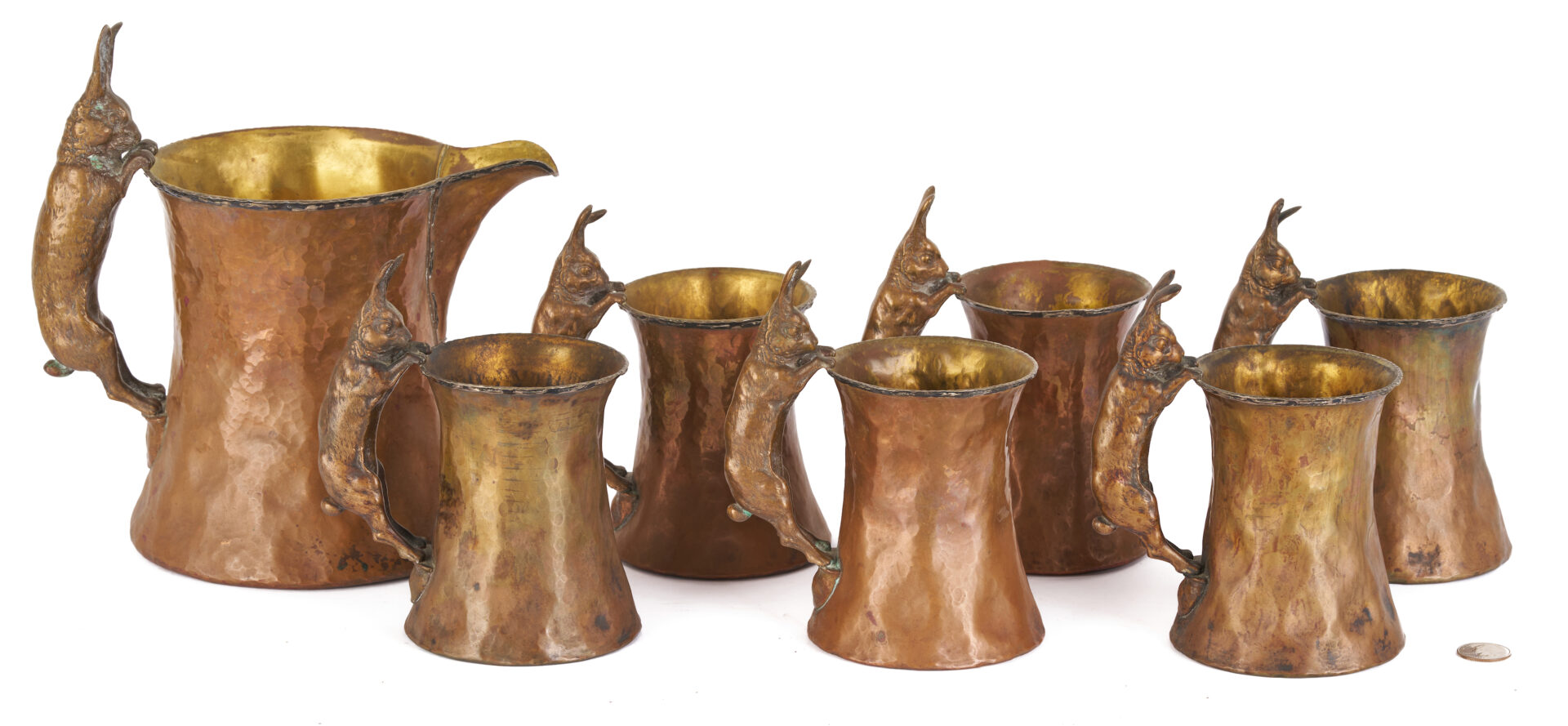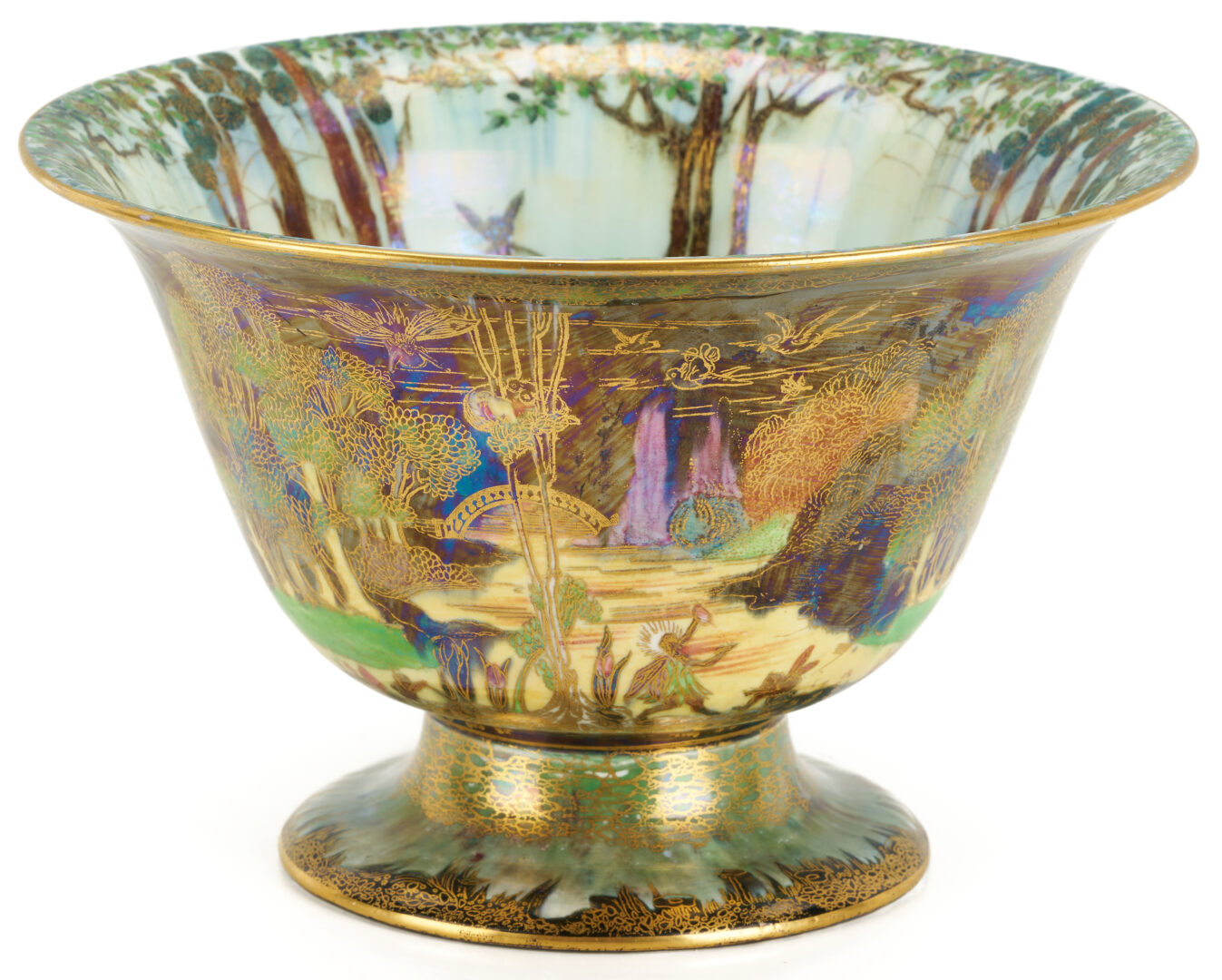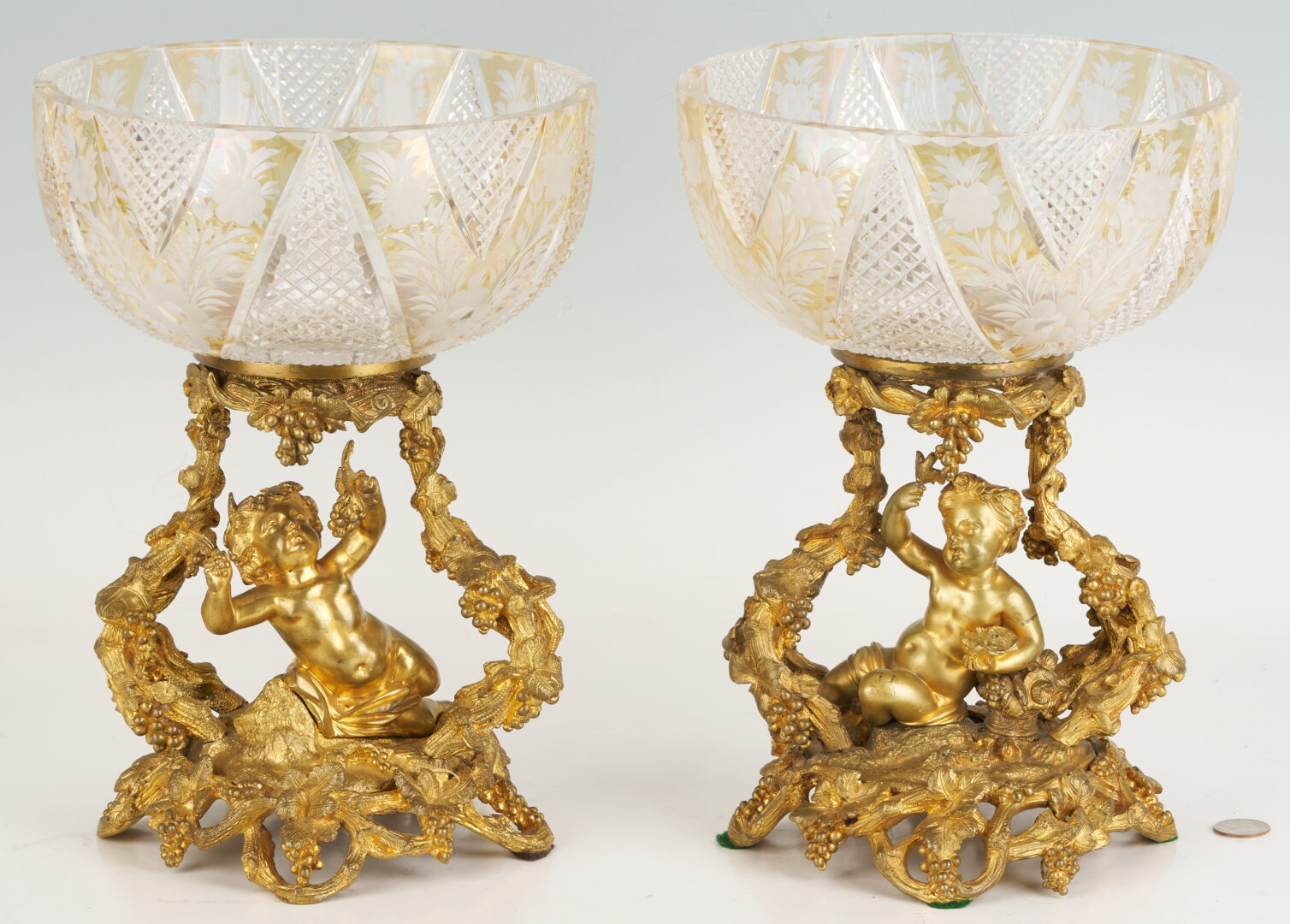Our Summer Auction will take place Saturday, July 12 and Sunday, July 13 at our Main Gallery in Knoxville. This sale will feature fine art and antiques from several estates and private collections including the estates of Ervin and Jane Entrekin, Nashville; the estate of Walter and Dr. Mary Helen Shatz, Nashville; the collection of Dr. James and Susan O’Neill, Nashville; the living estate of Bennett Armstrong, Alexandria; the estate of Dr. Lawrence Wolfe, Nashville; the estate of John Z. C. Thomas, Knoxville; the estate of Florence F. Johnston, Knoxville; and deaccessioned objects from the Memphis Brooks Museum of Art, the Arkansas Museum of Art, the Hunter Museum of Art and several private collections. Watch for our full catalog to be published on our website by mid June.
Large Lloyd Branson (Tennessee, 1861-1925) oil on board equestrian portrait painting of President Andrew Jackson astride his horse, Sam Patch, after Ralph E. W. Earl’s (1788-1838) c. 1833 painting in the collection of the Hermitage, Nashville, 1919. Signed and dated lower right. With painted wooden plaque affixed to frame that reads: “Andrew Jackson on Sam Patch. / This painting was presented to the Knoxville High School on March 1 – 1923 / By S. G. Heiskell, author of ‘Andrew Jackson and Early Tennessee History.'” Housed in a giltwood frame. Board: 54 in H x 47 in W. Frame: 57 3/4 in H x 50 3/4 in W.
Carroll Cloar (American/Tennessee, 1913-1993), “Final Resting Place,” 1964, acrylic (tempera casein) on board “Magic Realism” painting depicting a woman in patterned dress and sunglasses standing beside a grave. Floral funerary sprays on wire stands are stuck into the freshly mounded soil beside her, including one containing the surrealistic face of a clock. In the background are grasses and trees rendered in Cloar’s characteristic pointillism. Signed lower left, “Carroll Cloar,” in script; titled with artist name en verso in paint. Labels en verso for the Alan Gallery, New York, and Christie’s Auction. Ref: G. Northrop, “Hostile Butterflies,” Memphis, Tennessee, 1977, p. 99, no. 229, illustrated. Housed in the original stained and olive painted wood frame with gilt sight edge. Board: 22 in H x 32 in W. Frame: 30 in H x 40 in W. Provenance: the estates of Jane and Ervin Entrekin, Nashville.
William Edmondson (American/Tennessee, 1874-1951), “Mother and Child,” carved limestone sculpture depicting a woman with high forehead and short hair, balancing a child on one hip and carrying a pocketbook in the other hand. Illustrated, Edmond Fuller, “Visions in Stone: The Sculpture of William Edmondson” – fig. 56. Note: At the time Fuller’s book was published by the Univ. of Pittsburgh Press in 1973, this sculpture was owned by Bette Obermeyer Schultz of Nashville. It was acquired by Myron King, owner of Lyzon Gallery in Nashville at an unknown date. For at least the past twenty five years, it has been in the same Middle Tennessee family collection as “The Preacher,” an Edmondson sculpture auctioned by Case in 2020, and the “Lady with a Bustle” auctioned by Case in January, 2025. 13 in H x 5 1/4 in W x 5 1/3 in D (overall).
Helen La France (Kentucky, 1919-2020) oil on canvas landscape painting depicting an African American congregation gathering for a church picnic, with automobiles parked in front of a church and horse and buggy approaching lower left; food is being set out in the background, while little girls play a circle game in the right foreground. Signed “Helen La France” and dated 1998 lower right. Floated in a simple wood frame. Stretcher: 18 in H x 24 in W. Frame: .19 in H x 24 in W.
Meyer R. Wolfe (Tennessee/New York, 1897-1985), “Gay Street,” American Regionalist painting depicting an African American couple standing along an urban Nashville street and watching a train go by on a nearby railroad overpass. Signed lower right “Wolfe” and housed in a cream-painted plain wood frame. Panel: 20 in H x 24 in W. Frame: 28 in H x 32 in W. The area depicted in this undated painting is likely the formerly poor neighborhood near the Tennessee State Capital known as Hell’s Half Acre, near where Meyer Wolfe grew up. It was cleared in the 1950s under a series of Urban Renewal projects to make way for open greenspace, a six-lane road, and commercial buildings, and residents were relocated to public housing. The railroad bridge still stands and is in use today. Provenance: the estate of Dr. Lawrence Wolfe, Nashville, by descent from his uncle, the artist Meyer Wolfe.
William Lester Stevens (American, 1888-1969) oil on canvas Charleston, South Carolina street scene that depicts Meeting Steet with St. Michael’s Church at right and palms and other trees in the foreground. Signed “W. Lester Stevens.,” lower right. Housed in a giltwood frame with foliate corners. Sight: 15 1/2 in H x 19 1/2 in W. Framed: 22 in H x 25 3/4 in W. Note: Although he produced at least four watercolor depictions of various locations in the city, this is Stevens’s only known oil painting of Charleston.
Francis Speight (North Carolina/Pennsylvania, 1896-1989) oil on canvas winter cityscape, 1952. Two industrial buildings stand in the melting snow along Cotton St. in Manayunk, Philadelphia, with a dilapidated building and hillside visible in the distance at right. Signed “F. Speight” and dated, lower right. With 1957 Corcoran Gallery exhibition label with title affixed to stretcher along with Henry M. Taws Philadelphia art supplier stamp. Housed in a painted and giltwood frame with textile liner and painted and gilt fillet. Canvas: 20 in H x 32 in W. Sight: 19 in H x 28 3/4 in W. Frame: 31 3/4 in H x 41 3/4 in W. Exhibition History: Twenty-Fifth Biennial Exhibition of Contemporary American Paintings, Corcoran Gallery, January 13 – March 10, 1957.
Maxfield Parrish (American, 1870-1966) oil on canvas portrait of a female. Signed and dated “MP 1922” lower right and impressed block letters on top stretcher verso, “MAXFIELD PARRISH”. Sight 16 in. x 21 in., Canvas 17 in. x 22 in., Framed 22 1/2 in. x 27 1/2 in. More information in the coming weeks.
Marc Chagall (French/Russian, 1887-1985) lithograph in colors entitled La Chasse a l’Oiseau bleu (Chasing the Bluebird), 1969. On Arches paper with watermark center right. Pencil signed, lower right, and numbered 24/75, lower left. Inscribed in pencil “La chasse aux oiseaux” and “MC-58″ en verso. Ref.: Mourlot 594. Housed in a giltwood frame with cream textile mat and gilt fillet. Sheet: 29 1/8” in H x 21 7/8 in W. Sight: 26 in H x 21 1/2 in W. Framed: 34 in H x 29 1/2 in W.
Tom Wesselmann (American, 1931-2004) Mixografia pop art print on textured handmade paper entitled Still Life with Blonde and Goldfish, 2000. From the series of 75 published by Mixografia, Los Angeles. Signed in pencil and number 74/75, lower right. Floated on a white mount in an acrylic frame. Sheet: 33 in H x 39 in W. Framed: 35 in H x 40 1/2 in W.
Walter Francis Kuhn (American, 1877-1949), “Mrs. Elizabeth B. Parkinson, 1944,” oil on board painting depicting a woman with short dark hair and bright red rouge and lipstick. The bust-length portrait highlights the straps and bodice of her lacy black dress, pearl choker necklace and bare arms, while her neck and hollows of her cheeks are portrayed in shadows before an indistinct gray background. Signed center right, “Walt Kuhn” and dated 1944. Titled and dated en verso along with two Walt Kuhn Gallery, Cape Neddick, Maine labels, additional Christie’s Auction labels, and several numerical inscriptions. Wide molded giltwood frame. Board 21 in H x 15 in W. Frame: 27 in H x 21 in W. Note: Elizabeth Bliss Parkinson (1907-2001) was an art collector and patron from New York City. She was a trustee of the Museum of Modern Art for the majority of her life. Provenance: the estates of Jane and Ervin Entrekin, Nashville.
Charles Burchfield pencil and watercolor on paper landscape. Signed “Chas. Burchfield” lower left. Mounted under glass with a cream mat in a whitewashed molded wood frame. Sight: 11 12 in W x 9 1/2 in H. Frame: 20 1/4 in W x 17 1/2 in H. Provenance: the estates of Jane and Ervin Entrekin, Nashville.
Maurice Brazil Prendergast (American, 1858-1924), “Cattle in a Landscape,” 1890, watercolor on paper painting depicting cattle in a pastoral landscape setting under a partly cloudy blue sky. Signed lower left “Maurice B. Prendergast” and dated July 1890. Ref. Maurice Brazil Prendergast: A Catalog Raisonne, Williams College Museum of Art, p. 330, fig. 514 (illustrated). Exhibited, Heath Gallery, Atlanta, “Nature in Early Modern American Art,” May 17-31, 1986. Matted under glass in a giltwood Rococo style frame with labels for Heath Gallery and Sotheby’s. Sight: 8 in W x 6 1/4 in H. Frame :15 in W x 14 in H. Note: A copy of the Maurice and Charles Prendergast Catalog Raisonne accompanies this lot.
Jasper Francis Crospey (New York, 1823-1900) oil on canvas Hudson River School landscape painting, “Along the Delaware,” 1889. Within a lush, atmospheric landscape filled with colorful fall foliage a lone figure carries a red bindle and walks away from a small bridge. The bridge transverses a creek that flows into the distant Delaware River. At right, the roof of a small building and a wooden fence peer over a hillside while dark clouds hang in the sky above. Signed and dated “J.F. Cropsey 1889,” lower left. With 1991 Christies labels affixed to back of frame. Housed in a giltwood frame with brass nameplate. Canvas: 12 in H x 20 in W. Sight: 11 in H x 19 in W. Frame: 21 in H x 29 1/4 in W.
Thomas Doughty (Pennsylvania/New York 19th c.) Hudson River School oil on canvas landscape painting depicting sailboats on a placid river positioned between steep hillsides, all under a sky filled with gray clouds. Signed “T DOUGHTY” lower center. Housed in a period giltwood frame. Sight: 28 in H x 35 in W. Frame: 40 in H x 47 in W.
James Guy Evans (American/ Louisiana, 1809/10-1859) oil on canvas maritime painting titled “The Eleanor Jane… in a Stiff Blow Near Cape Henry [Virginia],” depicting the ship in choppy waters heading into a dark storm cloud. Flags including an American ensign fly from the masts. Other unidentified vessels are visible in the difference. Signed “Evans Paint” lower right. 2 stencils on back for artist supply stores R. Hall & __ Canal St., New Orleans, and Groupil, New York. Stretcher: 29 in H x 26 in W. Frame: 37 in H x 44 in W. Note: New Orleans-based marine painter James Guy Evans first enlisted in the U.S. Marine Corps in 1829 and was discharged from Navy service at Norfolk in 1836. He lived briefly in New York and Cuba before moving to New Orleans in 1846 where he opened a commercial painting studio specializing in house, ship, sign, and ornamental painting. Contemporary accounts record that he sailed with his subjects on occasion, serving as both a painter and minister while on board. In about 1850 he took on a partner, German-born artist Edward Arnold (1824-1866); the two also worked together on some paintings.
Oil on paper mounted to panel portrait of President George Washington, attributed to James Peale, Sr. (Maryland/Pennsylvania, 1749-1831). Washington appears in bust-length, three-quarters view and wears a powdered wig, black coat, and white cravat. 19th c. or earlier. Unsigned. With label en verso inscribed “Property of / Frank Dudensing / James Peale / FD 114 – 7 x 6,” plus additional inventory label with Peale attribution. Housed under glass in a painted wooden frame with gilt fillet. Sight: 6 in H x 5 in W. Frame: 13 3/4 in H x 11 3/4 in W. Note: Art dealer Frank Dudensing (New York, d. 1940) was the father of the noted gallerist F. Valentine Dudensing, operator of the modernist Valentine Gallery. According to the Valentine Gallery, Frank’s father, Richard Dudensing, “emigrated from Germany and was a successful printer and engraver in New York, while [his son Frank] opened the art gallery Richard Dudensing & Son in 1903.” (Source: Valentine Gallery)
Edgar Alwin Payne (Missouri/California, 1883-1947) oil on board depicting a placid lake, in the High Sierras, shadowed by barren mountains with scattered snowfall. Rendered in a light impasto are the multicolored trees settled on a boulder-strewn valley and the grey/purple mountains that make up the background. Signed “Edgar Payne” in lower right. Housed in a gilt frame with areas of floral design carved into the corners. Sight: 11 1/2 in H x 15 1/2 in W. Frame: 18 in H x 22 in W.
Cornelius Haly Hankins (Mississippi/Tennessee, 1863-1946) oil on canvas still life painting depicting a basket of fruit, nuts and nutcracker beside a frosted fruitcake and a bottle of wine, set against a dark, indistinct background. Signed “Cornelius Hankins” lower right and dated “Xmas 1897.” Housed in a giltwood Aesthetic Movement style frame. Sight: 23 1/2 in H x 15 1/2 in W. Frame: 24 in W x 32 in W.
Carl Gutherz or Guthers (Tennessee/Missouri, 1844-1907), “Missing,” oil on canvas painting of a fallen soldier who lies partially hidden by foliage on a forest floor while a small bird perches on a branch above. He wears the uniform of a French foot soldier active during the Franco-Prussian War. Although the soldier’s body shows no sign of distress, the blasted tree in the background suggests the possibility of cannon fire. Signed “Carl Gutherz” and dated 1886, lower left. Housed in giltwood frame. Sight: 50 1/2 in H x 35 1/2 in W. Canvas: 51 1/8 in H x 36 1/8 in W. Frame: 58 1/2 in H x 42 in W.
Elizabeth Quale O’Neill Verner (South Carolina, 1883-1979) pastel on silk portrait depicting a Charleston flower vendor seated and holding a bouquet of flowering branches. She smokes a pipe and wears a bright blue head wrap. Signed “Elizabeth O’Neill Verner” lower right. Housed in a beveled oak frame. Sight: 8 1/2 in. H x 7 7/8 in. W. Framed: 11 3/4 in. H x 11 1/4 in. W.
Carroll Cloar (American/Tennessee/Arkansas, 1913-1993) large graphite and colored marker on paper drawing. A young woman wearing a checkered apron with hands in her pockets, stands in an open field with yellow grass and tall wildflowers, and a grove of trees in the distance. Signed, Carroll Cloar, lower left. Framed under glass in a molded giltwood frame with intentional distressing. Sight: 35 in W x 21 in H. Frame: 45 in W x 31 in H.
Virginia Federal huntboard or sideboard. Cherry, walnut, figured cherry veneers. Yellow pine and poplar secondary. Pegged construction. Plain rectangular top over two deep side drawers and two stacked center drawers, each drawer dovetailed and having figured or “tiger” cherry veneer surrounded by figured crossbanding at the edges and oval brass pulls embossed with acorns and leaves. Supported on four tall square tapered legs. 42 in H x 57 in W x 20 3/4 in D. Circa 1810.
Middle Tennessee Federal Sugar Chest, likely Moore County, cherry with walnut stain and poplar secondary. Top with rounded edge and breadboard ends, over a dovetailed case with divided interior, over a single dovetailed drawer and four bulbous turned legs terminating in short spike feet. Original round turned wood knobs. 36 1/2 in H x 30 1/2 in W x 17 in D. Circa 1830.
Central Kentucky sugar sideboard. Cherry, mahogany banding, and poplar wood secondary. Rectangular gallery backsplash with inlaid banded border and inset plain cherry board over a top tier of two flanking hinged lift tops with half-round molding and rectangular fronts having mahogany banding and inset cherry panels with brass escutcheons and locks. The left side opens to reveal a well that could have served for sugar storage or a cellarette. The cherry top with a cherry mitered outside perimeter of 2 1/4 in. width and mahogany veneer molded edge over a facade of three cockbeaded drawers with mahogany banding and inset figured cherry veneer panels. Consisting of one long center dovetailed drawer flanked by a smaller right dovetailed drawer and a faux drawer of the same size on the left side. Case rests on four ring-turned and reeded Sheraton legs. 70 3/4 in. W x 21 1/4 in. D x 42 1/4 in. H. Circa 1830.
Southwest Virginia or East Tennessee walnut pie safe with older polychrome paint decorated tins. Secondary woods include yellow pine and poplar. Rectangular top with half-round beaded molding over two dovetailed drawers with wooden pulls and two cupboard doors, each having punched tin panels decorated with a circular vase with handles and hearts with star and circular flowers and heart designs to the tin corners and flanking the urn. Safe case supported by turned Sheraton feet. 43 1/4 in. W x 17 1/8 in. D x 41 1/2 in. H. Third quarter of the 19th century.
American Schoolgirl Needlework Sampler by Lucy Ann Reid, Spring Hill TN Female Academy, 1842, silk thread on linen ground. Cross stitched double vine and blossom borders enclosing two alphabets (one rendered in box stitch) and a row of numbers, divided by satin stitch sawtooth borders, a vine and blossom border, and decorations of flowering baskets, over a verse, “Jesus permit thy gracious name to stand / engraven by an infant hand / As I my finger oor the canvass move / inspire my bosom with thy love.” Cartouche lower center signed “Lucy Ann Reid aged 9 / Spring Hill Female Academy / Nov. 15, 1842” within a geometric border. Later molded wood frame, under glass. Sampler: 17 in H x 16 3/4 in W. Frame: 21 in H x 20 1/2 in W. Note: this sampler has been documented by the Tennessee Sampler Survey, which notes that Lucy Reid was born Feb. 16, 1832 in either Tennessee or North Carolina. Her parents William Buchanon Reid and Ede Harris Brown moved to Macon in Fayette County Tennessee by 1834. Spring Hill Female Academy on the border of Williamson and Maury Counties was likely the closest site for her to receive educational instruction. Lucy Reid married Edmond Madison Waller in 1851. He served as a private in the Confederate Army (13th Tennessee Infantry) and was killed at the Battle of Stones River Dec. 31, 1862. Lucy herself and their son do not appear in any records after that, although their 3 daughters lived to adulthood.
Large patriotic blue and white hand-pieced cotton Medallion pattern quilt top, of original design and possibly based on a mosaic floor design, with four eagles in each corner and additional star and foliate designs throughout. Consisting of two blue cotton print fabrics and a white cotton tape to secure the edges. 102 in. x 95 in., Circa 1850 – 1870. Note: This quilt is one of three in this sale that belonged to Linda McCormick Felts, an antique collector and interior designer from Memphis, TN. All three quilts were also featured in the Pieced & Patterned exhibit at the Museum of Fine Arts in St. Petersburg, Florida, which ran from September 18, 2021, to January 23, 2022.
Patriotic Medallion Star pattern quilt, one of two made by an unknown maker that descended in the Keeler Family of Ridgefield, Connecticut. Hand pieced, appliqued, and quilted, and consisting of printed and solid chintz cotton in Prussian blue, pink, and brown colors, appliqued eagles holding rose buds and arrows to each corner, interspersed with appliqued potted roses consisting of red, green, and brown prints, all on a white ground with white cotton back. Cotton batting with diagonal quilting with quilting around each appliqué, visible from the back. 88 in. 88 in. Circa 1850s. Note: This quilt is one of three in this sale that belonged to Linda McCormick Felts, an antique collector and interior designer from Memphis, TN. All three quilts were also featured in the Pieced & Patterned exhibit at the Museum of Fine Arts in St. Petersburg, Florida, which ran from September 18, 2021, to January 23, 2022. The companion quilt to this one, which descended from the same family, is featured in two books: It was the cover page for “Quilts and Quiltmakers Covering Connecticut,” published by the Connecticut Quilt Search Project, published in 2002. According to the Connecticut Quilt Search Project, Ralph Keeler was one of the first colonists to purchase land and settle a plantation in Ridgefield in 1697. The companion quilt is also featured in the book “All Flags Flying: American Patriotic Quilts as Expressions of Liberty” by Robert Bishop and Carter Houck, published in 1986, on page 17, Figure 8. The companion quilt is also documented in the Quilt Index as #17-13-2489.
Edward Alfred Cucuel (American, 1875-1954) oil on canvas impressionist style painting rendered in a thick impasto, depicting a well-dressed woman lounging in a folding chair in a garden setting on what appears to be a bright yet chilly day. She wears a feathered hat and fur stole and holds a parasol, and beside her sits a table spread with food. Signed lower right “E. Cucuel” with possible additional faint signature in script en verso. The whitewashed parcel gilt Rococo style frame retains a Kunlthaus Buhler, Stuttgart, gallery label en verso, and has possible title “Cecelia” inscribed in chalk along with various numbers. Sight: 25 in H x 18 in W. Frame: 33 in H x 26 in W. Biography: California-born Edward Cucuel began his formal art training at the age of 14 at the School of Design in San Francisco and three years later undertook studies at the Academie Julian in Paris followed by training at L’Ecole des Beaux Arts under Jean Leon Gerome. In 1896 he returned to the U.S. and worked briefly as a newspaper illustrator before returning to Europe. By 1907 he had established a studio in Munich where he worked with Leo Putz and developed his own Impressionist style. Cucuel lived in Europe until 1939, when World War II forced him to move back permanently to California. He is best known for his Impressionist paintings of elegant women engaged in leisurely outdoor activities.
Hamilton Hamilton (Connecticut/California, 1847-1926) impressionist oil on canvas painting depicting a young woman in a long white dress standing before a trellis covered in blooming roses. The trellis grows up the column of a house with window visible behind the column. Signed “Hamilton Hamilton NA” lower right. Label en verso for Berry Hill Galleries, with title listed as “Young Woman Standing Before a Trellis of Flowers” and approximate date of 1890-1895. Giltwood frame with Neoclassical style fluted, egg and dart and beaded moldings and carved corner ornaments. Sight: 23 1/2 in H x 13 1/2 in W. Frame: 28 1/2 in H x 18 1/2 in W.
Edouard Leon Cortes (French, 1882-1969) oil on canvas Paris street scene entitled L’Opera and depicting a bustling street with pedestrians and horse-drawn carriages plus a cafe or shop at left. A flagpole topped with the French “tricolore” flag bisects the composition. In the distance stands the Palais Garnier, or Opera Garnier. Signed “EDOUARD CORTES.,” lower right. Inscribed “L’Opera,” “26654,” and “WF” (likely Wally Findlay) to stretcher along with “LB 8 F 46 x 38” stretcher label. With Findlay Galleries, Chicago sticker affixed to backing. Additional small red and white sticker inscribed “3” plus “26654” inscription to backing along with Melvin Picture Frame Co., New York sticker. Housed in a giltwood frame with textile liner and brass nameplate. Canvas: 15″ H x 18 1/8″ W. Frame: 23″ H x 26″ W. Note: This lot is accompanied by a certificate issued by the Comite Edouard Cortes, under No. EC-CEC-2025/20. It will be included in the supplement to the catalogue raisonne of Edouard Cortes’s work which is currently being prepared.
Edouard Leon Cortes (French, 1882-1969) oil on canvas Paris street scene entitled Place de la Madeleine and depicting a bustling street after a rain with pedestrians, horse-drawn carriages, a flower card, and shops or cafes at left. In the distance stands the Church of Sainte-Marie-Madeleine, or La Madeleine. Signed “EDOUARD CORTES,” lower right. Inscribed “26653” and “MADELEINE” to stretcher along with sticker with printed “PB 9800” numbering and additional “LB 8 F 46 x 38” stretcher label. With Findlay Galleries, Chicago sticker affixed to backing along with Wally Findlay Galleries, Chicago / Palm Beach tag. Additional small red and white sticker inscribed “6” plus “26653” inscription to backing. Back of frame inscribed “13056 – 8F Cortes.” Housed in a giltwood frame with textile liner and brass nameplate. Canvas: 15 1/8″ H x 18 1/4″ W. Frame: 23″ H x 26″ W. Note: This lot is accompanied by a certificate issued by the Comite Edouard Cortes, under No. EC-CEC-2025/21. It will be included in the supplement to the catalogue raisonne of Edouard Cortes’s work which is currently being prepared.
Albrecht Durer (German, 1471-1528) woodcut on laid paper, “The Four Avenging Angels,” c. 1498. From the 1511 Latin text edition of THE APOCALYPSE, with text en verso. With Triangle with Flower watermark (M. 127). Ref.: Bartsch 69, Meder 171. Housed in a window mat with recto and verso openings. Sheet: 15 17/16 in H x 11 in W.
Nelson Augustus Moore (American/Connecticut, 1824-1902) oil on canvas upstate New York landscape painting, 1895. Figures relax in rowboats on Lake Mohonk, with resort buildings and the Sky Top or Albert S. Smiley hiker’s tower visible in the distance. Signed “N A Moore” to rock, lower center, and inscribed “Lake Mohonk / (Original Study) / by N A. Moore / 1895” en verso. Housed in a pierced giltwood frame. Sight: 12 1/2 in H x 23 1/2 in W. Frame: 19 1/2 in H x 29 1/2 in W.
Frederick DeVoll (Rhode Island/New York, 1873-1941) oil on board impressionist cityscape painting, “Milk Delivery Early Morning.” A horse-drawn milk cart navigates a city street while long, purple shadows cast by buildings spread out before it. Signed “F. Usher De Voll,” lower left. Titled to back of board in pencil. Housed in a giltwood frame with cream linen mat. Sight: 15 1/4 in H x 19 1/2 in W. Frame: 24 1/4 in H x 28 1/4 in W.
Hayley Lever (American, 1876-1958) oil on board impressionist painting depicting a grassy tract of land on a sunny fall day, with a wheelbarrow centered between two large trees with changing and falling leaves. A row of trees in the background with leaves in shades of gold and purple, provide a colorful background. Signed “Hayley Lever” lower left and inscribed “Caldwell, NJ 1935” en verso. Gilt molded frame with linen mat. Sight: 17 1/2 in W x 13 1/2 in H. Frame: 24 in W x 20 in H.
Eduardo Kingman (Ecuador/United States, 1913-1997) oil on canvas painting that depicts two indigenous workers who use straps and ropes to carry a heavy load, 1938. A worker in white and red kneels and carries a large sack on his back while a second, standing figure assists. Signed and dated 1938, lower right. Housed in a simple wooden frame, likely original. Sight: 30 in H x 28 in W. Frame: 35 1/2 in H x 34 1/4 in W.
Samuel Bak (United States/Israel/Poland, b. 1933) oil on canvas surrealist painting entitled The Origins of the End Game, 1971. Oversized chess pieces and weathered wooden constructions sit on a rocky hillside beneath a dark, cloudy sky and before an expansive landscape. The shadow or silhouette of a horse’s head or knight chess piece appears prominently on a central wooden panel. Signed “BAK,” lower right. With Safrai Art Gallery, Jerusalem and Boston label affixed to stretcher plus inventory number inscribed to upper-right of stretcher. Housed in a distressed giltwood frame with linen fillet. Sight: 18 in H x 14 1/2 in W. Frame: 24 in H x 20 5/8 in W. Literature: Paul T. Nagano, SAMUEL BAK: THE ETERNAL ENIGMA (Boston, MA: Pucker/Safrai Gallery, Inc., 1971), front cover. Exhibition History: Samuel Bak: The Eternal Enigma; Pucker/Safrai Gallery, Boston, MA; Jan. 10-Oct. 11, 1971.
Philip Campbell Curtis (Arizona/Michigan, 1907-2000) surrealist oil on panel architectural painting with two buildings in a desert landscape and a rocky mountain in the distance at right, 1970. A woman in Victorian dress that includes a wide-brimmed hat looks toward the viewer from a second-story balcony while red, white, and blue bunting hangs from both buildings. A sidewalk made from wooden planks connects the two structures. Signed “Philip C Curtis,” lower left and dated “‘70,” lower right. Housed in a painted wood frame. Sight: 2 7/16 in H x 4 7/16 in W. Panel: 3 in H x 5 in W. Frame: 3 7/8 in H x 5 7/8 in W.
Thomas Hart Benton (American, 1889-1975) Regionalist lithograph entitled “Youth Music,” with a band that plays on-stage before a small audience who clap and dance. The band features guitar, piano, upright bass, drums, and vocalists. Signed in pencil and in the stone, lower right. Ref.: Fath 92. Housed under plexiglass in a silvered wood frame with white mat. Sheet: 20 1/2 in H x 27 in W. Sight: 17 1/2 in H x 21 in W. Frame: 27 in H x 33 1/2 in W.
Men’s 18K Rolex Day-Date Presidential wrist watch, Model# 18038 single quick set, 18K yellow gold bracelet, gold dial with diamond hour markers, day aperture at twelve, calendar date aperture at three, an aftermarket diamond bezel and aftermarket dial, sapphire crystal, 36mm gold bezel. Ref., Serial # 7625477. Automatic movement, bracelet marked 8385, 18K with additional Rolex hallmarks. Approx. 8″ dia. Circa 1983.
Rolex Oyster Perpetual Date Submariner watch, Model 16610, 40mm stainless steel case, silver Jubilee dial with custom-set diamond and sapphire hour markers, aftermarket diamond bezel and dial, calendar date aperture at three, sapphire crystal, and a stainless steel Oyster bracelet with flip lock buckle. Marked “Rolex” to dial, crown, and bracelet.
Serial # X780956. Circa 1991.
1st item: Ladies platinum ring featuring one (1) GIA round brilliant cut diamond of 4.71 carats, Clarity-SI1, Color-QR, accented by two (2) tapered baguette cut diamonds approximately 0.36 carats together, Clarity-VS1, Color-K. The ring XRF tests 90% platinum and is size 4 3/4. Gross weight of the ring is 6.33 grams. 2nd item: Ladies 14K white gold ring jacket featuring twenty six (26) round brilliant, marquise, and baguette cut diamonds approximately 1.62 carats together, Clarity-SI2, Color-I. The ring is marked “14K EREV 72423” and XRF tests 14K gold. The ring is size 6 3/4 and has a gross weight of 6.96 grams. Gross weight of the lot is 13.29 grams. GIA report number 5231565632.
Ladies 14K yellow gold solitaire engagement ring featuring one (1) round brilliant cut diamond weighing 2.69 carats, Clarity-VVS2, Color-L. Measuring 9.26 – 9.37 x 5.18 mm. Very good cut, good polish, very good symmetry, and no fluorescence. The ring is marked “14K” and XRF tests 14K gold. The ring is size 5 1/4 and has a gross weight of 3.35 grams. GIA Report Number: 5232538053. 2nd item: Ladies 14K yellow gold jacket ring featuring fourteen (14) round brilliant cut and fourteen (14) baguette cut diamonds approximately 1.54 carats together, Clarity-SI2, Color-J. The ring XRF tests 14K gold and is size 5 3/4. Gross weight of the ring is 9.16 grams. Gross weight of the lot is 12.51 grams.
Ladies 18K white gold ring containing one (1) 5.61 carat octagonal step facted cut natural emerald beryl gemstone measuring 11.63 x 8.78 mm, Type 3 clarity and green 5/5 color. excellent symmetry, intense color, transparent, and dark tone. The emerald is set in a 4-prong solitaire 18K white gold ring marked “750”. Size 7 1/2. 5.5 grams. GGA trace number RN034405.
18K Yellow Gold Ladies’ Brutalist Necklace by Ilias Lalaounis, featuring twenty-five (25) round brilliant cut diamonds, approximately 0.75 carats total, Clarity-VS2, Color-H. The necklace is marked ‘Lalaounis A21 750’ and XRF tested to confirm 18K gold composition. It measures 20″ in length and has a gross weight of 82.84 grams.
14K White and Yellow Gold Ladies’ Bracelet featuring nine (9) oval cabochon turquoise stones, accented by one hundred sixty-two (162) round brilliant diamonds with a total weight of approximately 4.86 carats, Clarity-SI2, Color-I. The bracelet is XRF tested to confirm 14K gold composition and measures 7 1/2″ in length. The gross weight of the bracelet is 43.68 grams.
Six (6) piece Tiffany sterling silver tea service in the Ivy Chased Pattern and initially sold at the New York Union Square location. Consisting of a hot water kettle and stand, a coffee pot, a teapot, a covered sugar bowl, a creamer, and a waste bowl. All with raised scrolling vine and chased decoration, Aesthetic Movement handles and acorn finials, and marked on the base TIFFANY & CO. / 2243 / QUALITY 925-1000 / 793 / UNION SQUARE together with John Moore’s “M” mark. Ranging in size from 4 1/4 in. H x 5 1/4 in. W to 12 5/8 in. H x 10 in. W. 147.17 total troy ounces.
Pair of large Art Nouveau sterling silver candelabra by Howard and Company, New York. Each candelabra consisting of two sections including a top with five scrolling arms centering a raised single light and a lower repousse and chased base section terminating into a square base with four scrolling feet. The underside of the base is marked HOWARD & CO. / STERLING / NEW YORK and dated 1905. The top is numbered in various areas and is otherwise unmarked but XRF tests Sterling. 25 in. H x 17 3/4 in. dia. 325.47 total troy ounces total.
Art Nouveau sterling silver vase, Bailey, Banks & Biddle, with trophy inscription for the 1904 Baltimore Horse Show. The vase features a flaring trumpet style rim with undulating repousse floral and leafy stem decoration which repeats on the wide domed base, and a narrow tapering waist engraved in script: BALTIMORE HORSE SHOW 1904 WON BY LORD AND LADY WOOTTON / FIRST BEST PAIR NOT EXCEEDING 15.02 / FIRST BEST PAIR AND APPOINTMENTS FOR GENTLEMAN’S PARK USE / SECOND TANDEMS/ SECOND LORD WOOTTON / RUNABOUT AND APPOINTMENTS /SECOND LADY WOOTTON BEST HORSE NOT EXCEEDING 15.02 . Marked to underside for Bailey, Banks and Biddle, 925/1000 and numbered 3227. Height: 24 1/2 inches. Weight: 90.41 oz troy.
Large 19th Cent. Continental Russian Silver Tea Tray with Armorial Engraving. Rectangular form with ribbed sides and floral chased border accented with large floral decorations at corners, and two side handles having grape and vine chased decoration. Center armorial engraving of dove on branch surmounting a shield with banner engraved PREST POUR MON PAYS (translated from French as “Ready for my Country.” Russian touch marks to each handle and to back, including 84 (.875) fineness, maker Henrik Tallberg, and assayer Mikhail Karpinsky, St. Petersburg, 1830. Later inscription en verso, “Virginia Watts Bailey / Dec. 24, 1934”. Measures 30 in x 20 in (including handles). 123.77 oz troy.
Pablo Picasso (Spain/France, 1881-1973) Sujet Poule (A.R. 250), earthenware bowl with blue and white engobe in the form of a hen, designed in 1952 and executed in an edition of 500. Underside stamped and signed “Edition Picasso / Madoura Plein Feu / Edition Picasso”. 5 1/4 in. H x 7 1/2 in. D x 4 1/2 in. W.
Tsibi Geva (Israel, b. 1951) acrylic and oil on canvas abstract painting in white, grey, and muted pastel hues arranged within an uneven grid, with gestural brushwork and drips throughout, 1994. Signed and dated en verso. With Annina Nosei Gallery, New York, label affixed to back of frame. Housed in a modern, silvered wood frame. Canvas: 72 in H x 72 in W. Framed: 74 1/4 in H x 74 1/4 in W.
Hilario Gutierrez (Arizona, b. 1950) abstract acrylic on canvas mounted on board polyptych titled “Cross at Marble Canyon.” Consists of nine (9) individual paintings in various primary colors likely inspired by the Western American landscape. Each is titled, signed, and numbered on the upper stretcher en verso. Polyptych: Approx. 72 1/2 in square. Each: 24 1/8 in square.
Ogle Winston Link (American, 1914-2001) silver gelatin print photograph, “Hotshot Eastbound, Iager, West Virginia, July 1957,” 1957, printed June 1993. Numerous cars filled with moviegoers park in a 1950s drive-in theater in West Virginia while a train steams past and an image of an airplane appears screen. Housed under plexiglass in a modern wood frame with white mat. Sight: 15 3/4 in h x 19 1/2 in W. Frame: 24 1/2 in H x 28 in W.
Camille Billops (American, 1933-2019), “KKK Boutique II,” etching and aquatint on cream wove paper, 1996. Published by Brandywine Workshop, Philadelphia. Signed, dated, titled, and numbered 18/35 in pencil, lower margin, plus printer’s blind stamp to lower right corner of sheet. Housed under plexiglass in a metallic frame with cream mat. Sheet: 21 in H x 17 1/2 in W. Sight: 12 3/8 in H x 10 3/8 in W. Frame: 21 3/4 in H x 18 3/4 in W.
Edward Ruscha (American, b. 1937) signed lithograph, “Yo,” from the Tamarind Institute portfolio “Artists’ Impressions, 1989-1991,” 1991. Signed, dated, and numbered 21/30 in pencil, lower margin. Floated under plexiglass in a painted wood frame with white mount. Published by Tamarind Institute with their chop mark, lower left, and printer Erica Gutenschwager’s chop mark, lower right. Sheet: 12 in H x 12 in W. Frame: 14 1/8 in H x 14 1/8 in W.
Robert Motherwell (American, 1915-1991) Abstract Expressionist lithograph on handmade Sekishu paper adhered (chine colle) to two joined sheets of handmade Nepal paper, “Samurai II,” 1980. Printed and published by Tyler Graphics, Ltd. Initialed ‘RM” and numbered 7/49 in ink, upper left. With Tyler Graphics embossed chop mark, lower right. Ref.: Belknap 213. Floated under acrylic on a silk mount and in an ebonized wood frame. Sheets: 56 1/2 in H x 24 1/2 in W. Frame: 61 in h x 29 in W.
Samuel Lewis Francis (American, 1923-1994) monotype that depicts a partial view of a nude woman described with gestural black splatter and expressive linework, 1987. Signed, dated, and numbered “1” in pencil, lower margin. Housed under plexiglass in a black metallic frame. Plate: 15 1/2 in H x 20 in W. Sight: 17 3/4 in H x 21 1/2 in W. Frame: 34 1/4 in H x 38 1/4 in W.
Joan Miro (Spanish, 1893-1983) abstract lithograph on Rives paper, “Chevauchee (Horse-ride) Orange,” 1969. Printed and published by Maeght Editeur, Paris. Signed in pencil, lower right, and numbered 49/75, lower left. With partial watermark, upper right. Titled in French and inscribed G/24453 in pencil en verso. Ref.: Mourlot 606. Housed under plexiglass in an ebonized wood frame with white textile double mat and black fillet. Sheet: 33 1/4 in H x 23 3/4 in W. Frame: 47 3/4 in H x 38 3/4 in W.
Friedrich Stowasser AKA Friedensreich Regentag Dunkelbunt Hundertwasser (Austria, 1928-2000) woodcut in 38 colors with metallic embossing on Japan paper, “Two Trees on Board of Regentag,” 1971. One of five prints from the edition of 200 printed by Matashiro Uchikawa Surishi, Tokyo, for the portfolio Midori No Namida. Published by Gruener Janura, Glarus. Signed, numbered 134/200, and dated in ink, lower left. Ref.: Schmied 688A. Floated under plexiglass in a modern giltwood frame with black mat. Sheet: 16 1/2 in H x 21 in W. Frame: 24 3/4 in H x 29 in W.
Lamar William Dodd (Georgia/New York, 1909-1996), “Sicily Hilltop”, large panoramic abstract oil depicting houses on a hillside. Signed lower left, “Lamar Dodd ’60”. Exhibition labels verso include a Memorial Art Gallery of the University of Rochester and another label “On Loan to the Circulating Gallery of the Dayton Art Institute No 1489C”. Upper left label, “Sicily Hilltop by Lamar Dodd, 1960 Oil on Canvas 16 x 36 Price $800”. Sight 35 5/8 In. x 16 In., Canvas 36 1/4 In. x 16 1/4 In. Housed in a 44 In. x 24 In. ogee molded frame (possibly wormy chestnut) with linen liner.
Philip Perkins (American/Tennessee, 1907-1970), “Wind of the Dog Star,” oil on canvas abstract painting featuring intersecting curvilinear forms in gradient shades of green, purple and orange, accented by two white orbs. Signed lower right “Perkins” and dated 1953. Titled en verso. Housed in a wormy chestnut style frame. Sight: 35 in H x 25 1/2 in W. Frame: 37 in H x 27 1/2 in W.
Howard Finster (Georgia/Alabama, 1916-2001) folk art cut-out wood silhouettes of George and Martha Washington with paint decoration depicting a city with a figural landscape and inscriptions below referencing George and Martha Washington and the Gulf War. Dated Feb. 4, 1991. Additional pencil inscriptions en verso. Housed in a black wood frame under glass. Cut out- 15 in. H x 20 1/2 in. W. Framed: 20 1/2 in. H x 26 1/2 in. W.
An archive of Andrew Wyeth (1917-2009) and family autograph letters, signed, and offset-printed cards, 21 items total. All are addressed to Nashville art patrons David and/or Peggy Steine, and dated between 1953 and 1970. The grouping includes 5 family cards and 14 Andrew Wyeth signed letters (with envelopes) plus 1 letter from Betsy Wyeth and 1 letter from a young Jamie Wyeth. The Andrew Wyeth letters range from thank you notes for gifts exchanged between the couples to communication about art purchases. The letter dated Dec. 24, 1954, Chadd’s Ford, states “Dear David, I was hoping that I would produce something really good for you before Christmas time. But I just can’t plan my paintings that way – the painting you next get of mine I want to be really tops so please be patient and something good will come out of all this waiting…” The letter of Nov. 14, 1955 discusses two watercolors he sent to the Steines for possible purchase, including one titled “Attic Window” which he says depicts “a deserted stone building of Revolutionary Date. Last spring in the late afternoon I walked into this building and was deeply moved and excited by the wood and color o the inside of this attic window. This painting was painted direct on the spot.” The Jan. 16, 1959 letter notes: “Betsy and I have bought an old mill on the Brandywine River three miles above Chadd’s Ford. It was built around 1730. I have painted around and in the old building ever since I was a little boy – here is a sketch of what it looks like.” (Note: the sketch is not included with this lot. It is believed to be the sketch sold in Case’s July 2024 auction, lot 132). The Holiday cards include: 1 Jamie Wyeth signed printed black and white Christmas card of a figure holding a wreath; 1 photo-card depicting Andrew and Betsy Wyeth in a trash dump, with inscription “We’re in the dumps over the election but… a Merry Christmas Anyway – The Wyeths”; 1 card picturing Wyeth’s painting “Outpost”; 1 card picturing Wyeth’s painting “Sea Shells”, and 1 humorous Art Wood printed card depicting an abstract figure viewing Wyeth’s “Tenant Farmer” painting. (Note: none of the cards appear to be signed in Andrew Wyeth’s hand). Housed in sheet protectors in a black 11″ x 10″ binder.
Portrait Miniature attrib. to Isaac Brownfield Alexander (South Carolina, 1812-1884), watercolor on paper, depicting a middle-aged man with dark hair and high forehead, seated on a chair and wearing a dark blue suit and tie with printed vest, gold pin and white shirt. Indistinct background. Signed lower right “I.B. Alexander Pt”. Hand painted oval border, with the sheet housed under glass in a plain wood frame. A note visible en verso reads “this miniature was painted by a room mate by the name Alexander (a journeyman jeweller) in Duane Street, New York about the year 1835. Thos. Allen.” Image: 4 3/8 in x 3 3/8 in. Sight: 5 3/4 in x 4 5/8 in. Frame: 8 1/4 in x 7 in. Included with this lot is a copy of the Jan/Feb 2012 issue of The Magazine Antiques, which features an article about Alexander by Robert Leath, then then-Chief Curator of the Museum of Early Southern Decorative Arts, which has at least one portrait by Alexander (of his daughter) in its collection. A portrait by Alexander of William Irvin Sparkman is in the collection of the Gibbes Museum.
Alexander Hamilton ALS authorizing Colonel David Henley “to make advances on account of the pay due to the Troops of the United States in the Territory South West of the Ohio” up to $3,000. Dated September 18, 1794. The 10 in x 8 in double sheet letter is mounted at the top of the second page to a 19 in x 10 1/2 in green mat, with a printed image of a bust of Hamilton pasted above it. Includes later typewritten transcription.
Scarce printed broadside on silk, commemorating the “Augusta Resolves,” a declaration adopted February 22, 1775 by six representatives of Augusta County in Colonial Virginia, supporting Congress’s resistance to the Intolerable Acts during the early stages of the American Revolution. The Resolves were originally published in the Virginia Gazette, and if a manuscript version survives, its whereabouts are a mystery. This early “original copy” from an unknown printer, believed to date as early as 1830 and possibly as late as 1876, is one of only three such known and the only one currently not in institutional hands. Note: The Intolerable Acts (also known as the Coercive Acts) were issued 1774 by the British Parliament to punish Massachusetts for the Boston Tea Party. The silk broadside has been mounted to a cream backing, likely later, under glass, in a period silver-gilt molded wood frame. Sight: 20 in H x 14 1/4 in W. Frame: 23 3/4 x 18 1/4 in .
Civil War era canteen belonging to Thomas Tabb Jr, canvas covered tin canteen lacking lid, with stitched lettering “T.A. Tabb”. 6 in diameter. Also included is a letter from Thomas A. Tabb dated Rousselville (sic) Tennessee, Aug. 20, 1861, “to the family,” stating “As Lieut. Crigler is going to Corinth this morning on business for the regiment I will write you a few lines to let you know I am getting on finely here… we are up here in the mountains .. I do not know where we will go from here.. ” Note: by Nov. 7, Thomas Tabb was dead. Also included is a letter to Tabb’s parents from L.A. Davis, dated Ash Wood Nov. 7, 1861, offering condolences on “your soul crushing affliction” and noting that his/her own son William ” returned on the same train with yours and with the same object in him” but is rapidly improving.
An archive of letters and ephemera related to Confederate Captain Willie F. Tabb, 14th Mississippi Regt. Includes a 2 1/2 in x 2 in tintype photo of Tabb in Civilian clothes, his two signed appointments to 1st and 2nd Lieut. of the Agency Rifles Company of the Army of Mississippi signed by Gov. John Pettus and Gen. W.H. Brown, and an archive of more than 70 letters, some with original covers.
The archive begins with approximately 14 letters written prior to the war, when Tabb was a student at Cumberland University’s law school in Lebanon, Tennessee. He writes to his family in Oktibbeha County, Mississippi, of his first visit to Nashville, a city which he thought looked too “ancient” and which he found to be “expensive”. Unaware of how the Civil War will alter his fate, he also writes “I often think of… my future life, which I anticipate spending with those to whom I am indebted for all that I am or ever shall be… I have been blessed and favored all my life. (Feb. 23rd, 1860). Tabb’s accounts of the Civil War include 2 letters from Bowling Green and Russellville, Ky, Jan. 21- Feb. 3 1862 about his scouting and various troop movements in the days leading up to the Battle of Fort Donelson, in which he and his unit were taken captive, and continue in several letters from Johnson’s Island Prison in Sandusky, Ohio, where he delivers news of the death of some fellow soldiers and references the death of his cousin Lewis (whose letter related to the Battle of Fort Donelson is also for sale in this auction). He also writes of life in prison stating he is treated generally well. “I am getting to be a good cook,” he writes. “… it is amusing to see men one day Confederate officers and the next day cooking or around the wash tub – we have no servants.” In Tabb’s final letter to his immediate family (“the last letter” is written in pen on the envelope, dated July 5, 1864), he begins by thanking his family for the recent letters . “These letters make me forget for awhile I am in a large army in sight of the enemy ..hearing their cannon and small arms day and night. I am transported to home. My dear Pa, Mother, sister and many friends occupy my mind.” He goes on to report of picket fights and other war related subjects, but this particular letter is very faded and hard to read. A subsequent letter to a cousin dated July 9, 1864, nine miles from Atlanta, writes of increasing tensions among the officers: “I found the regiment very much divided. Col. _____ under arrest with charges pressing by General Adams for neglect of duty. I fear nothing will be done with him. Major Crampton(?) under arrest with charges pressing by Lieutenant Colonel ______ for disrespect. Officers and men seem discontented. I intend to keep out of all the fusses… A great many of the men have been sent to the hospital sick… a great many of the men have the scurvy slightly… they eat bean leaves, polk tops and almost anything green they get hold of… There has been heavy firing on the left every day in front of Hood and Hardee… our corps is __ on the east side of the railroad… we have been in the second line of entrenchments but have moved in the front line today … We captured a Colonel Sherman’s orderly day before yesterday… General Loring has command of our division. The people of Atlanta are leaving…” He goes on to describe troop movements, positions, skirmishes, and shelling in the days before the Battle of Atlanta.
Also included in this lot is a letter, written in pencil, dated Aug. 9, 1864 “in the trenches near Atlanta” from S. J or T. Oldham informing Rev. and Mrs. Tabb that “A gallant soldier has fallen. Billie (sic) is dead” and detailing the events around his death. “As a soldier he was… regarded as one of the most promising officers in his regiment or brigade… In fact I have heard his commanding officer say in regards to his death ‘I have lost my main support’.
Also included with this lot are a few letters to Tabb from his father and sister, and a later handwritten copy of his obituary, offering details on his death and a memorial poem, copied in 1893 by his nephew Willie Tabb Moore.
Confederate General Alex P. Stewart ALS to the sister of Captain William Henry Tabb, in response to her letter begging Stewart to intervene for Tabb’s release from Johnson’s Island Prison. Tabb and many soldiers in his regiment, the 14th Mississippi Infantry, were captured at the Battle of Fort Donelson. Stewart was one of Tabb’s instructors at the Cumberland University Law School in Lebanon, TN, prior to the Civil War. 2 pages front and back. 5 in x 7 1/2 in. Note: this letter is one of hundreds of pieces of ephemera in this auction related to the family of CSA Capt. W.H. Tabb and his brother, Private Thomas Anderson Tabb. Both young men served in the same unit and died in the war.
1861 Confederate States Navy Department appointment signed by CSA Navy Secretary Stephen Mallory and Commander and future Admiral Raphael Semmes, to midshipman and future First Lieutenant Richard Fielder Armstrong. In this partly printed letter on lined paper, dated Montgomery, Alabama, April 17th 1861, Mallory directs Armstrong to proceed to New Orleans and report to Commander Raphael Semmes for duty aboard the CSS Sumter; Semmes notes that Armstrong reported on May 1, 1861. Placed atop cream colored mat in a later molded wood frame, under glass. Sheet: 10 in x 8 in. Also included with this item is a cabinet card photograph of Lt. Richard F. Armstrong, in civilian clothes, by Pugh, Macon GA, 6 1/2 in x 4 1/4 in. Note: “Richard Fielder Armstrong was born 1842 in Eatonton, Georgia. Appointed to the U.S. Naval Academy in 1857, he resigned in January 1861 when Georgia withdrew from the Union and briefly served as a Midshipman in that state’s navy. He became a Midshipman in the Confederate States Navy in April 1861 and served under Commander Raphael Semmes in CSS Sumter during her cruise against Federal shipping in 1861-62. In mid-1862, Armstrong was assigned as Second Lieutenant of the cruiser CSS Alabama, also under Semmes’ command. He served in that ship during her entire career as the Civil War’s most successful commerce raider and was slightly wounded in the 19 June 1864 action with USS Kearsarge that ended with Alabama’s sinking. Rescued by a French pilot boat and taken to Cherbourg, First Lieutenant Armstrong returned to the Confederacy later in the year. He was present during the bombardment of Fort Fisher, North Carolina, in December 1864, and served in several positions during the Civil War’s final months. After the conflict, he lived in Halifax, Nova Scotia, where he was involved in railroad work. Richard F. Armstrong died in Halifax on 6 May 1904.” Source: U.S. Naval History and Heritage Command.
German DWM Model 1914 Artillery Luger Semi-Automatic Pistol with holster. 9mm caliber, Serial no. 2929, all parts with matching “29”, including walnut grips. Breech marked “1915”, Imperial Proofs along right side. 8-inch barrel with dovetailed adjustable front sight and adjustable rear sight. Thumb safety marked “Gesichert”. Blued finish, straw-finished trigger and safety. Wood knob magazine numbered 2929. Includes loading tool and cleaning rod with swiveling wooden head, each stamped with the Imperial proof. Holster marked illegibly inside top flap. 1955 Canadian Firearms Registration included.
Large Chinese celadon jadeite brush pot, the exterior with continuous heavily carved figural, animal and landscape decoration including two figures conjoined by string with a dragon dog beneath a pagoda, a figure atop a deer with two deer below, a figure atop an elephant beneath a stand of pine trees and two figures depicted seated in alcoves in meditative poses. All contained within a heavily carved rim and base. The underside of the base with an incised seal mark. 8 1/4 in H x 7 3/4 in total dia. Late 19th/Early 20th century.
Large Southeast Asian, possibly Burmese or Indian,19th century parcel gilt silver centerpiece urn or trophy cup. Beaded rim over a frieze with Buddhist or Hindu figures riding on lions and mythical animals, above a band of repousse decoration depicting farming figures in fields with barns, cattle, trees and elephants. A band of decorative leaves adorns the lower edge of the bowl, and the domed foot features vignettes of twelve Buddhist or Hindu figures. Two C-scroll foliate overlaid handles. No inscriptions, monograms, or maker’s markings. 11 in H x 11 in diameter. 41.7 oz troy.
Six (6) Chinese silk embroidered textile items including 1 Paradise Flycatcher rank badge (9th rank) with gold metallic threads on blue silk ground (12 in x 11 1/2 in); 1 badge with clouds and sun on brown silk ground (10 in x 11 in); 1 horizontal textile or runner comprising three panels with floral and figural decoration on red ground (54 in x 16 in ); 1 dark blue silk jacket embroidered with depictions of flowers, clouds, and precious objects (45 in across arms/shoulders) and 1 yellow silk skirt, designed for a wide waist, plus 1 matching panel, both embroidered with intricate blue floral designs. All items appear to date early 20th century or earlier.
Set of six hand hammered copper cups and pitcher, circa 1905, all with Black Forest / Arts and Crafts style figural rabbit handles, stamped for retailer Black, Starr and Frost with eagle hallmarks and “COPPER AND SILVER”; design and manufacture attributed to Joseph Heinrichs (German/American, b. 1866). Pitcher 10 in H, Cups 7 in H.
Wedgewood Fairyland lustre porcelain footed bowl with slightly flaring rim, designed by Daisy Makeig-Jones, decorated in the #Z4968 pattern. Black and green “Woodland Bridge” variation pattern exterior in colours and gilt, the pearl lustre interior playful and mischievous sprites around a central pool, interspersed with trees and elves and a foliage and spiderweb rim. Marked on the base WEDGEWOOD ENGLAND together with the Wedgewood mark and Z4968 8, denoting the pattern number. 5 1/2 in. H x 8 3/4 in. W. Circa 1920s.
